Table of Contents
- Important Safety Instructions
- Table of Contents
- Tables
- Figures
- 1. About this Manual
- 2. Product Description
- 3. Battery System Operation
- 4. Maintenance Checks
- 5. Troubleshooting, Repair and Replacement
- 5.1 Troubleshooting
- 5.1.1 Overvoltage Protection – Cell (Major Protection)
- 5.1.2 Undervoltage Protection – Cell (Major Protection)
- 5.1.3 Overvoltage Protection – Rack (Major Protection)
- 5.1.4 Undervoltage Protection – Rack (Major Protection)
- 5.1.5 Voltage Imbalance (Major Protection)
- 5.1.6 Voltage Sensing Error (Minor Protection)
- 5.1.7 Overtemperature Protection (Major Protection)
- 5.1.8 Undertemperature Protection (Minor Protection)
- 5.1.9 Temperature Imbalance (Major Protection)
- 5.1.10 Overcurrent Protection (Charge) (Major Protection)
- 5.1.11 Overcurrent Protection (Discharge) (Major Protection)
- 5.1.12 Communication Failure (Module ↔ Rack) (Major Protection)
- 5.1.13 Communication Failure (Rack ↔ System) (Major Protection)
- 5.1.14 Communication Failure (System BMS ↔ Monitoring Software)
- 5.1.15 MCCB Failure (Minor Protection)
- 5.1.16 MCCB Sensor Failure (Minor Protection)
- 5.1.17 Current Sensing Error (Minor Protection)
- 5.1.18 Fuse Failure (Minor Protection)
- 5.1.19 BMS Power is Off
- 5.1.20 MCCB Handle Cannot be Set to “On”
- 5.2 Repair Procedures
- 5.3 Replacement Procedures
- 5.1 Troubleshooting
- 6. Appendix
APC LIBSMG95SUL1PH User Manual
Displayed below is the user manual for LIBSMG95SUL1PH by APC which is a product in the UPS Battery Cabinets category. This manual has pages.
Related Manuals
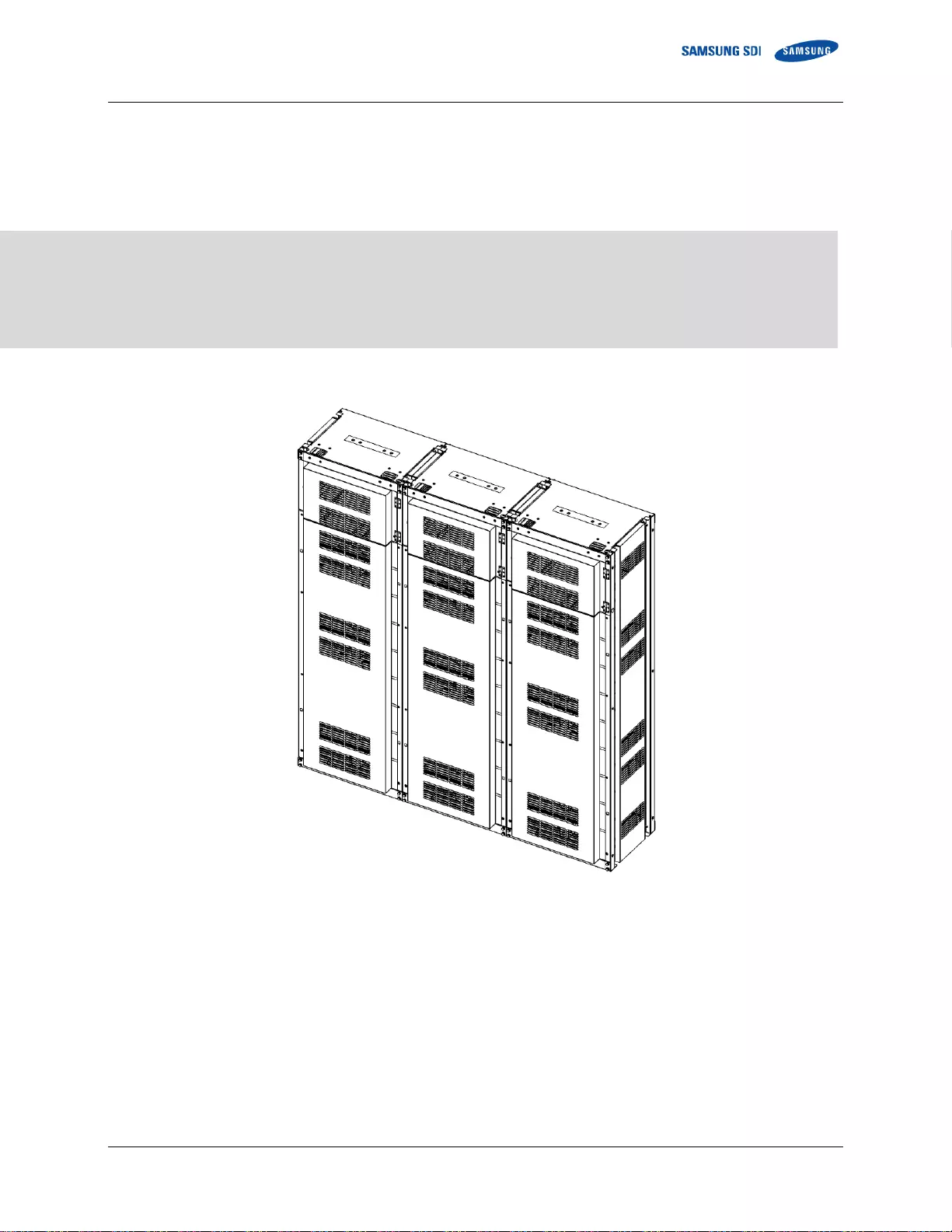
CONFIDENTIAL
English 8/2019. Rev 0.0
Lithium-ion Battery System for UPS
Operation and Maintenance Manual

CONFIDENTIAL
English 8/2019. Rev 0.0
Read this manual carefully before starting to install the battery system. Keep
these instructions for future reference.

CONFIDENTIAL
English 8/2019. Rev 0.0
Copyright © 2019 SAMSUNG SDI Co., Ltd. All rights reserved.
This document contains information that is the property of SAMSUNG SDI Co., Ltd., and provides for the sole
purpose of the installation, operation, and maintenance of products of SAMSUNG SDI Co., Ltd. No part of
this publication is to be used for any other purpose. It is not to be reproduced, copied, disclosed, transmitted,
stored in a retrieval system, or translated into any human or computer language in any form, by any means,
in whole or in part, without the prior written consent of SAMSUNG SDI Co., Ltd.
Although every possible effort has been made to ensure the accuracy of this document, SAMSUNG SDI Co.,
Ltd. assumes no responsibility for errors that may appear herein. The information is subject to change
without notice.

CONFIDENTIAL
English 8/2019. Rev 0.0
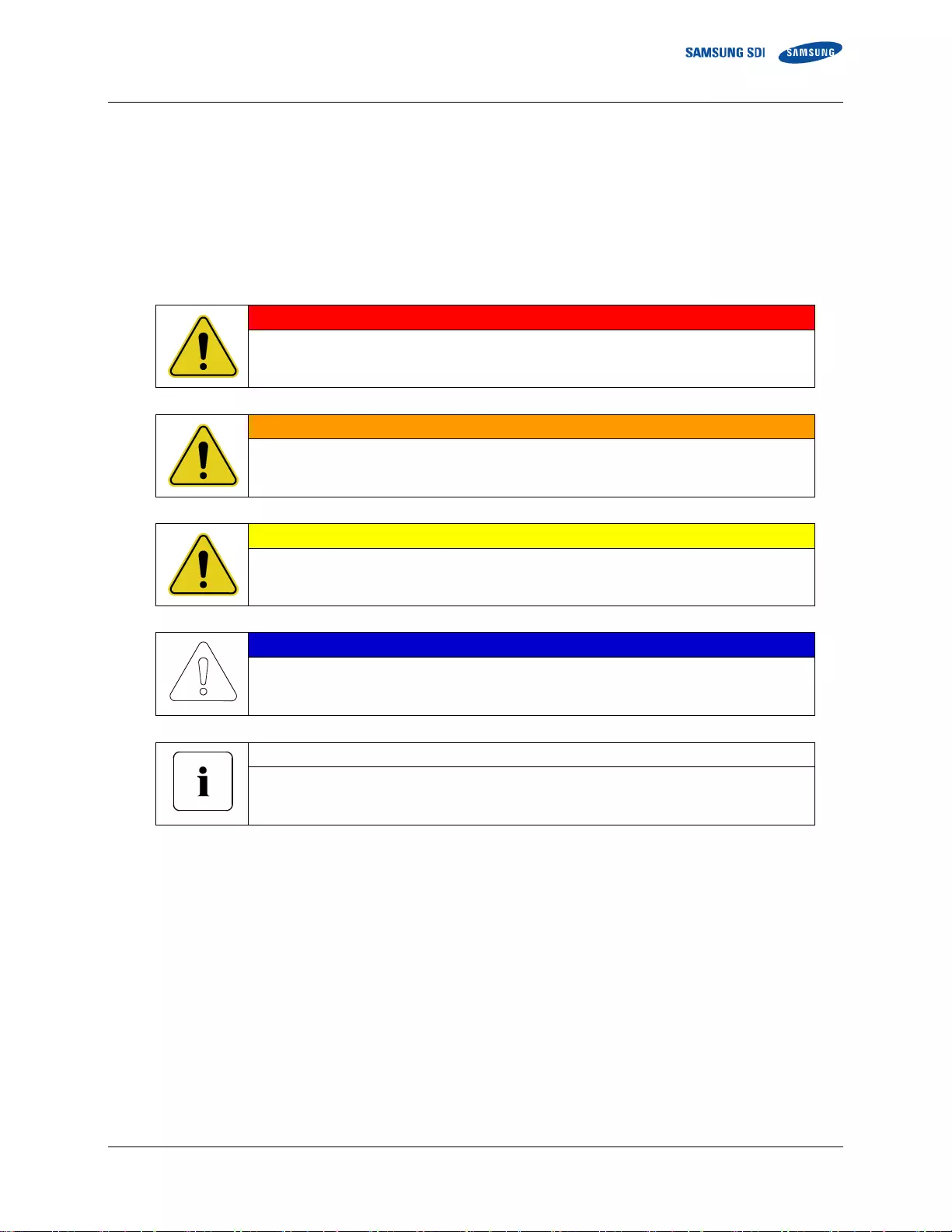
CONFIDENTIAL Important Safety Instructions
English 8/2019. Rev 0.0 i
Important Safety Instructions
Read and follow these instructions!
The following precautions are intended to ensure your safety and prevent property damage. Before installing
this product, be sure to read all safety instructions in this document.
DANGER
Failure to comply with the instructions with this symbol may result in a serious accident, causing
death or severe injury.
WARNING
Failure to comply with the instructions with this symbol may result in a serious accident, causing
severe injury.
CAUTION
Failure to comply with the instructions with this symbol may result in minor or moderate injury.
NOTICE
Provides information considered important but not hazard-related. The information relates to
property damage.
Important
Indicates valuable tips for optimal installation and operation of the product.

Important Safety Instructions CONFIDENTIAL
ii English 8/2019. Rev 0.0
General Instructions
Be aware that a battery presents a risk of electric shock including high short-circuit current. Follow all safety
precautions while operating the batteries.
Remove watches, rings, and other metallic items.
Use tools with insulated handles to avoid inadvertent short circuits.
Wear rubber gloves and safety boots.
Do not put tools or any metal parts on the top of the batteries.
Disconnect the charging source and load before connecting or disconnecting terminals.
Use proper lifting means when moving batteries and wear all appropriate safety clothing and equipment.
Batteries must be handled, transported and recycled or discarded in accordance with federal, state and local
regulations. Do not dispose of the batteries in a fire because they can explode.
Do not open or mutilate the batteries.
Only authorized, properly trained and qualified technicians should perform maintenance.
Only qualified personnel who are familiar with the batteries and safety precautions should installor maintain
the battery system.
Do not allow unauthorized personnel to contact the batteries.
Safety Precautions
The following precautions are general safety guidelines that should be followed when working with or near
the Energy Storage System (ESS). The user should develop complete, site-specific safety parameters and
procedures.
Review and refer to all safety warnings and cautions in this manual before installation.
Build a clear, permanent, restricted access area around the system.
Only authorized, properly trained electrical operators should be able to access the system.
The interior of this equipment must be considered a “no-go area except for qualified personnel who are
familiar with the batteries and safety precautions.” Consult local codes and applicable rules and regulations
to determine permit requirements. If required, mark enclosures appropriately before beginning work.
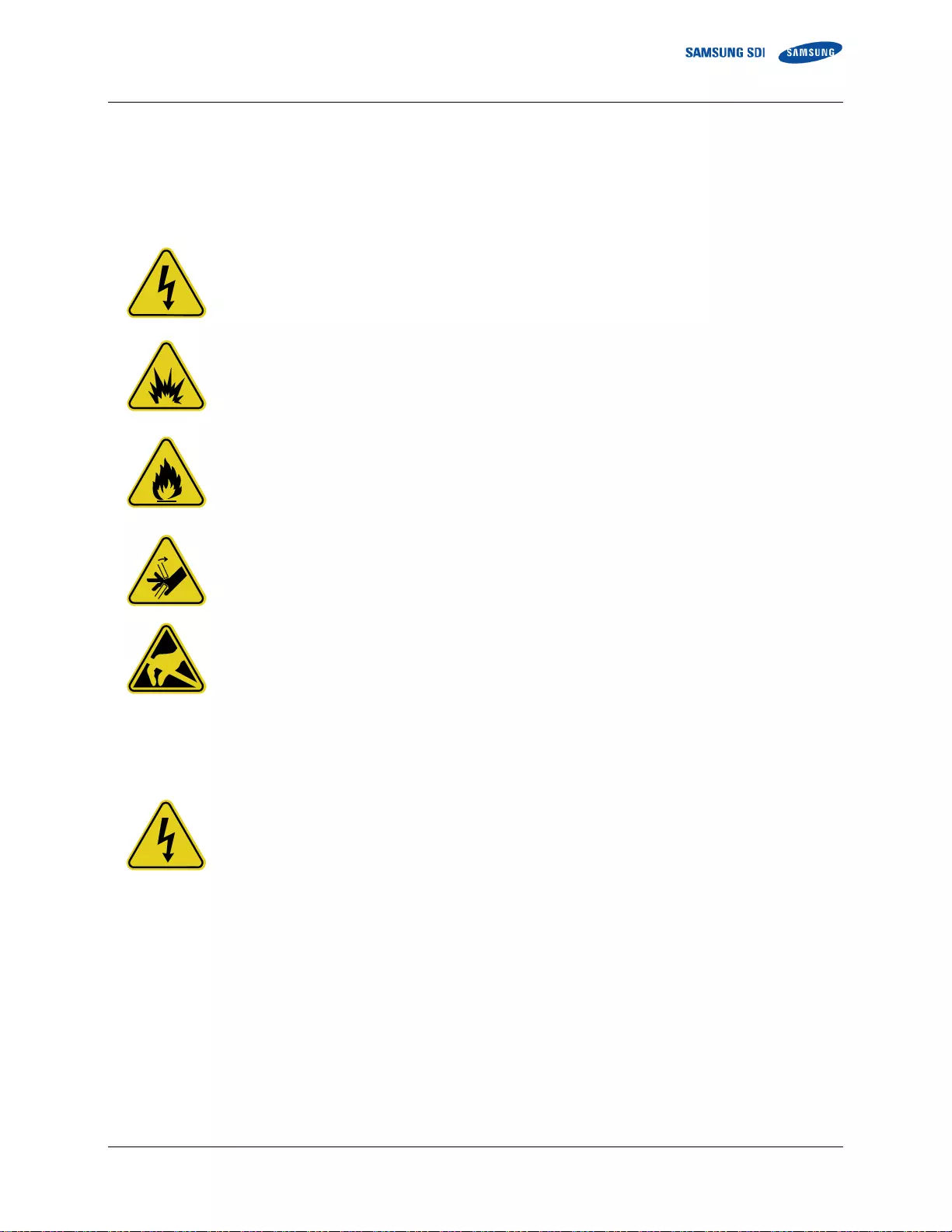
CONFIDENTIAL Important Safety Instructions
English 8/2019. Rev 0.0 iii
Personnel and Equipment Warnings
Personnel in contact with the battery system should be aware of the following hazards:
WARNING—SHOCK HAZARD
Do not contact system connectors or terminals. Do not open the enclosure doors unless proper lock out
and tag out procedures and related trainings are followed in accordance with local codes and regulations.
WARNING—ARC FLASH HAZARD
All electrical equipment presents an arc flash hazard. There is a serious risk of arc flash relating to any
equipment modification, such as opening doors. Serious injuries can occur in arc flash incidents.
Appropriate training is required in accordance with local codes and regulations.
WARNING—FIRE HAZARD
Certain faults may cause a fire.
In case of fire involving electrical equipment, use only carbon dioxide fire extinguishers or those approved
for use in fighting electrical fires
CAUTION—PINCH POINTS
Multiple pinch-points are present in most system components. Be aware that there is a serious risk of
injury while working around and in equipment enclosures.
CAUTION—STATIC SENSITIVE
Electronic devices can be damaged by electrostatic discharge. Proper handling procedures are required.
Be sure to wear a grounded anti-static wrist strap and to discharge static electricity by touching a
grounded surface near the equipment before touching any system components.
Dangerous Voltages
DANGER
The Energy Storage System (ESS) is powered by multiple power sources. Hazardous voltages may be
present in the equipment even when it does not appear operational. Make sure that you completely
understand the cautions and warnings in this manual. Failure to do so may result in serious injury or
death. Follow all manufacturer-published safety procedures.
Electrical equipment can present a risk of electrical shock and can cause arc flash. The following
precautions must be observed when working on or around electrical equipment:
Remove watches, jewelry, rings, and other metallic objects.
Use tools with insulated handles.
Safety clothing and shoes must comply with local codes and regulations.
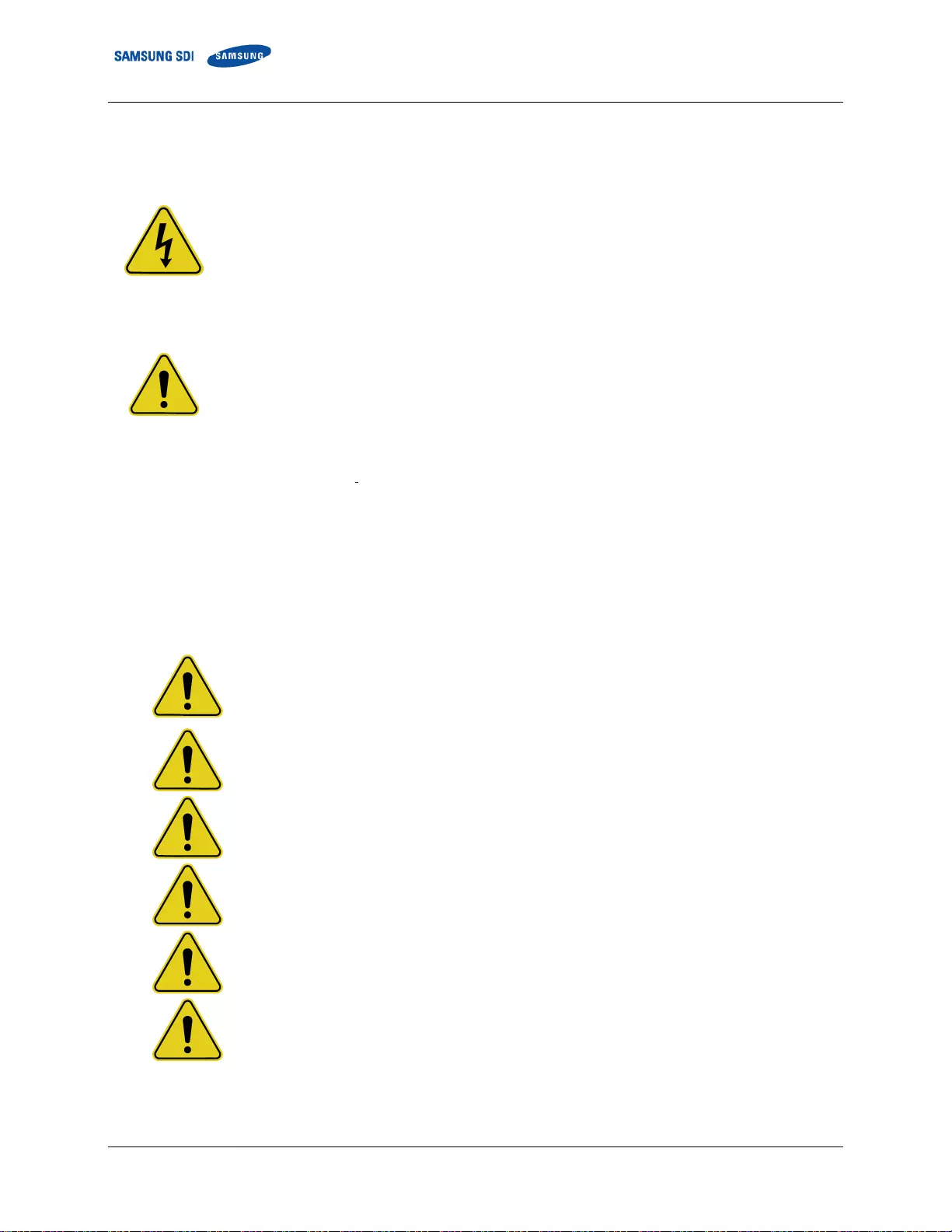
Important Safety Instructions CONFIDENTIAL
iv English 8/2019. Rev 0.0
Lock Out/Tag Out Guidelines
DANGER
Failure to follow all the applicable lock out/tag out (LOTO) procedures at all times may result in serious
injury or death.
With power applied to the ESS, hazardous voltages are present on some components. To prevent death or
injury, do not touch any components within the enclosure unless specifically directed to do so. To reduce
the risk of electrical shock, make sure that all equipment is properly grounded. For more information,
refer to the installation manual.
WARNING
Enclosure doors must remain closed except when access to the enclosure interior is required. Personnel
should keep a safe distance from enclosures whenever the equipment is energized. Always comply with
local, state, and national lock out/tag out guidelines when working with or near the ESS. The LOTO
procedures must meet or exceed the requirements of all guidelines presented in SAMSUNG SDI safety
documentation. Follow these steps before entering potentially hazardous areas or beginning work on the
ESS:
Wear protective clothing and shoes.
Identify and isolate all power and stored energy sources.
Apply appropriate LOTO devices. When applying LOTO to the ESS, do not touch anything within the enclosure except as
specifically directed in the work procedures.
Complete the site-specific LOTO procedure and safety checklist before beginning work.
General Warnings
DANGER
When energized, this equipment presents a hazard of electric shock, death, and injury. Only
authorized, properly trained personnel who are thoroughly familiar with the equipment and
should install, operate, or maintain this equipment.
DANGER
To avoid death, injury, and property damage, follow all safety procedures promulgated by
Environmental Health and Safety (EHS) guidelines.
DANGER
To minimize the hazards of electrical shock, death, and injury, approved grounding practices and
procedures must be strictly followed.
WARNING
To avoid injury and equipment damage, personnel must adhere to the site protocol concerning
working at heights.
WARNING
To avoid personal injury or equipment damage caused by equipment malfunction, only properly
and qualified trained personnel should modify any programmable machine.
WARNING
Always ensure that applicable standards and regulations are followed and only properly
certified equipment is used as a critical component of a safety system. Never assume
that a safety-critical control loop is functioning correctly.

CONFIDENTIAL Important Safety Instructions
English 8/2019. Rev 0.0 v


Table of Contents CONFIDENTIAL
English 8/2019. Rev 0.0 i
Table of Contents
Important Safety Instructions ....................................................................................................... i
General Instructions ......................................................................................................................................................ii
Safety Precautions .........................................................................................................................................................ii
Personnel and Equipment Warnings .......................................................................................................................... iii
Dangerous Voltages ..................................................................................................................................................... iii
Lock Out/Tag Out Guidelines ...................................................................................................................................... iv
General Warnings ........................................................................................................................................................ iv
Table of Contents ........................................................................................................................ i
Tables....................................................................................................................................... iii
Figures ..................................................................................................................................... iv
1. About this Manual ..................................................................................................................1
1.1 Purpose ............................................................................................................................................................... 1
1.2 Target Audience .................................................................................................................................................. 1
1.3 Organization ........................................................................................................................................................ 1
1.4 Revision History .................................................................................................................................................. 2
1.5 Acronyms and Abbreviations ............................................................................................................................. 3
2. Product Description ................................................................................................................4
2.1 Major Components ............................................................................................................................................ 4
2.1.1 Battery Module (Type A / Type B) ...................................................................................................... 5
2.1.2 SMU (String Management Unit) ........................................................................................................ 7
2.1.3 SMPS Assembly (Type A / Type B).................................................................................................... 10
2.1.4 Rack Frame ........................................................................................................................................ 15
3. Battery System Operation .................................................................................................... 16
3.1 Indicator LED ..................................................................................................................................................... 16
3.2 Dry Contact Signals ........................................................................................................................................... 18
3.3 Operation Status ............................................................................................................................................... 22
3.3.1 Normal Status .................................................................................................................................... 32
3.3.2 Minor Protection Status (Alarm) ...................................................................................................... 32
3.3.3 Major Protection Status (Fault) ........................................................................................................ 32
4. Maintenance Checks ............................................................................................................ 33
4.1 Daily Checks ...................................................................................................................................................... 33
4.2 Monthly Checks ................................................................................................................................................ 33
4.3 Annual Check .................................................................................................................................................... 33
4.4 Maintenance Checklist ..................................................................................................................................... 34
5. Troubleshooting, Repair and Replacement ............................................................................. 35
5.1 Troubleshooting ................................................................................................................................................ 38
5.1.1 Overvoltage Protection – Cell (Major Protection) .......................................................................... 38
5.1.2 Undervoltage Protection – Cell (Major Protection) ........................................................................ 38
5.1.3 Overvoltage Protection – Rack (Major Protection) ........................................................................ 39
5.1.4 Undervoltage Protection – Rack (Major Protection) ...................................................................... 39
5.1.5 Voltage Imbalance (Major Protection) ............................................................................................ 39
5.1.6 Voltage Sensing Error (Minor Protection) ....................................................................................... 40
5.1.7 Overtemperature Protection (Major Protection) ........................................................................... 40
5.1.8 Undertemperature Protection (Minor Protection) ......................................................................... 40
5.1.9 Temperature Imbalance (Major Protection) ................................................................................... 40
5.1.10 Overcurrent Protection (Charge) (Major Protection) ..................................................................... 41
5.1.11 Overcurrent Protection (Discharge) (Major Protection) ................................................................ 41
5.1.12 Communication Failure (Module ↔ Rack) (Major Protection) .................................................... 41
5.1.13 Communication Failure (Rack ↔ System) (Major Protection)...................................................... 41
5.1.14 Communication Failure (System BMS ↔ Monitoring Software) .................................................. 43
5.1.15 MCCB Failure (Minor Protection) ..................................................................................................... 43
5.1.16 MCCB Sensor Failure (Minor Protection) ........................................................................................ 43
5.1.17 Current Sensing Error (Minor Protection) ....................................................................................... 43
5.1.18 Fuse Failure (Minor Protection) ....................................................................................................... 44
5.1.19 BMS Power is Off............................................................................................................................... 44
5.1.20 MCCB Handle Cannot be Set to “On” .............................................................................................. 44
5.2 Repair Procedures ............................................................................................................................................ 45
5.2.1 Module BMS Connection Check ...................................................................................................... 45
5.2.2 SMU Connection Check .................................................................................................................... 47
5.2.3 SMPS Assembly Connection Check .................................................................................................. 49

CONFIDENTIAL Table of Contents
ii English 8/2019. Rev 0.0
5.2.4 Busbar Connection Check................................................................................................................. 53
5.2.5 Cell Voltage Balancing ....................................................................................................................... 54
5.2.6 System Reset ..................................................................................................................................... 55
5.2.7 MCCB Handle Control ....................................................................................................................... 55
5.3 Replacement Procedures ................................................................................................................................. 57
5.3.1 Wire Harness Replacement .............................................................................................................. 58
5.3.2 Battery Module Replacement .......................................................................................................... 64
5.3.3 Rack Fuse / Module Fuse Replacement .......................................................................................... 73
5.3.4 SMU Replacement ............................................................................................................................ 76
5.3.5 SMPS Assembly Replacement .......................................................................................................... 82
5.3.6 Module BMS Replacement ............................................................................................................... 92
6. Appendix ............................................................................................................................ 94
6.1 Disposal and Recycling ..................................................................................................................................... 94

Tables CONFIDENTIAL
English 8/2019. Rev 0.0 iii
Tables
Table 2-1: Extra Auxiliary Breaker Switch Connector Description ................................................................................ 8
Table 2-2: Terminal Block Description ........................................................................................................................ 9
Table 2-3: RS485 Connector Description .................................................................................................................. 12
Table 2-4: TCP/IP Connector Description ................................................................................................................. 12
Table 2-5: Dry Contact Connector Description ......................................................................................................... 13
Table 2-6: AC Terminal Description (3 phase) ........................................................................................................... 13
Table 2-7: AC Terminal Description (1 phase) ........................................................................................................... 13
Table 3-1: Indicator LED Status ................................................................................................................................ 16
Table 3-2: Indicated Codes ...................................................................................................................................... 17
Table 3-3: Dry Contact Connector Information......................................................................................................... 18
Table 3-4: Dry Contact Connector Description (Option 1. Customer ID = 0) ............................................................... 19
Table 3-5: Dry Contact Operation (Option 1. Customer ID = 0) ................................................................................. 19
Table 3-6: Dry Contact Connector Description (Option 2. Customer ID = 1) ............................................................... 20
Table 3-7: Dry Contact Operation (Option 2. Customer ID = 1) ................................................................................. 20
Table 8: Dry Contact Connector Description (Option 3. Customer ID = 2) .................................................................. 21
Table 9: Dry Contact Operation (Option 3. Customer ID = 2)..................................................................................... 21
Table 3-10: Range of Operation (136S Configuration)............................................................................................... 22
Table 3-11: Range of Operation (128S Configuration)............................................................................................... 23
Table 3-12: Range of Operation (112S Configuration)............................................................................................... 24
Table 3-13: Range of Operation (104S Configuration)............................................................................................... 25
Table 3-14: Range of Operation (80S Configuration) ................................................................................................ 26
Table 3-15. Protective Functions (136S Configuration) ............................................................................................. 27
Table 3-16. Protective Functions (128S Configuration) ............................................................................................. 28
Table 3-17. Protective Functions (112S Configuration) ............................................................................................. 29
Table 3-18. Protective Functions (104S Configuration) ............................................................................................. 30
Table 3-19. Protective Functions (80S Configuration) ............................................................................................... 31
Table 4-1: Maintenance Checklist Template............................................................................................................. 34
Table 5-1: Recommended Tools and Instruments for Repair and Replacement ......................................................... 35

CONFIDENTIAL Figures
iv English 8/2019. Rev 0.0
Figures
Figure 2-1: Battery Module Type A ............................................................................................................................ 5
Figure 2-2: Battery Module Type B ............................................................................................................................ 6
Figure 2-3: SMU ........................................................................................................................................................ 7
Figure 2-4: Auxiliary Breaker Switch .......................................................................................................................... 8
Figure 2-5: Terminal Block Isometric View ................................................................................................................. 8
Figure 2-6: Terminal Block Front / Top View (Cover Opened/Closed) .......................................................................... 9
Figure 2-7: SMPS Assembly ..................................................................................................................................... 10
Figure 2-8: Front View of SMPS Assembly Type A, 3-Phase Input .............................................................................. 11
Figure 2-9: Front View of SMPS Assembly Type A, 1-Phase Input .............................................................................. 11
Figure 2-10: SMPS Assembly Type A – System BMS Connections .............................................................................. 11
Figure 2-11: Front View of SMPS Assembly Type B, 1-Phase Input ............................................................................ 11
Figure 2-12: Rack Frame .......................................................................................................................................... 15
Figure 3-1: Dry Contact Connector Pinout ................................................................................................................ 18
Figure 5-1. System BMS LED .................................................................................................................................... 42
Figure 5-2: Signal Connectors .................................................................................................................................. 45
Figure 5-3: Removing the Battery Module Front Cover............................................................................................. 46
Figure 5-4: Voltage and Temperature Sensing Connectors ....................................................................................... 46
Figure 5-5: DC Power Cables from SMPS Assembly Type A to SMU ........................................................................... 47
Figure 5-6: DC Power Cables from SMPS Assembly Type B to SMU ........................................................................... 47
Figure 5-7: CAN Signal Cable Connection from SMPS Assembly to SMU .................................................................... 48
Figure 5-8: Signal Cabling Examples of Left Alignment of SMUs ................................................................................ 48
Figure 5-9: Termination resistor setting ................................................................................................................... 49
Figure 5-10: DC Power Cables from SMPS Assembly Type A to SMU ......................................................................... 49
Figure 5-11: DC Power Cables from SMPS Assembly Type B to SMU ......................................................................... 50
Figure 5-12: CAN Signal Cable Connection from SMPS Assembly to SMU .................................................................. 50
Figure 5-13: Dry Contact Cable Connection to SMPS Assembly ................................................................................. 50
Figure 5-14: AC Input Terminals .............................................................................................................................. 51
Figure 5-15: AC Input Terminals with Cables Attached ............................................................................................. 51
Figure 5-16: AC Input Terminals Protective Covers ................................................................................................... 52
Figure 5-17: Remove the front covers ...................................................................................................................... 53
Figure 5-18: Reattach the Front Covers.................................................................................................................... 54
Figure 5-19: Pressing the Reset Button .................................................................................................................... 55
Figure 5-20: MCCB Handle in Trip Position ............................................................................................................... 56
Figure 5-21: MCCB Handle in Off Position ................................................................................................................ 56
Figure 5-22: MCCB Handle in On Position ................................................................................................................ 56
Figure 5-23: Remove SMU to Module #1 Right Connector ........................................................................................ 58
Figure 5-24: Install Signal Cable Between the SMU and Battery Module #1 Right Connector ..................................... 59
Figure 5-25: Remove Module to Module Signal Cable .............................................................................................. 59
Figure 5-26: Install Module to Module Signal Cable.................................................................................................. 60
Figure 5-27: CAN Wire Harness Between SMU Assemblies ....................................................................................... 60
Figure 5-28: CAN Cable Connection from SMPS Assembly to SMU ............................................................................ 61
Figure 5-29: MCCB Handle in “OFF” position ............................................................................................................ 62
Figure 5-30: DC Power Cables from SMPS Assembly Type A to SMU ......................................................................... 62
Figure 5-31: DC Power Cables from SMPS Assembly Type B to SMU ......................................................................... 62
Figure 5-32: MCCB Handle in “ON” Position ............................................................................................................. 63
Figure 5-33: Removing the Battery Module Front Cover ........................................................................................... 65
Figure 5-34: Battery Module Type A ........................................................................................................................ 65
Figure 5-35: Battery Module Type B ........................................................................................................................ 66
Figure 5-36: MCCB Handle in “OFF” Position ............................................................................................................ 66
Figure 5-37: Remove Battery Module Front Covers .................................................................................................. 66
Figure 5-38: Measuring Each Battery Module’s Voltage ........................................................................................... 67
Figure 5-39: Assemble Battery Module Front Covers ................................................................................................ 67
Figure 5-40: DC Power Supply and Battery Module Connection ................................................................................ 68
Figure 5-41: Battery Module Signal Cables ............................................................................................................... 69

Figures CONFIDENTIAL
English 8/2019. Rev 0.0 v
Figure 5-42: Remove Battery Module Front Covers .................................................................................................. 69
Figure 5-43: Busbars on Positive and Negative Terminals ......................................................................................... 69
Figure 5-44: Hook and slots on the rack frame ......................................................................................................... 70
Figure 5-45: Inserting the Replacement Battery Module .......................................................................................... 71
Figure 5-46: Removing the Front Covers .................................................................................................................. 71
Figure 5-47: Busbars ............................................................................................................................................... 71
Figure 5-48: Reattaching the Front Cover to the Battery Module .............................................................................. 72
Figure 5-49: Connecting the Signal Cables................................................................................................................ 72
Figure 5-50: MCCB Handle in “ON” Position ............................................................................................................. 72
Figure 5-51: MCCB Handle in “OFF” Position ............................................................................................................ 73
Figure 5-52: Remove the Battery Module Front Covers ............................................................................................ 74
Figure 5-53: MCCB Handle in “ON” Position ............................................................................................................. 74
Figure 5-54: MCCB Handle in “OFF” Position ............................................................................................................ 76
Figure 5-55: DC IN Cable ......................................................................................................................................... 76
Figure 5-56: CAN Cable to SMPS Assembly............................................................................................................... 76
Figure 5-57: CAN Cable to Adjacent Rack ................................................................................................................. 77
Figure 5-58: Module Signal Cable ............................................................................................................................ 77
Figure 5-59: SMU Terminal Covers .......................................................................................................................... 77
Figure 5-60: P+, P- Terminals ................................................................................................................................... 78
Figure 5-61: B+, B-, P+, P- Terminal Connections and Terminal Covers ...................................................................... 79
Figure 5-62: SMU to Module Signal Cable ................................................................................................................ 79
Figure 5-63: SMU to SMPS Assembly CAN Signal Cable............................................................................................. 80
Figure 5-64: DC Power Cables from SMPS Assembly Type A to SMU ......................................................................... 80
Figure 5-65: DC Power Cables from SMPS Assembly Type B to SMU ......................................................................... 80
Figure 5-66: MCCB Handle in “ON” Position ............................................................................................................. 81
Figure 5-67: MCCB Handle in “OFF” Position ............................................................................................................ 82
Figure 5-68: AC Input Terminals .............................................................................................................................. 82
Figure 5-69: Cables to the AC Input Terminals.......................................................................................................... 83
Figure 5-70: DC OUT Connection ............................................................................................................................. 83
Figure 5-71: BMS CAN Connection ........................................................................................................................... 83
Figure 5-72: TCP/IP Connection ............................................................................................................................... 85
Figure 5-73: Dry Contact Connection ....................................................................................................................... 85
Figure 5-74: Unscrew SMPS Assembly ..................................................................................................................... 85
Figure 5-75: Unscrew SMPS Assembly Grounding Cable ........................................................................................... 86
Figure 5-76: Remove the SMPS Assembly ................................................................................................................ 86
Figure 5-77: Insert the SMPS Assembly .................................................................................................................... 86
Figure 5-78: Screw on the SMPS Assembly ............................................................................................................... 87
Figure 5-79: Screw on the SMPS Assembly Grounding Cable .................................................................................... 87
Figure 5-80: DC Power Cables from SMPS Assembly Type A to SMU ......................................................................... 88
Figure 5-81: DC Power Cables from SMPS Assembly Type B to SMU ......................................................................... 88
Figure 5-82: BMS CAN Cable from SMPS Assembly to SMU ...................................................................................... 89
Figure 5-83: TCP/IP Cable ........................................................................................................................................ 89
Figure 5-84: Dry Contact Cable ................................................................................................................................ 89
Figure 5-85: AC Input Terminals .............................................................................................................................. 90
Figure 5-86: AC Input Terminals with Cables Attached ............................................................................................. 90
Figure 5-87: AC Input Terminals Protective Cover .................................................................................................... 91
Figure 5-88: MCCB Handle in “ON” Position ............................................................................................................. 91


CONFIDENTIAL 1. About this Manual
English 8/2019. Rev 0.0 1
1. About this Manual
This section briefly describes the purpose, audience, organization, revision history, and acronyms and
abbreviations used in this document.
1.1 Purpose
The purpose of this manual is to provide information for the safe and successful operation and maintenance
of the product.
1.2 Target Audience
This manual is intended for system administrators and operators who install, operate, maintenance and
configure the product.
1.3 Organization
This manual is composed of the following chapters:
Chapter 1, “About this Manual” introduces preliminary description about this document.
Chapter 2, “Product Description” describes the major components of the product.
Chapter 3, “Battery System Operation” explains the operation modes of the battery system.
Chapter 4, “Maintenance Check” lists items to inspect daily, monthly, and annually.
Chapter 5, “Troubleshooting” guides the reader through clearing protection modes and replacing
components.
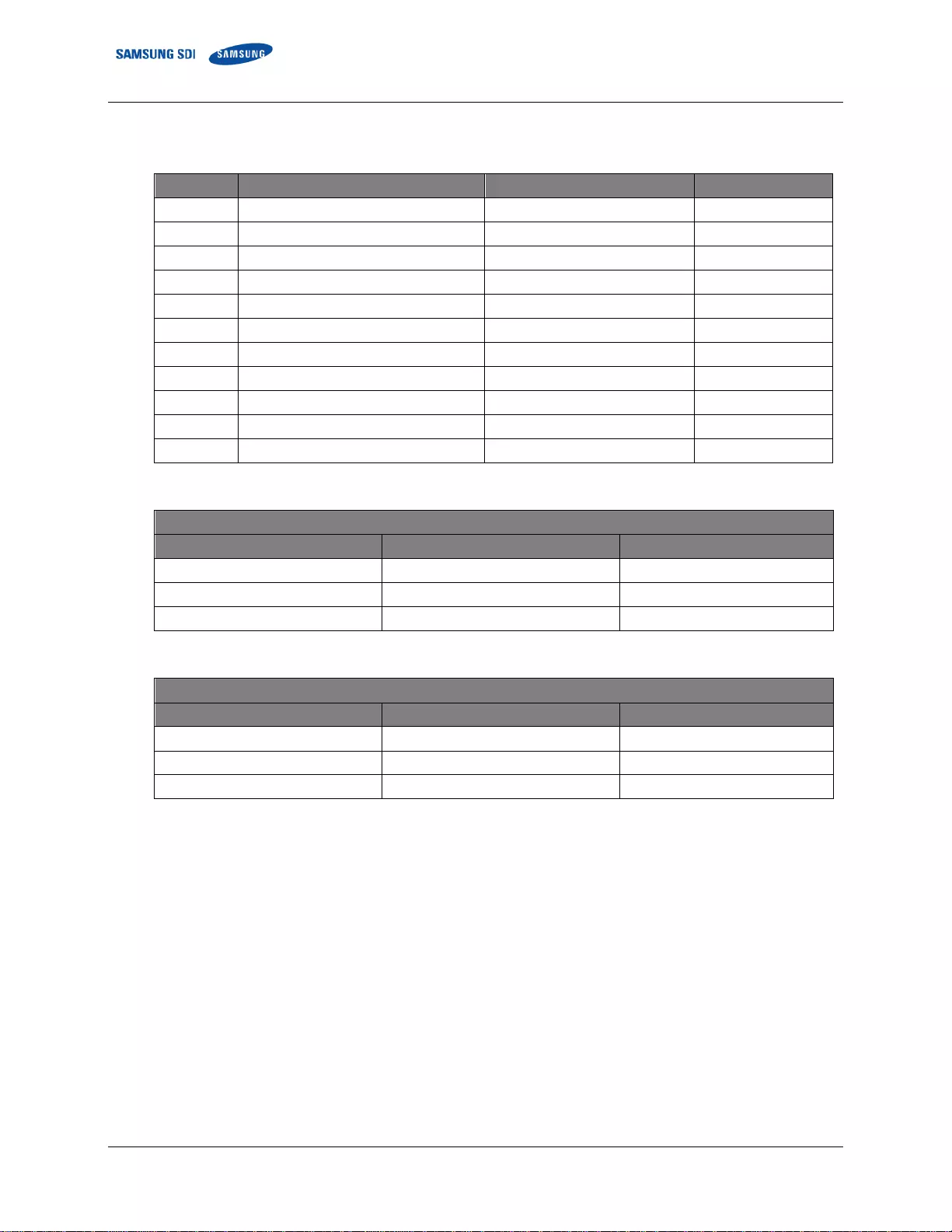
1. About this Manual CONFIDENTIAL
2 English 8/2019. Rev 0.0
1.4 Revision History
Rev.
Description
Author
Date
0.0
First Draft (tentative release)
2019.08.20
Approved By:
Name
Signature
Date
Trusted Reviewers
Name
Signature
Date
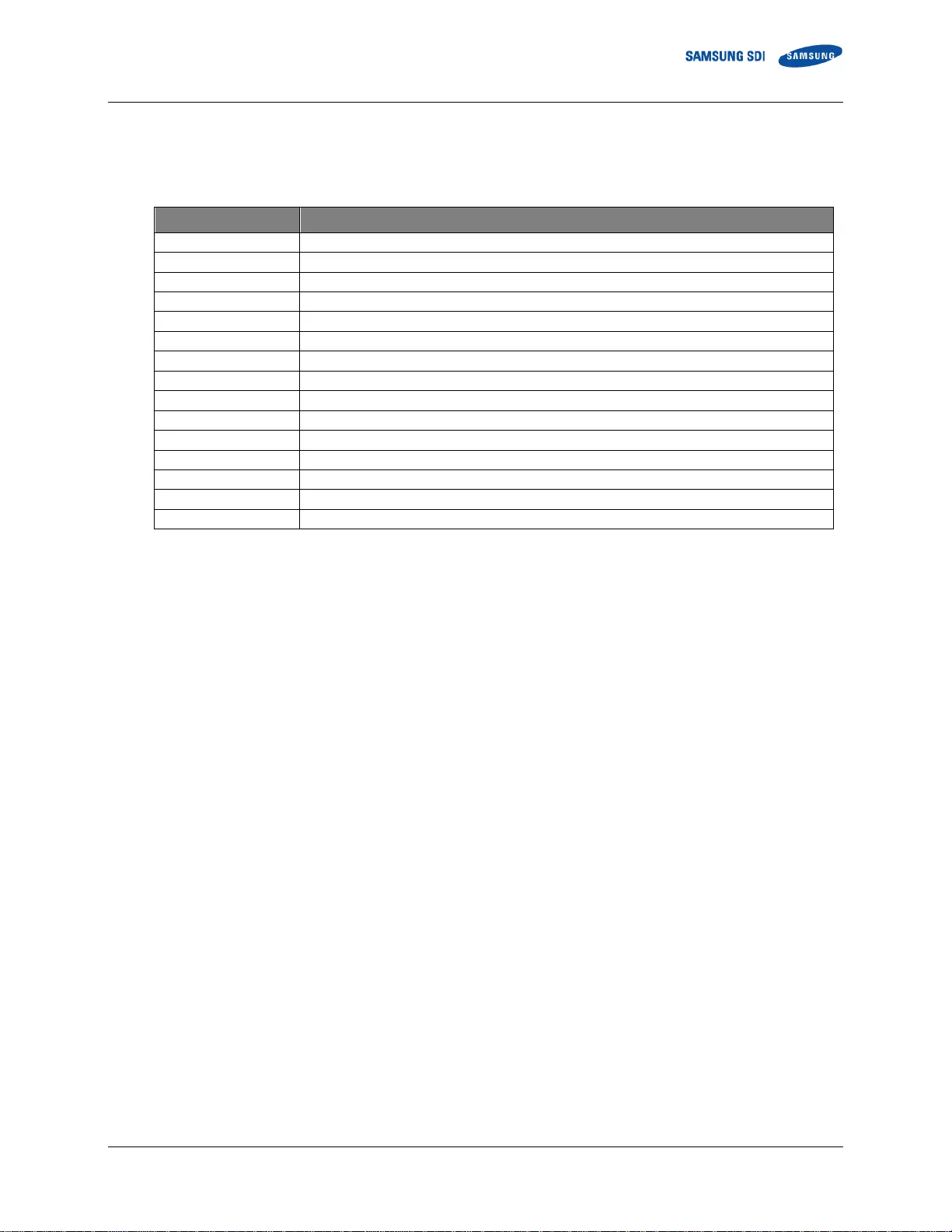
CONFIDENTIAL 1. About this Manual
English 8/2019. Rev 0.0 3
1.5 Acronyms and Abbreviations
The following acronyms and abbreviations are used in this manual.
Abbreviations
Full Name
AED
Automated External Defibrillator
BMS
Battery Management System
Comm.
Communication
EHS
Environmental Health and Safety
ESS
Energy Storage System
LOTO
LOCK OUT/TAG OUT
OT
Overtemperature
OVP
Overvoltage Protection
SMPS
Switched Mode Power Supply
SMU
String Management Unit
SOC
State Of Charge
SOH
State Of Health
UT
Undertemperature
UVP
Undervoltage Protection
UPS
Uninterruptible Power Supply

2. Product Description CONFIDENTIAL
4 English 8/2019. Rev 0.0
2. Product Description
Before operating the battery system, users must be familiar with its components.
2.1 Major Components
Samsung SDI’s Lithium Ion Battery System has the following components:
Battery Module (Type A / Type B)
SMU
Rack BMS (Embedded in SMU)
Rack Frame
SMPS Assembly (Type A / Type B)
System BMS (Embedded in SMPS Assembly Type A)
Refer to the “Product Specification” document for detailed specifications of the components.
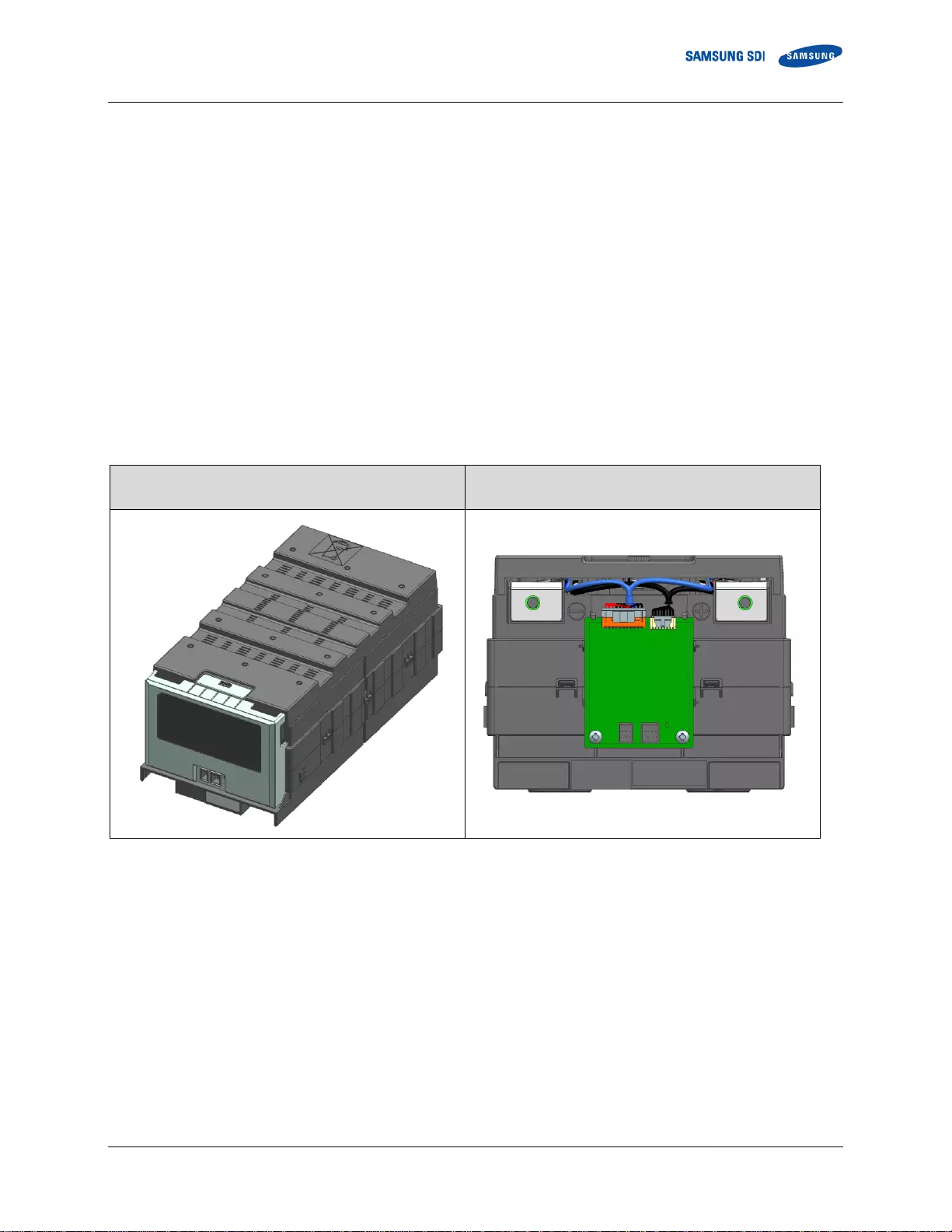
CONFIDENTIAL 2. Product Description
English 8/2019. Rev 0.0 5
2.1.1 Battery Module (Type A / Type B)
Battery Module is the most basic component of the Battery System and it contains the energy storing battery cells.
There is a Module BMS inside each Battery Module. Module BMS checks the status of a Battery Module by
measuring its voltage and temperature. It also communicates with the SMU to send all measured voltage and
temperature data, and to receive commands to control cell balancing.
There are two types of 8S1P Battery Module depending on the position of terminal’s polarity.
Type A’s plus(+) terminal is on the right side. Type B is on the left.
Type A: EM2031AE00XA (X = 1, 3)
X = 1 for specific customer (customer SKU serial number barcode + SDI serial number barcode)
X = 3 for general customer (SDI serial number barcode only)
Type B: EM2031AE00YA (Y = 2, 4)
Y = 2 for specific customer (customer SKU serial number barcode + SDI serial number barcode)
Y = 4 for general customer (SDI serial number barcode only)
Battery Module Type A (Isometric)
Battery Module Type A
(Front. Front cover removed)
Figure 2-1: Battery Module Type A
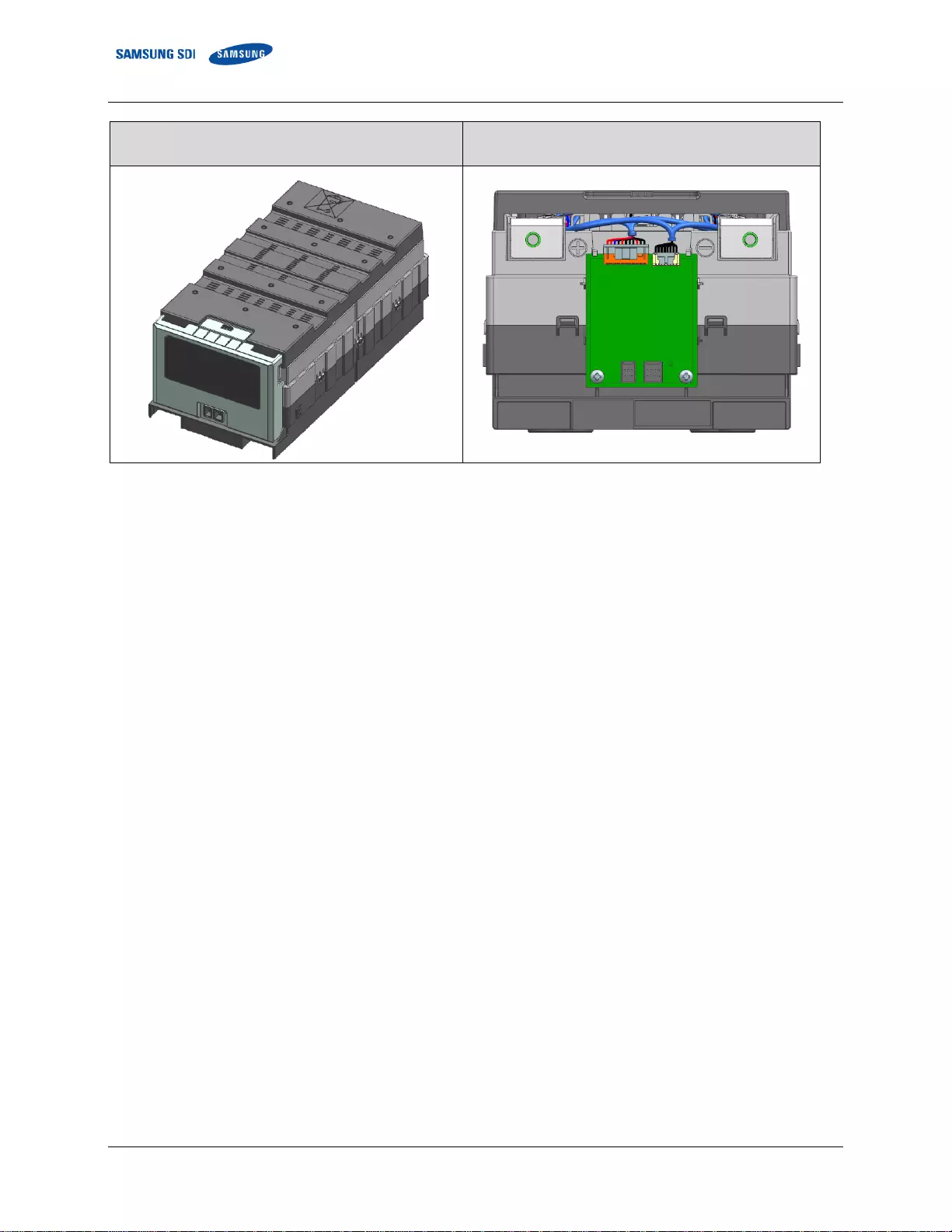
2. Product Description CONFIDENTIAL
6 English 8/2019. Rev 0.0
Battery Module Type B (Isometric)
Battery Module Type B
(Front. Front cover removed)
Figure 2-2: Battery Module Type B
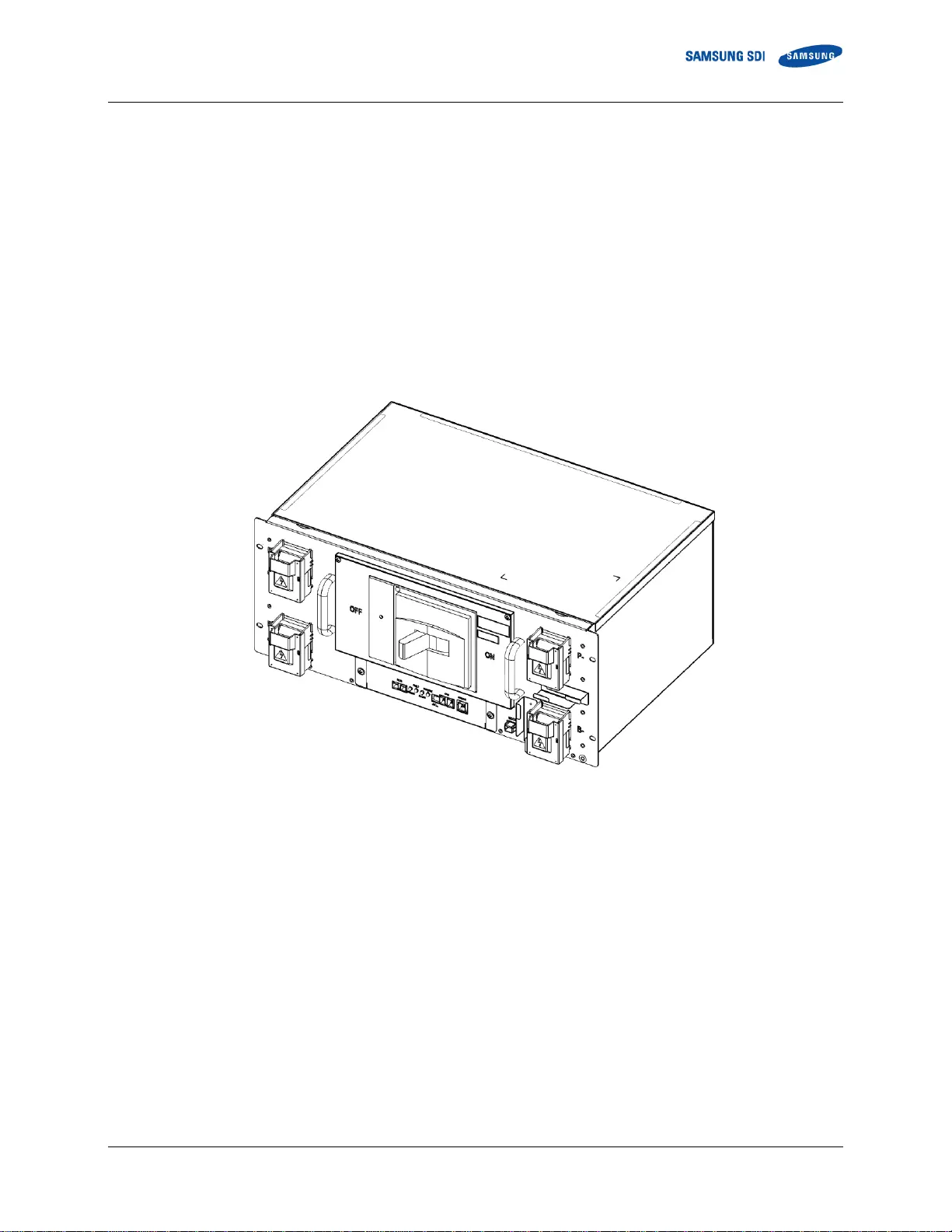
CONFIDENTIAL 2. Product Description
English 8/2019. Rev 0.0 7
2.1.2 SMU (String Management Unit)
SMU collects all information about the battery system and controls the battery system by switching the main
power line and controls each Battery Module by cell balancing. SMU calculates the state-of-charge (SOC) and state-
of-health (SOH) of the battery system. Key components in the SMU are Rack BMS, MCCB, and shunt resistor. Rack
BMS is the main controller that takes all data from the Module BMS, measures the string voltage and current,
determines the state of the battery and controls the MCCB accordingly.
UL: V049-0011XA (X = A, B)
CE: V049-0012XA (X = A, B)
X = A for general customer (SDI serial number barcode only)
X = B for specific customer (customer SKU serial number barcode + SDI serial number barcode)
Figure 2-3: SMU
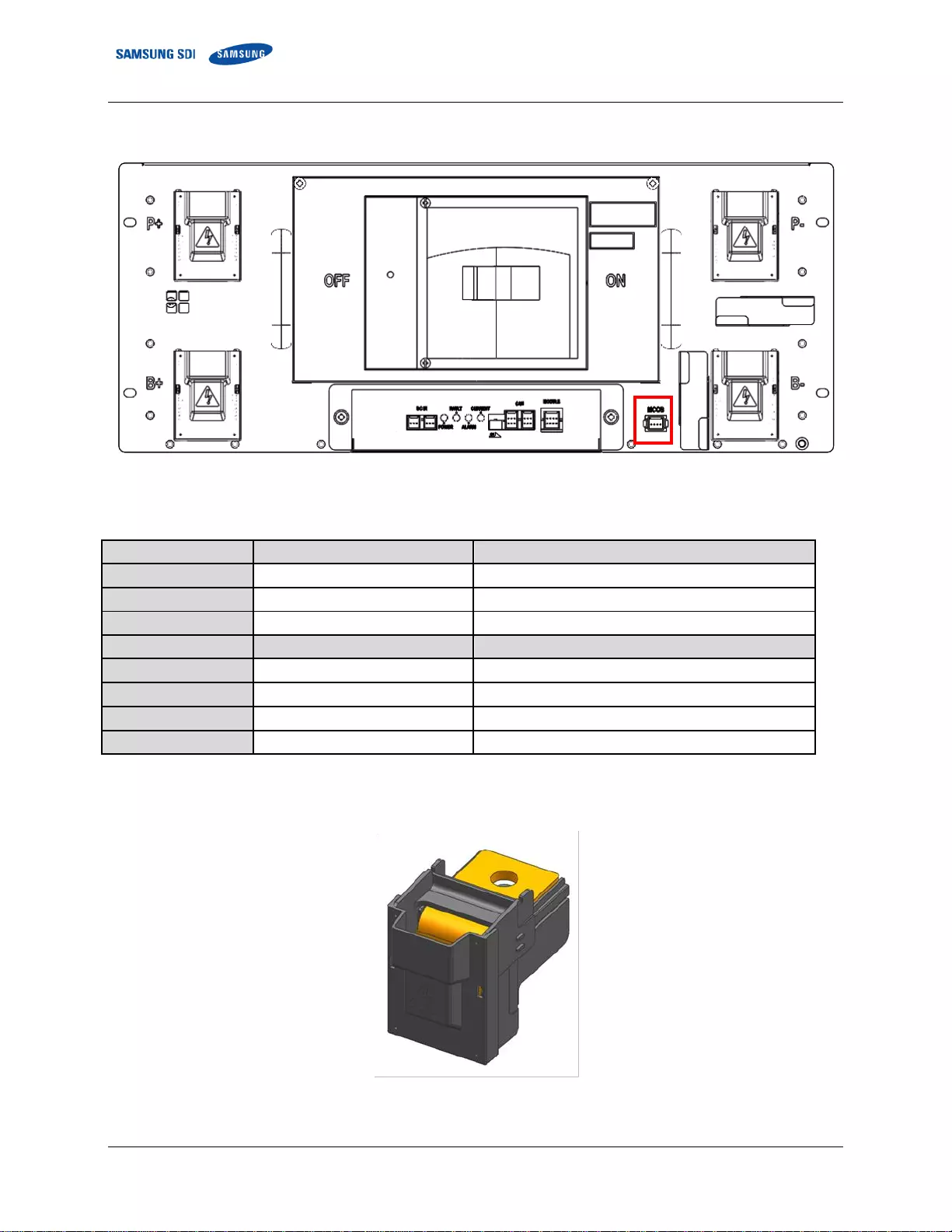
2. Product Description CONFIDENTIAL
8 English 8/2019. Rev 0.0
SMU provides an auxiliary breaker switch that can be connected to the building monitoring system.
Figure 2-4: Auxiliary Breaker Switch
Table 2-1: Extra Auxiliary Breaker Switch Connector Description
Item
Part Name
Description
Connector
J21SPM-04V-KX
-
Harness Housing
J21SF-04V-KX-L
-
Harness Terminal
SJ2F-01GF-P1.0
AWG 20~24
Pin No.
Pin Name
Function
1
Normal Open
2
Common
3
Normal Close
4
-
P+ and P- terminal blocks connect to the DC link from the UPS. Cable and lug terminals should be selected
according to the terminal block’s size and material.
Figure 2-5: Terminal Block Isometric View
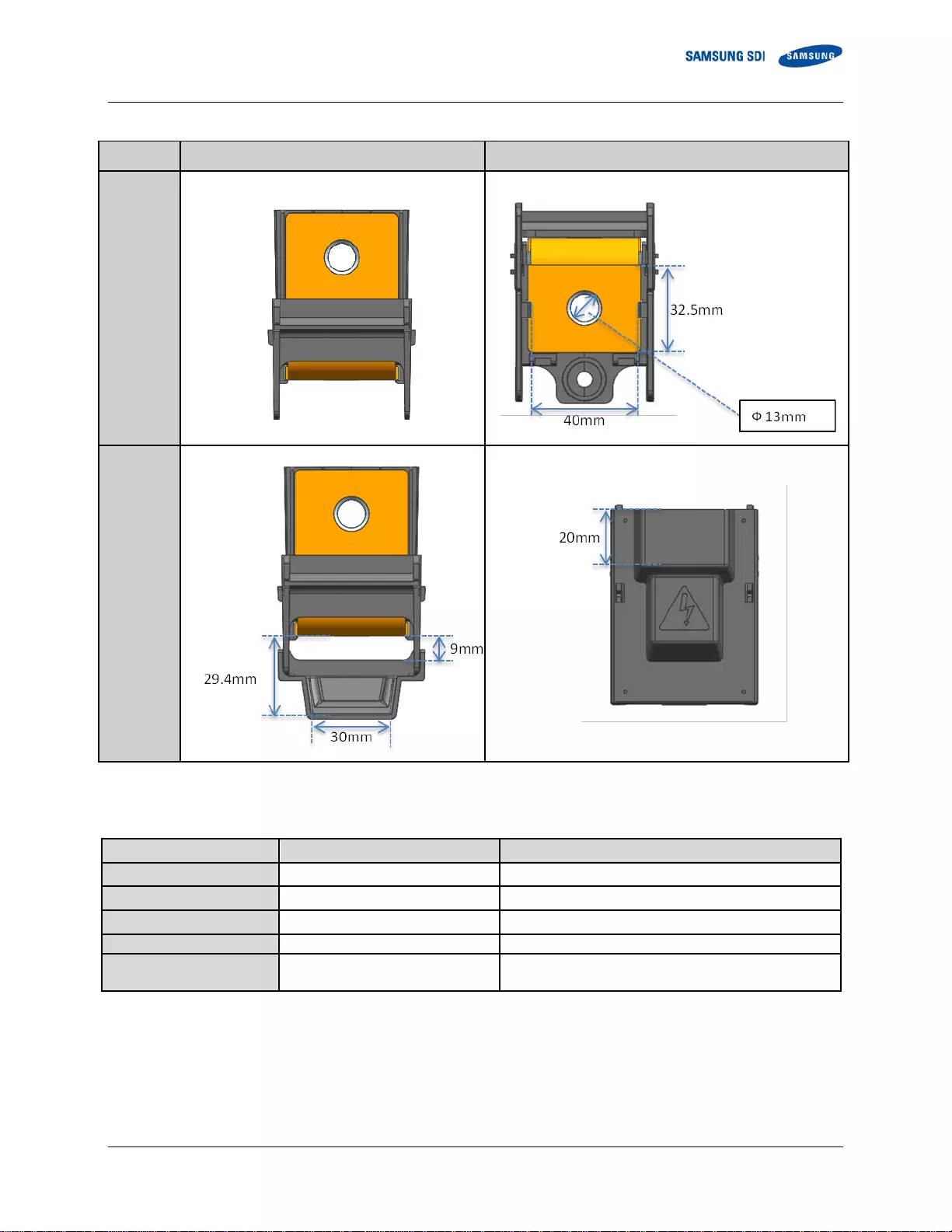
CONFIDENTIAL 2. Product Description
English 8/2019. Rev 0.0 9
Top View
Front View
COVER
OPEN
COVER
CLOSED
Figure 2-6: Terminal Block Front / Top View (Cover Opened/Closed)
Table 2-2: Terminal Block Description
Item
Detail
Description
Conducting Material
Cu
C1100
Insulating Material (Guide)
PA66
GF25%
Insulating Material (Cover)
PC
Conductive Area
32.5mm x 40.0mm
Rated Current
473A
Calculated in accordance with
DIN 43670 MELSON & BOTH equation
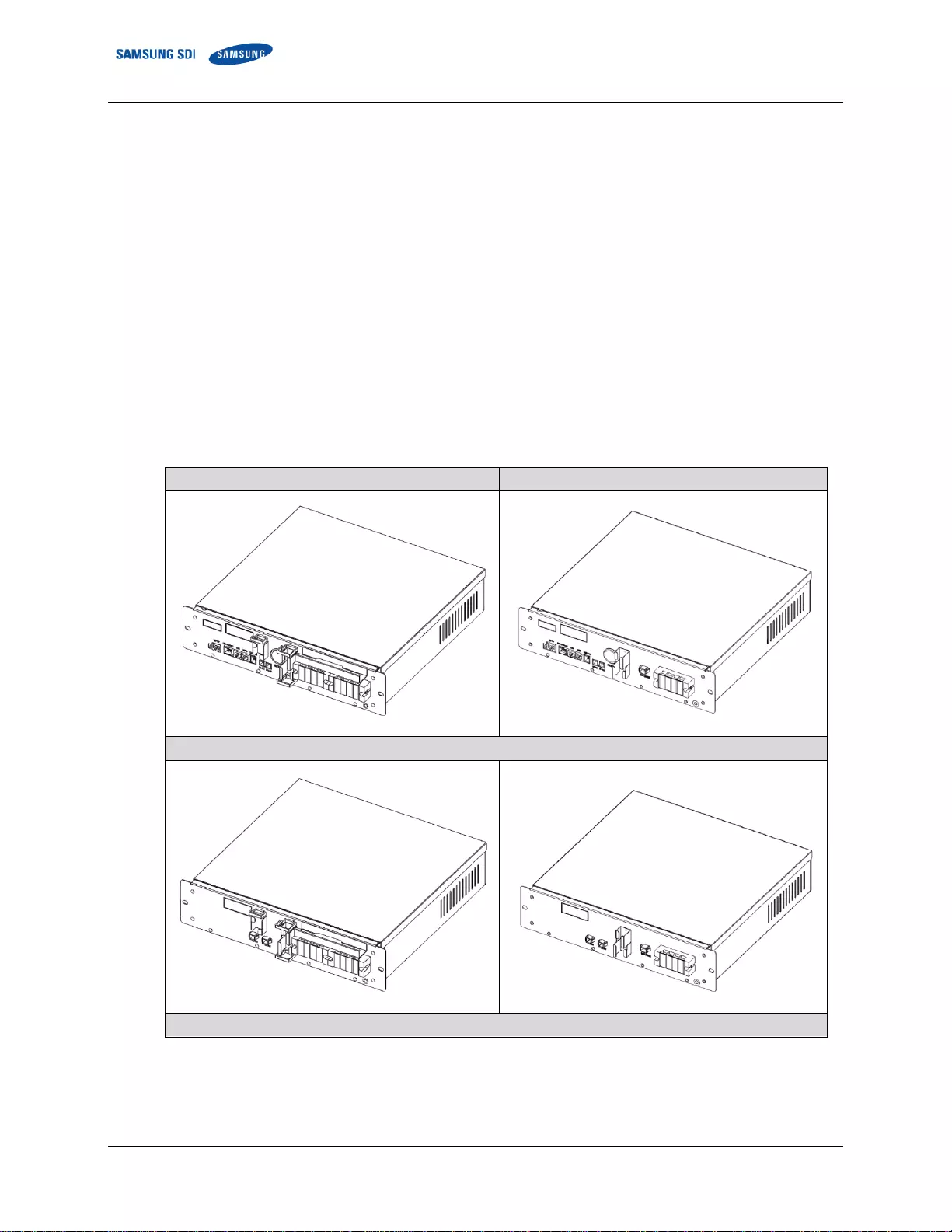
2. Product Description CONFIDENTIAL
10 English 8/2019. Rev 0.0
2.1.3 SMPS Assembly (Type A / Type B)
3-Phase Type A (with System BMS): V044-0006XA
X = A (for general customer)
X = B (for specific customer)
3-Phase Type B (without System BMS): SJ94-00238B (for general customer)
1-Phase Type A (with System BMS): V044-0004XA
X = A (for general customer)
X = B (for specific customer)
1-Phase Type B (without System BMS): V044-0005AA (for general customer)
SMPS Assembly houses the System BMS and SMPS, which provides power to the System BMS and SMU. Two
options are available for the SMPS depending on the AC input range and cabling: 3 phase and 1 phase. The System
BMS assembly provides data to the external systems (i.e. building management system, UPS, etc.) while controlling
and monitoring all connected Rack BMS.
There are two types of SMPS Assembly: Type A is with System BMS and Type B is without System BMS.
SMPS Assembly with 3 Phase AC Input
SMPS Assembly with 1 Phase AC Input
Type A (with System BMS)
Type B (without System BMS)
Figure 2-7: SMPS Assembly
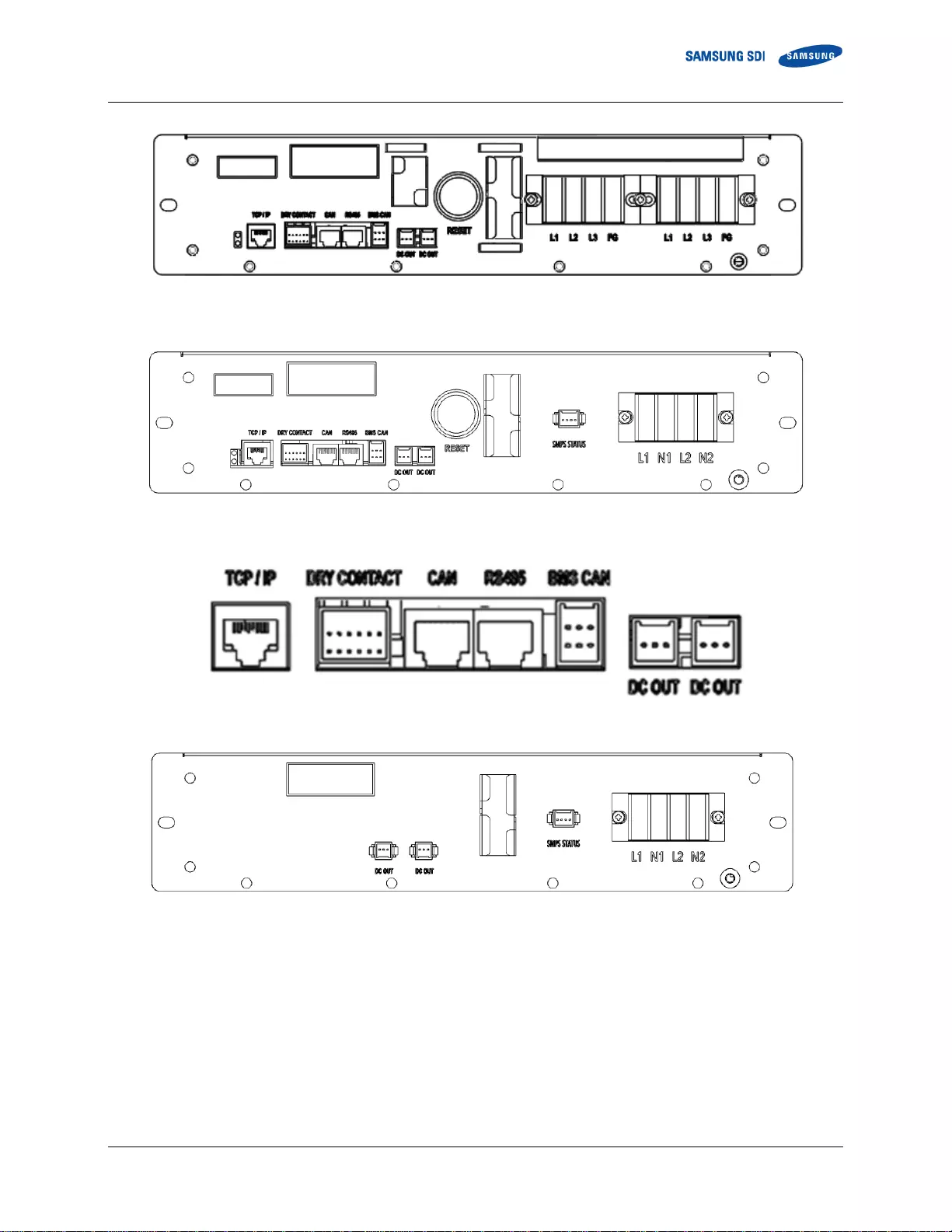
CONFIDENTIAL 2. Product Description
English 8/2019. Rev 0.0 11
Figure 2-8: Front View of SMPS Assembly Type A, 3-Phase Input
Figure 2-9: Front View of SMPS Assembly Type A, 1-Phase Input
Figure 2-10: SMPS Assembly Type A – System BMS Connections
Figure 2-11: Front View of SMPS Assembly Type B, 1-Phase Input

2. Product Description CONFIDENTIAL
12 English 8/2019. Rev 0.0
SMPS Assembly Type A provides RS485, TCP/IP and Dry contact.
Table 2-3: RS485 Connector Description
Item
Part Name
Description
Connector
IM25G-008-256
2 Port, RJ45
Harness Housing
RJ45
-
Harness Terminal
RJ45
-
Pin No.
Pin Name
Function
Left. 1
CAN port
For debugging purpose only
Left. 2
Left. 3
Left. 4
Left. 5
Left. 6
Left. 7
Left. 8
Right. 1
RS485 A
Rx+ (Short to Tx+ externally)
Right. 2
RS485 B
Rx- (Short to Rx- externally)
Right. 3
RS485 Z
Tx- (Short to Rx- externally)
Right. 4
-
Right. 5
-
Right. 6
RS485 Y
Tx+
Right. 7
-
Right. 8
GND
Table 2-4: TCP/IP Connector Description
Item
Part Name
Description
Connector
VS-08-BU-RJ45/LP-1
PHOENIX CONTACT
Harness Housing
RJ45
-
Harness Terminal
RJ45
-
Pin No.
Pin Name
Function
1
TX+
TCP/IP TX+
2
TX-
TCP/IP TX-
3
RX+
TCP/IP RX+
4
GND
GND
5
GND
GND
6
RX-
TCP/IP RX-
7
GND
GND
8
GND
GND

CONFIDENTIAL 2. Product Description
English 8/2019. Rev 0.0 13
Table 2-5: Dry Contact Connector Description
Item
Part Name
Description
Connector
S12B-J11DK-TXR
JST
Harness Housing
J11DF-12V-KX
-
Harness Terminal
SF1F-21T-P0.6
AWG 18~22
Pin No.
Pin Name
Function
1A
DRY CONTACT 0 NC
Refer to the product specification.
2A
DRY CONTACT 1 COM
3A
DRY CONTACT 1 NO
4A
DRY CONTACT 2 NC
5A
-
6A
DRY CONTACT IN- (GND)
1B
DRY CONTACT 0 COM
2B
DRY CONTACT 0 NO
3B
DRY CONTACT 1 NC
4B
DRY CONTACT 2 COM
5B
DRY CONTACT 2 NO
6B
DRY CONTACT IN+
Table 2-6: AC Terminal Description (3 phase)
Item
Part Name
Description
Terminal Block
SL3T-4P
Seoil Electronics
Terminals
Ring terminal
320 ~ 575VAC, 6A
Pin No.
Pin Name
Function
1
L1
3 phase AC, L1
2
L2
3 phase AC, L2
3
L3
3 phase AC, L3
4
PE
-
Table 2-7: AC Terminal Description (1 phase)
Item
Part Name
Description
Terminal Block
SL3T-4P
Seoil Electronics
Terminals
Ring terminal
100 ~ 240VAC, 6A
Pin No.
Pin Name
Function
1
L1
SMPS #1 1 phase AC, L
2
N1
SMPS #1 1 phase AC, N
3
L2
SMPS #2 1 phase AC, L
4
N2
SMPS #2 1 phase AC, N
SMPS Assembly with 1 phase AC input has auxiliary connectors for the status of the SMPS.
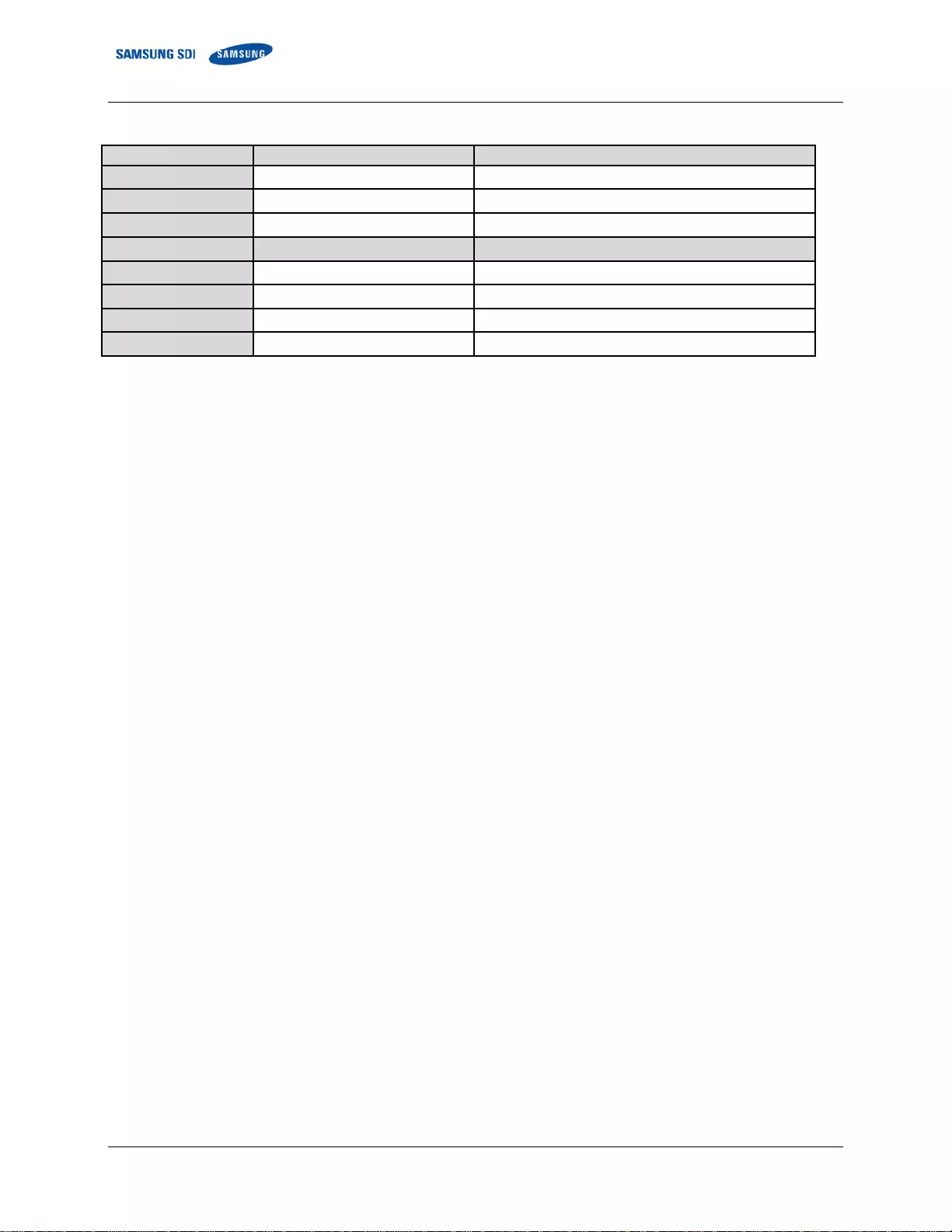
2. Product Description CONFIDENTIAL
14 English 8/2019. Rev 0.0
Table 8: SMPS Status (SMPS Assembly 1 Phase Only)
Item
Part Name
Description
Connector
J21SPM-04V-KX
-
Harness Housing
J21SF-04V-KX-L
-
Harness Terminal
SJ2F-01GF-P1.0
AWG 20~24
Pin No.
Pin Name
Function
1
SMPS #1 STATUS (+)
SMPS #1 status
2
SMPS #1 STATUS (-)
SMPS #1 status
3
SMPS #2 STATUS (+)
SMPS #2 status
4
SMPS #2 STATUS (-)
SMPS #2 status
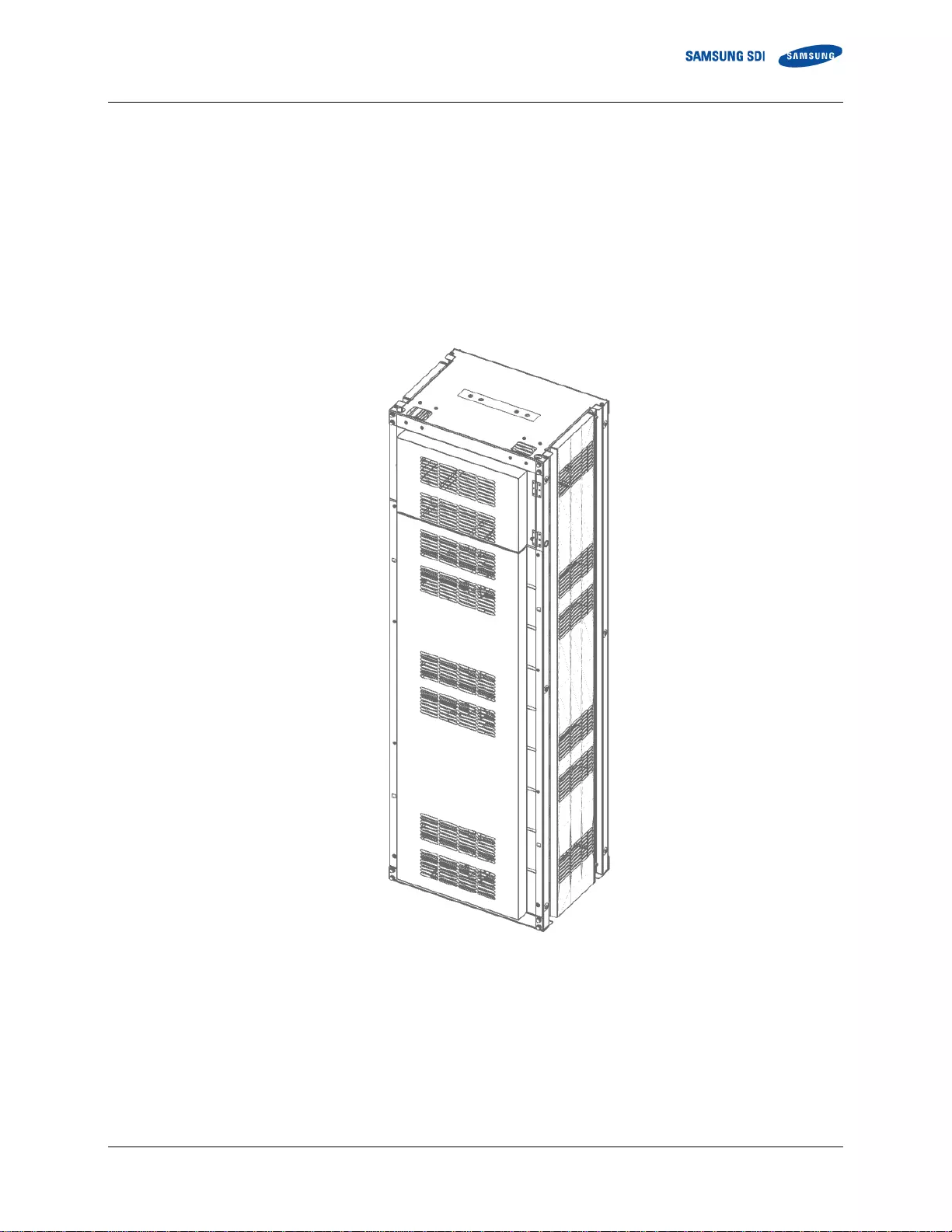
CONFIDENTIAL 2. Product Description
English 8/2019. Rev 0.0 15
2.1.4 Rack Frame
White: V808-00066A
Black: V808-00068A
The Rack Frame is used to mount the modules, SMU and SMPS assembly and provides ground connections for SMU
and SMPS Assembly.
(Grounding cable/busbar for the rack frame is necessary for the SMU and SMPS Assembly as they are grounded to
the rack frame when installed. An equipment grounding conductor is required to ground the rack frames together
and to the UPS module).
Figure 2-12: Rack Frame
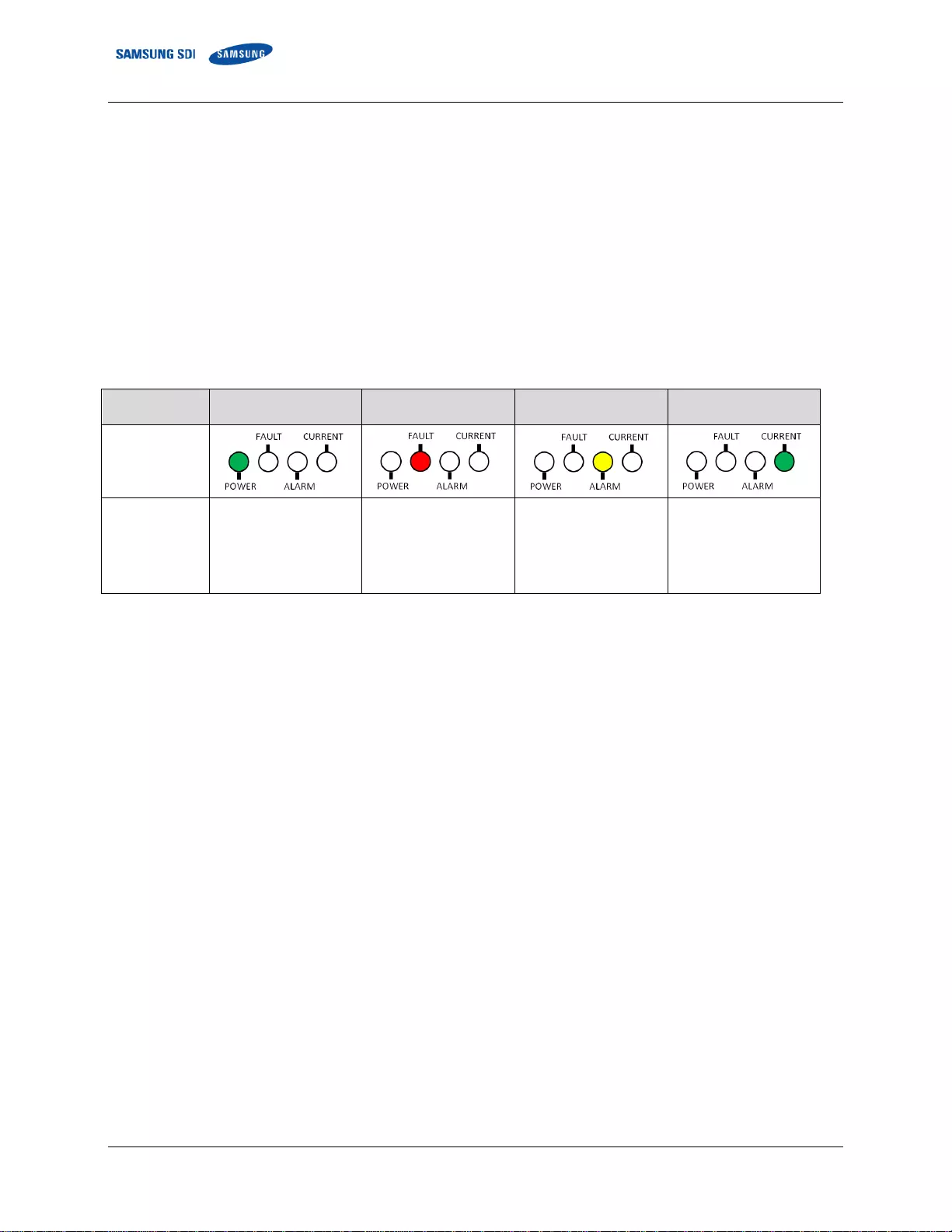
3. Battery System Operation CONFIDENTIAL
16 English 8/2019. Rev 0.0
3. Battery System Operation
The battery system for a UPS is designed to be always on. The UPS and the critical load must be set up so that the
battery system’s maximum allowable voltage and current are not exceeded.
3.1 Indicator LED
Four indicator LED’s on the front of the SMU in each rack displays the status of the battery system per string. Table
3-1 shows each LED’s color and the battery status indicated.
Table 3-1: Indicator LED Status
Items
POWER(Green)
FAULT(Red)
ALARM(Yellow)
CURRENT(Green)
Location
Status
On : MCCB Off
Off : Power Off
Blink : MCCB On
On : N/A
Off : No Major
Protection
Blink : Major
Protection
On : N/A
Off : No Minor
Protection
Blink : Minor
Protection
On : Discharge
Off : Idle
Blink : Charge
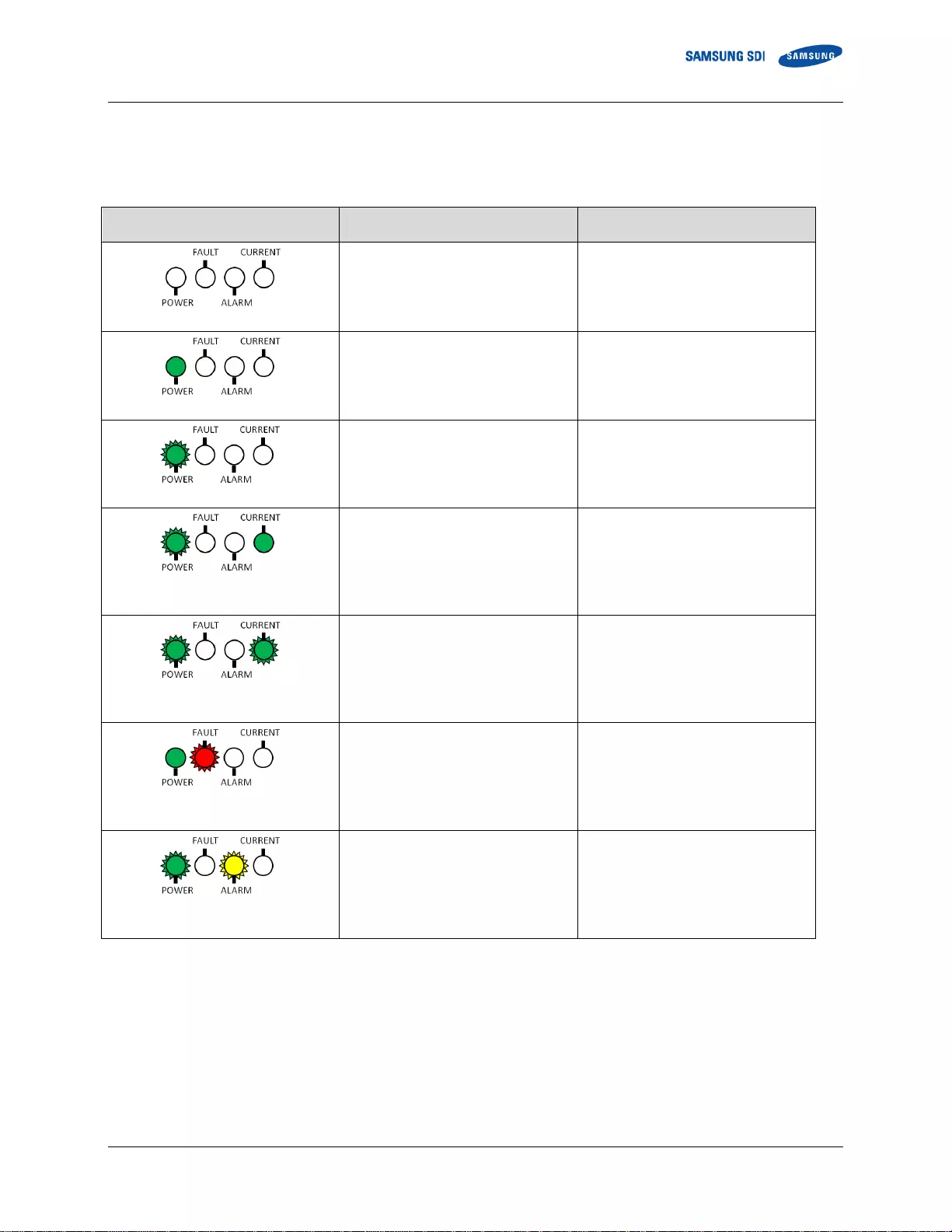
CONFIDENTIAL 3. Battery System Operation
English 8/2019. Rev 0.0 17
Depending on the battery system’s operating conditions, each indicator LED may be on, blinking or off. Table 3-2
shows the LED indication for the battery status.
Table 3-2: Indicated Codes
LED Status
Battery Status
Remarks
All LED’s Off
BMS Power Off
MCCB Off
POWER LED Steady
Normal
MCCB Off
POWER LED Flashing
Normal
MCCB On
POWER LED Flashing
CURRENT LED Steady
Normal
Discharge
POWER LED Flashing
CURRENT LED Flashing
Normal
Charge
POWER LED Steady
FAULT LED Flashing
Major Protection
MCCB Tripped
Overvoltage Protection
Undervoltage Protection
Overtemperature Protection
Overcurrent Protection
POWER LED Flashing
ALARM LED Flashing
Minor Protection
MCCB On
Voltage Imbalance Error
Voltage Sensing Error
Undertemperature Protection
Temperature Imbalance Error
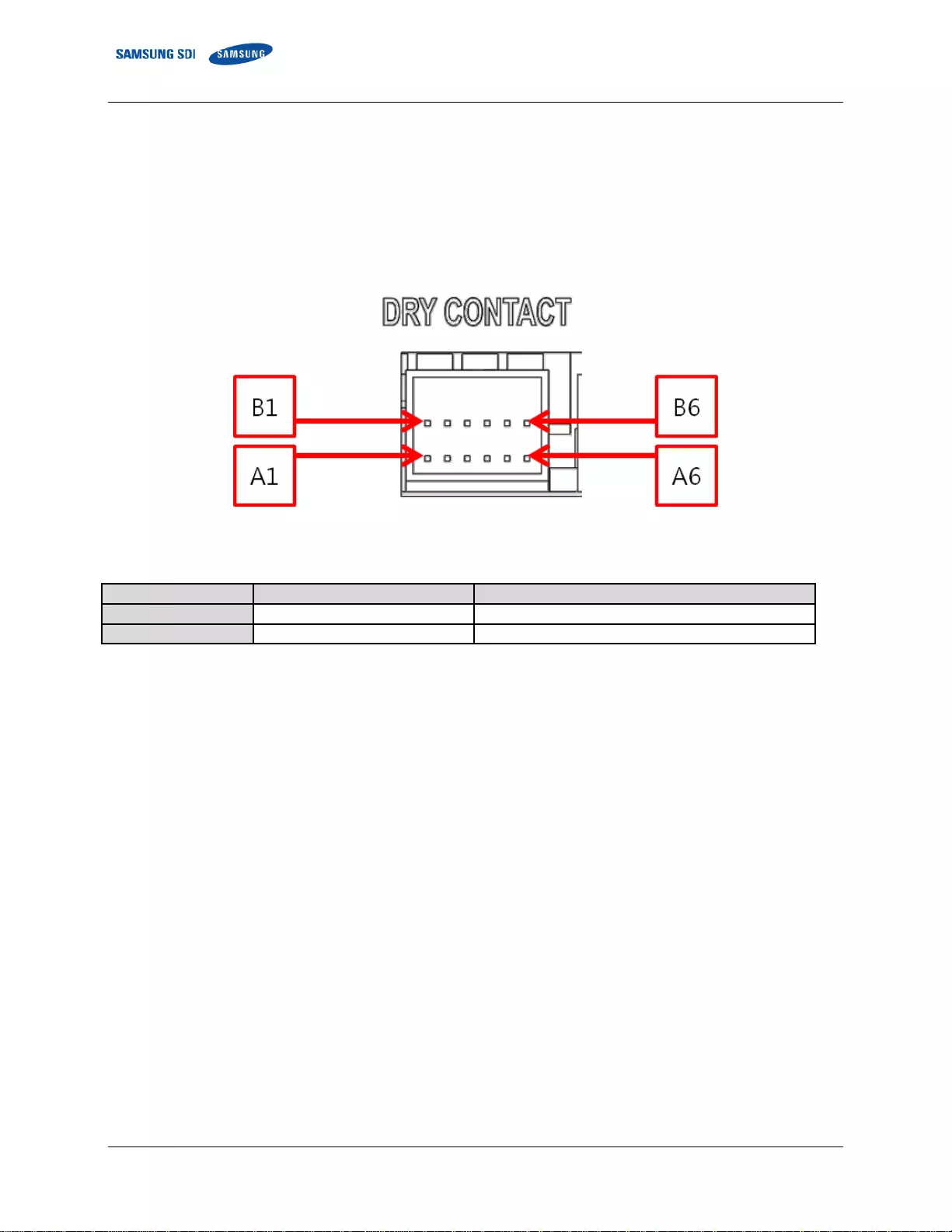
3. Battery System Operation CONFIDENTIAL
18 English 8/2019. Rev 0.0
3.2 Dry Contact Signals
Dry contact signals are sent from the System BMS in the SMPS Assembly to let the UPS know the status of the
battery system. Three Form-C output channels send signals for major protection, minor protection, and charge stop
request. One input channel receives a signal to trip the MCCB when requested from the UPS.
Three options of dry contact operation can be selected during installation.
Figure 3-1: Dry Contact Connector Pinout
Table 3-3: Dry Contact Connector Information
Item
Part Name
Description
Connector
S12B-J11DK-GWXR
JST
Harness Housing
J11DF-12V-KX
JST
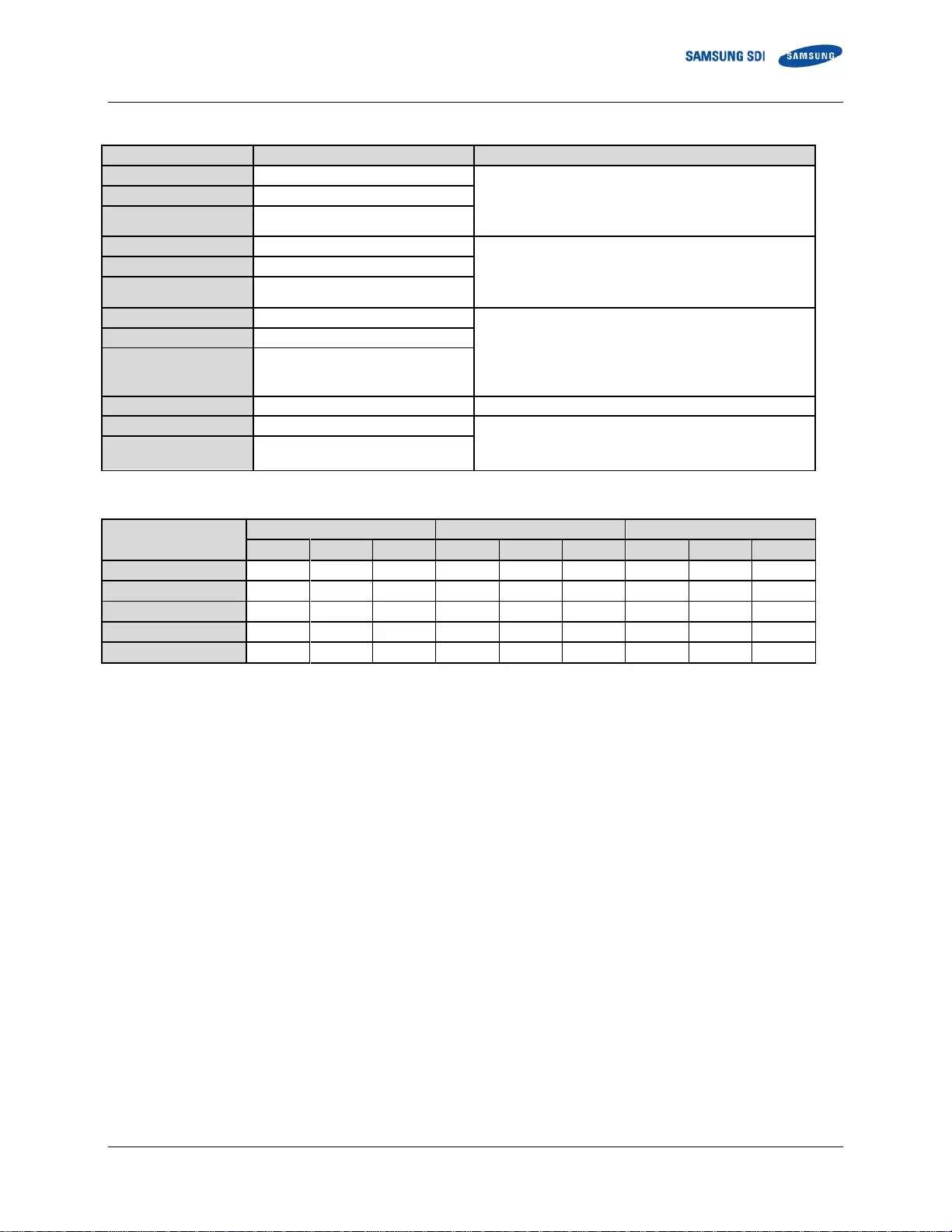
CONFIDENTIAL 3. Battery System Operation
English 8/2019. Rev 0.0 19
Table 3-4: Dry Contact Connector Description (Option 1. Customer ID = 0)
Pin No.
Pin Name
Function
B1
Major Common
Over-Voltage Protection
Under-Voltage Protection
Over-Temperature Protection
Over-Current Protection
A1
Major Normal Close
B2
Major Normal Open
A2
Minor Common
Voltage Imbalance Error
Voltage Sensing Error
Under Temperature protection
Temperature Imbalance Error
B3
Minor Normal Close
A3
Minor Normal Open
B4
Charge Common
Charge Stop Set Condition
1. Overvoltage alarm(4.25V/Cell)
2. SOC 100%
Charge Stop Release Condition
1. SOC < 97% or Discharge Current >│3A│
A4
Charge Normal Close
B5
Charge Normal Open
A5
Reserved
B6
Input
Set Condition: UPS closes B6, A6 contacts for more than
3 second.
Action : Battery MCCB Trip
A6
GND
Table 3-5: Dry Contact Operation (Option 1. Customer ID = 0)
Battery Status
MAJOR
MINOR
CHARGE STOP
B1
A1
B2
A2
B3
A3
B4
A4
B5
Normal Status
COM
Open
Close
COM
Open
Close
COM
Open
Close
Major Protection
COM
Close
Open
COM
Open
Close
COM
Open
Close
Minor Protection
COM
Open
Close
COM
Close
Open
COM
Open
Close
Charge Stop
COM
Open
Close
COM
Open
Close
COM
Close
Open
BMS Power Off
COM
Close
Open
COM
Close
Open
COM
Close
Open
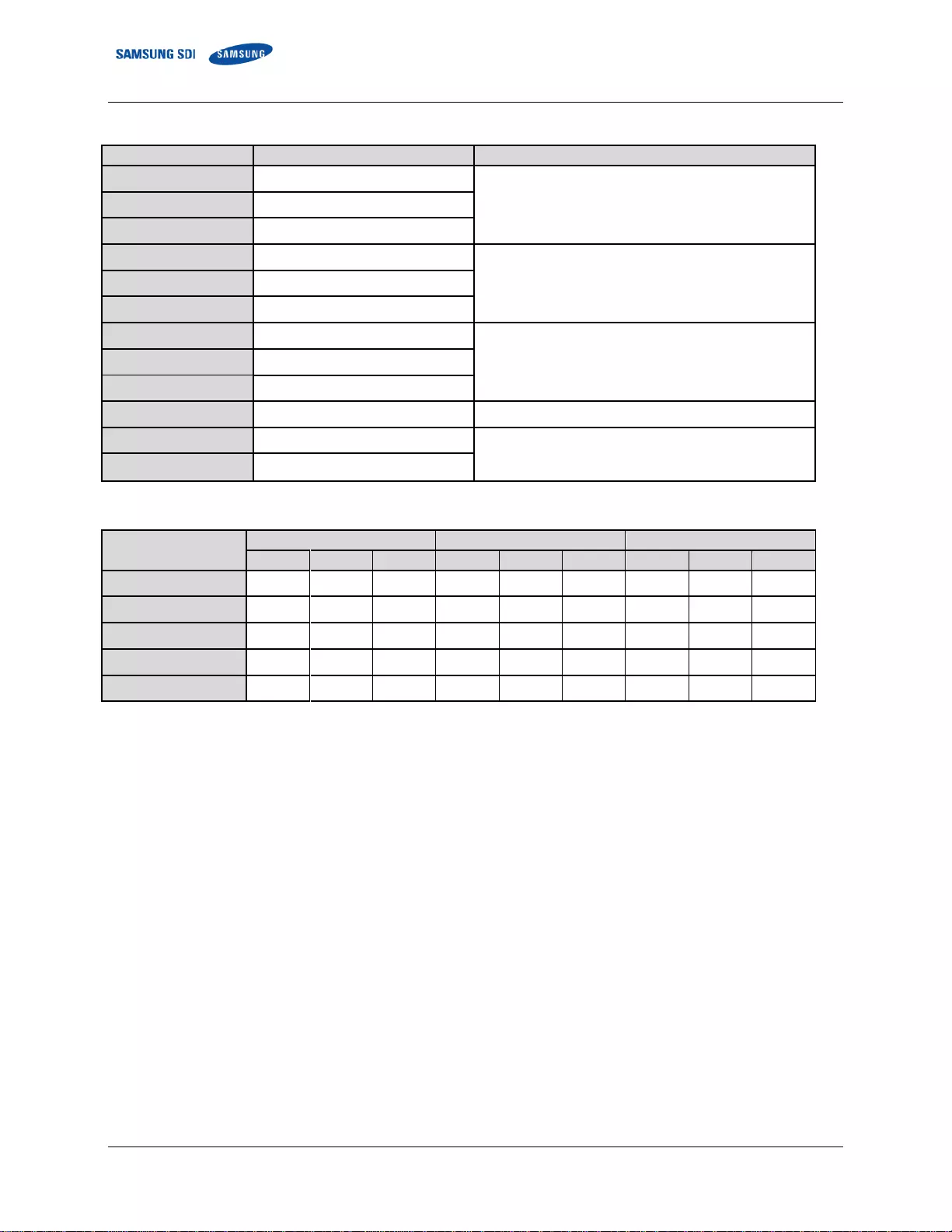
3. Battery System Operation CONFIDENTIAL
20 English 8/2019. Rev 0.0
Table 3-6: Dry Contact Connector Description (Option 2. Customer ID = 1)
Pin No.
Pin Name
Function
B1
Major Common
Overvoltage Protection
Undervoltage Protection
Overtemperature Protection
Overcurrent Protection
A1
Major Normally Closed
B2
Major Normally Open
A2
Minor Common
Voltage Imbalance Error
Voltage Sensing Error
Undertemperature Protection
Temperature Imbalance Error
B3
Minor Normally Closed
A3
Minor Normally Open
B4
MCCB Status Common
All MCCB’s are Off : A4, B4 are closed.
One of the MCCB’s is on : B5, B4 are closed.
A4
MCCB Status Normally Closed
B5
MCCB Status Normally Open
A5
Reserved
—
B6
Input
Set Condition: UPS opens B6, A6 contacts for more than
3 seconds.
Action : Battery MCCB Trip
A6
GND
Table 3-7: Dry Contact Operation (Option 2. Customer ID = 1)
Battery Status
MAJOR
MINOR
MCCB Status
B1
A1
B2
A2
B3
A3
B4
A4
B5
Normal Status
COM
Open
Close
COM
Open
Close
COM
Open
Close
Major Protection
COM
Close
Open
COM
Open
Close
COM
Close
Open
Minor Protection
COM
Open
Close
COM
Close
Open
COM
Open
Close
MCCB Off
COM
Close
Open
COM
Open
Close
COM
Close
Open
BMS Power Off
COM
Close
Open
COM
Close
Open
COM
Close
Open
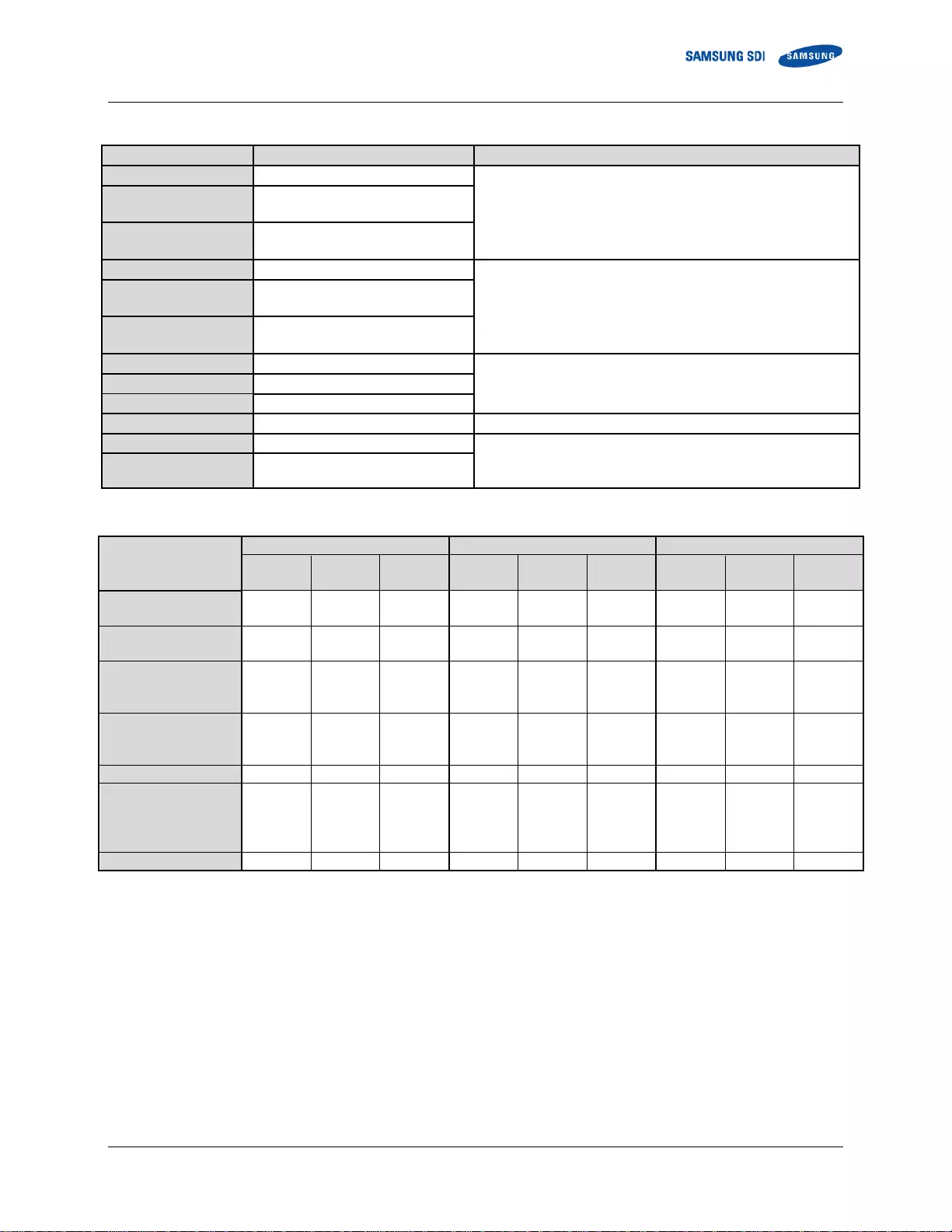
CONFIDENTIAL 3. Battery System Operation
English 8/2019. Rev 0.0 21
Table 8: Dry Contact Connector Description (Option 3. Customer ID = 2)
Pin No.
Pin Name
Function
B1
Discharge Prohibit Common
Undervoltage Protection
Overtemperature Protection
Discharge Overcurrent Protection
A1
Discharge Prohibit
Normal Close
B2
Discharge Prohibit
Normal Open
A2
Charge Prohibit Common
Overvoltage Alarm,
Overvoltage Protection
Overtemperature Protection
Charge Overcurrent Protection
B3
Charge Prohibit
Normal Close
A3
Charge Prohibit
Normal Open
B4
MCCB Status Common
All MCCBs are off : 4A, 4B is closed
One of MCCB is on : 5B, 4B is closed
A4
MCCB Status Normal Close
B5
MCCB Status Normal Open
A5
Reserved
B6
Input
Set Condition: UPS opens B6, A6 contacts for more than 1
second.
Action : Battery MCCB Trip
A6
GND
Table 9: Dry Contact Operation (Option 3. Customer ID = 2)
Battery Status
Discharge Prohibited
Charge Prohibited
MCCB Status
B1
(COM)
A1
(NC)
B2
(NO)
A2
(COM)
B3
(NC)
A3
(NO)
B4
(COM)
A4
(NC)
B5
(NO)
Normal Status
(All MCCB on)
COM
Close
Open
COM
Close
Open
COM
Open
Close
At least one MCCB is
on
COM
-
-
COM
-
-
COM
Open
Close
Discharge Prohibited
(UVP, OTP, Discharge
OCP)
COM
Open
Close
COM
-
-
COM
-
-
Charge Prohibited
(OV alarm, OVP, OTP,
Charge OCP)
COM
-
-
COM
Open
Close
COM
-
-
All MCCBs Off
COM
-
-
COM
-
-
COM
Close
Open
EPO Received
(B6, A6 contacts are
OPEN for more than 1
second)
COM
-
-
COM
-
-
COM
Close
Open
BMS Power Off
COM
Close
Open
COM
Close
Open
COM
Close
Open

3. Battery System Operation CONFIDENTIAL
22 English 8/2019. Rev 0.0
3.3 Operation Status
Refer to the table below for typical and maximum state of charge and discharge conditions to keep the battery
system in normal operation.
Table 3-10: Range of Operation (136S Configuration)
No.
Item
Specification
Remarks
1
Nominal Capacity
34.6kWh
1/3C@R.T
2
Nominal Voltage1
516.8V DC
3.8V/cell
3
Maximum Voltage1
571.2V DC
4.2V/cell
4
Discharging Method
Constant Power
End of Discharge Voltage1
408V DC
3.0V/cell
Recommended End of Discharge Voltage
435.2V DC
3.2V/cell
Standard Discharging Current
22.3A
1/3C@R.T
Maximum Continuous Discharge Power
183.6kW
Peak 450A @ EODV
5
Charging Method
CC-CV, Floating
Floating Charge Voltage
571.2V DC
4.2V/cell
Standard Charge Current
22.3A
1/3C
Maximum Peak Charge Current
250A
2 second pulse
Maximum Continuous Charging Current
67A
1C
6
Recommended Operation Temperature
23±5°C
7
Storage Temperature
0 ~ 40°C
8
Storage Humidity
Less than 90 % RH
Noncondensing
9
Recommended Storage Humidity
Less than 60 % RH
Noncondensing
10
Storage Period2
Less than 6 months
1
Specified voltage must be satisfied in all load and charging conditions.
2
Capacity degradation will occur depending on storage time. To minimize capacity degradation,
storage temperature of less than 10°C and 3.630V per cell is recommended.

CONFIDENTIAL 3. Battery System Operation
English 8/2019. Rev 0.0 23
Table 3-11: Range of Operation (128S Configuration)
No.
Item
Specification
Remarks
1
Nominal Capacity
32.6kWh
1/3C@R.T
2
Nominal Voltage1
486.4V DC
3.8V/cell
3
Maximum Voltage1
537.6V DC
4.2V/cell
4
Discharging Method
Constant Power
End of Discharge Voltage1
384V DC
3.0V/cell
Recommended End of Discharge Voltage
409.6V DC
3.2V/cell
Standard Discharging Current
22.3A
1/3C@R.T
Maximum Continuous Discharge Power
173kW
Peak 450A @ EODV
5
Charging Method
CC-CV, Floating
Floating Charge Voltage
537.6V DC
4.2V/cell
Standard Charge Current
22.3A
1/3C
Maximum Peak Charge Current
250A
2 second pulse
Maximum Continuous Charging Current
67A
1C
6
Recommended Operation Temperature
23±5°C
7
Storage Temperature
0 ~ 40°C
8
Storage Humidity
Less than 90 % RH
Noncondensing
9
Recommended Storage Humidity
Less than 60 % RH
Noncondensing
10
Storage Period2
Less than 6 months
1
Specified voltage must be satisfied in all load and charging conditions.
2
Capacity degradation will occur depending on storage time. To minimize capacity degradation, storage
temperature of less than 10°C and 3.630V per cell is recommended.

3. Battery System Operation CONFIDENTIAL
24 English 8/2019. Rev 0.0
Table 3-12: Range of Operation (112S Configuration)
No.
Item
Specification
Remarks
1
Nominal Capacity
28.5kWh
1/3C@R.T
2
Nominal Voltage1
425.6V DC
3.8V/cell
3
Maximum Voltage1
470.4V DC
4.2V/cell
4
Discharging Method
Constant Power
End of Discharge Voltage1
336V DC
3.0V/cell
Recommended End of Discharge Voltage
358.4V DC
3.2V/cell
Standard Discharging Current
22.3A
1/3C@R.T
Maximum Continuous Discharge Power
151kW
Peak 450A @ EODV
5
Charging Method
CC-CV, Floating
Floating Charge Voltage
470.4V DC
4.2V/cell
Standard Charge Current
22.3A
1/3C
Maximum Peak Charge Current
250A
2 second pulse
Maximum Continuous Charging Current
67A
1C
6
Recommended Operation Temperature
23±5°C
7
Storage Temperature
0 ~ 40°C
8
Storage Humidity
Less than 90 % RH
Noncondensing
9
Recommended Storage Humidity
Less than 60 % RH
Noncondensing
10
Storage Period2
Less than 6 months
1
Specified voltage must be satisfied in all load and charging conditions.
2
Capacity degradation will occur depending on storage time. To minimize capacity degradation, storage
temperature of less than 10°C and 3.630V per cell is recommended.

CONFIDENTIAL 3. Battery System Operation
English 8/2019. Rev 0.0 25
Table 3-13: Range of Operation (104S Configuration)
No.
Item
Specification
Remarks
1
Nominal Capacity
26.5kWh
1/3C@R.T
2
Nominal Voltage1
395.2V DC
3.8V/cell
3
Maximum Voltage1
436.8V DC
4.2V/cell
4
Discharging Method
Constant Power
End of Discharge Voltage1
312V DC
3.0V/cell
Recommended End of Discharge Voltage
332.8V DC
3.2V/cell
Standard Discharging Current
22.3A
1/3C@R.T
Maximum Continuous Discharge Power
140kW
Peak 450A @ EODV
5
Charging Method
CC-CV, Floating
Floating Charge Voltage
436.8V DC
4.2V/cell
Standard Charge Current
22.3A
1/3C
Maximum Peak Charge Current
250A
2 second pulse
Maximum Continuous Charging Current
67A
1C
6
Recommended Operation Temperature
23±5°C
7
Storage Temperature
0 ~ 40°C
8
Storage Humidity
Less than 90 % RH
Noncondensing
9
Recommended Storage Humidity
Less than 60 % RH
Noncondensing
10
Storage Period2
Less than 6 months
1
Specified voltage must be satisfied in all load and charging conditions.
2
Capacity degradation will occur depending on storage time. To minimize capacity degradation, storage
temperature of less than 10°C and 3.630V per cell is recommended.

3. Battery System Operation CONFIDENTIAL
26 English 8/2019. Rev 0.0
Table 3-14: Range of Operation (80S Configuration)
No.
Item
Specification
Remarks
1
Nominal Capacity
20.4kWh
1/3C@R.T
2
Nominal Voltage1
304V DC
3.8V/cell
3
Maximum Voltage1
336V DC
4.2V/cell
4
Discharging Method
Constant Power
End of Discharge Voltage1
240V DC
3.0V/cell
Recommended End of Discharge Voltage
256V DC
3.2V/cell
Standard Discharging Current
22.3A
1/3C@R.T
Maximum Continuous Discharge Power
108kW
Peak 450A @ EODV
5
Charging Method
CC-CV, Floating
Floating Charge Voltage
336V DC
4.2V/cell
Standard Charge Current
22.3A
1/3C
Maximum Peak Charge Current
250A
2 second pulse
Maximum Continuous Charging Current
67A
1C
6
Recommended Operation Temperature
23±5°C
7
Storage Temperature
0 ~ 40°C
8
Storage Humidity
Less than 90 % RH
Noncondensing
9
Recommended Storage Humidity
Less than 60 % RH
Noncondensing
10
Storage Period2
Less than 6 months
1
Specified voltage must be satisfied in all load and charging conditions.
2
Capacity degradation will occur depending on storage time. To minimize capacity degradation, storage
temperature of less than 10°C and 3.630V per cell is recommended.
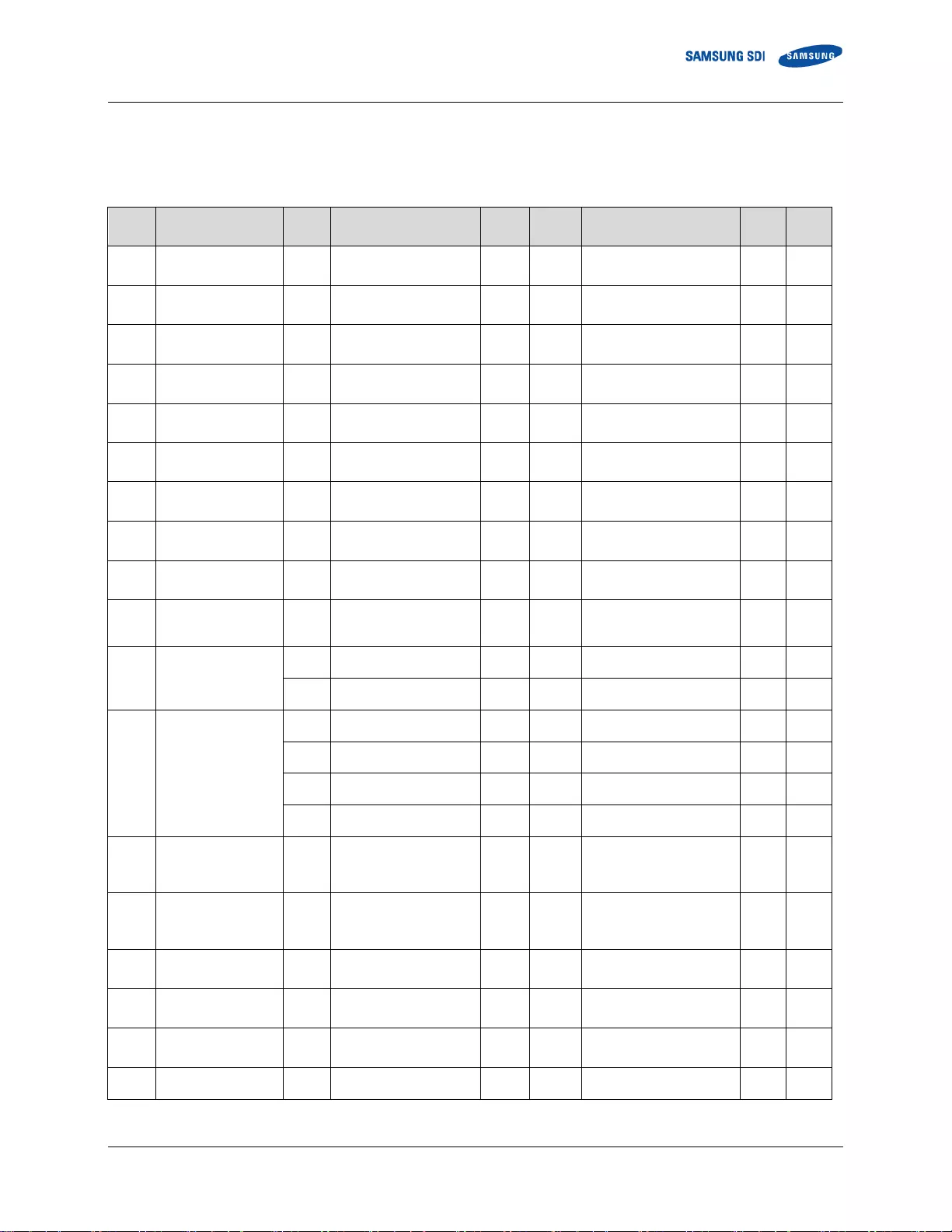
CONFIDENTIAL 3. Battery System Operation
English 8/2019. Rev 0.0 27
When the operating limits of the battery system are exceeded, protective measures are taken autonomously to
protect the system from failure. The following table lists the protective functions and their actions.
Table 3-15. Protective Functions (136S Configuration)
No
Items
Level
SET Condition
Time
(Sec)
MCCB
Release Condition
Time
(Sec)
MCCB
1
Over Voltage
Protection - Cell
Major
Max Cell ≥ 4.28V
5
OFF
Max Cell < 4.25V & Reset
5
ON
2
Under Voltage
Protection - Cell
Major
Min Cell ≤ 2.5V
3
OFF
Min Cell > 2.70V& Reset
3
ON
3
Over Voltage
Protection - Rack
Major
Rack Voltage ≥ 582.08V
5
OFF
Rack Voltage < 578V &
Reset
5
ON
4
Under Voltage
Protection - Rack
Major
Rack Voltage ≤ 340
3
OFF
Rack Voltage > 367.2V
& Reset
3
ON
5
Voltage Imbalance
Major
Max Cell ≥ 3.80V &
△Vcell ≥ 100mV
5
OFF
△Vcell < 30mV & Reset
5
ON
6
Voltage Sensing Error
(Rack)
Minor
│Rack V - Cell Sum V│
≥40.8V
10
ON
│Rack V - Cell Sum V│
< 20.4V & Reset
3
ON
7
Voltage Sensing Error
(Module)
Minor
│Module V - Cell Sum V│
≥190mV
5
ON
│Module V - Cell Sum V│
< 190mV & Reset
3
ON
8
Over Temperature
Protection
Major
Max Temp ≥ 75℃
3
OFF
Max Temp < 65℃ & Reset
3
ON
9
Under Temperature
Protection
Minor
Min Temp ≤ 0℃
3
ON
Min Temp > 5℃ & Reset
3
ON
10
Temperature
imbalance
Major
Max Cell T - Min Cell T
≥ 40℃
30
OFF
Max Cell T - Min Cell T
< 20℃ & Reset
3
ON
11
Over Current
Protection
(Charge)
Major
Level2 Current ≥ 250A
2
OFF
|Current| < 10A & Reset
3
ON
Major
Level1 Current ≥ 200A
60
OFF
|Current| < 10A & Reset
3
ON
12
Over Current
Protection
(Discharge)
Major
Lvel4 |Current| ≥ 600A
1
OFF
|Current| < 10A & Reset
3
ON
Major
Level3 |Current| ≥ 540A
10
OFF
|Current| < 10A & Reset
3
ON
Major
Level2 |Current| ≥ 495A
30
OFF
|Current| < 10A & Reset
3
ON
Major
Level1 |Current| ≥ 470A
60
OFF
|Current| < 10A & Reset
3
ON
13
Communication
Failure
(Module ↔ Rack)
Major
No Communication
30
OFF
Re Communication &
Reset
-
ON
14
Communication
Failure
(Rack ↔ System )
Major
No Communication
30
OFF
Re Communication &
Reset
-
ON
15
SW Failure - MCCB
Minor
MCCB OFF & |Current|
≥ 2.4A
3
ON
(MCCB OFF & (|Current| <
2.4A) & Reset
-
ON
16
SW Sensor Failure -
MCCB
Minor
MCCB contact ON
= MCCB Trip ON
3
ON
(MCCB contact ≠ MCCB
Trip) & Reset
-
ON
17
Current Sensing Error
Minor
No communication
with Current IC
3
ON
Re communication
with Current IC
-
ON
18
Fuse Failure
Minor
Fuse Blown
10
ON
Fuse ON & Reset
-
ON

3. Battery System Operation CONFIDENTIAL
28 English 8/2019. Rev 0.0
Table 3-16. Protective Functions (128S Configuration)
No
Items
Level
SET Condition
Time
(Sec)
MCCB
Release Condition
Time
(Sec)
MCCB
1
Over Voltage
Protection - Cell
Major
Max Cell ≥ 4.28V
5
OFF
Max Cell < 4.25V & Reset
5
ON
2
Under Voltage
Protection - Cell
Major
Min Cell ≤ 2.5V
3
OFF
Min Cell > 2.70V& Reset
3
ON
3
Over Voltage
Protection - Rack
Major
Rack Voltage ≥ 547.84V
5
OFF
Rack Voltage < 544V &
Reset
5
ON
4
Under Voltage
Protection - Rack
Major
Rack Voltage ≤ 320
3
OFF
Rack Voltage > 345.6V
& Reset
3
ON
5
Voltage Imbalance
Major
Max Cell ≥ 3.80V &
△Vcell ≥ 100mV
5
OFF
△Vcell < 30mV & Reset
5
ON
6
Voltage Sensing Error
(Rack)
Minor
│Rack V - Cell Sum V│
≥38.4V
10
ON
│Rack V - Cell Sum V│
< 19.2V & Reset
3
ON
7
Voltage Sensing Error
(Module)
Minor
│Module V - Cell Sum V│
≥190mV
5
ON
│Module V - Cell Sum V│
< 190mV & Reset
3
ON
8
Over Temperature
Protection
Major
Max Temp ≥ 75℃
3
OFF
Max Temp < 65℃ & Reset
3
ON
9
Under Temperature
Protection
Minor
Min Temp ≤ 0℃
3
ON
Min Temp > 5℃ & Reset
3
ON
10
Temperature
imbalance
Major
Max Cell T - Min Cell T
≥ 40℃
30
OFF
Max Cell T - Min Cell T
< 20℃ & Reset
3
ON
11
Over Current
Protection
(Charge)
Major
Level2 Current ≥ 250A
2
OFF
|Current| < 10A & Reset
3
ON
Major
Level1 Current ≥ 200A
60
OFF
|Current| < 10A & Reset
3
ON
12
Over Current
Protection
(Discharge)
Major
Lvel4 |Current| ≥ 600A
1
OFF
|Current| < 10A & Reset
3
ON
Major
Level3 |Current| ≥ 540A
10
OFF
|Current| < 10A & Reset
3
ON
Major
Level2 |Current| ≥ 495A
30
OFF
|Current| < 10A & Reset
3
ON
Major
Level1 |Current| ≥ 470A
60
OFF
|Current| < 10A & Reset
3
ON
13
Communication
Failure
(Module ↔ Rack)
Major
No Communication
30
OFF
Re Communication &
Reset
-
ON
14
Communication
Failure
(Rack ↔ System )
Major
No Communication
30
OFF
Re Communication &
Reset
-
ON
15
SW Failure - MCCB
Minor
MCCB OFF & |Current|
≥ 2.4A
3
ON
(MCCB OFF & (|Current| <
2.4A) & Reset
-
ON
16
SW Sensor Failure -
MCCB
Minor
MCCB contact ON
= MCCB Trip ON
3
ON
(MCCB contact ≠ MCCB
Trip) & Reset
-
ON
17
Current Sensing Error
Minor
No communication
with Current IC
3
ON
Re communication
with Current IC
-
ON
18
Fuse Failure
Minor
Fuse Blown
10
ON
Fuse ON & Reset
-
ON

CONFIDENTIAL 3. Battery System Operation
English 8/2019. Rev 0.0 29
Table 3-17. Protective Functions (112S Configuration)
No
Items
Level
SET Condition
Time
(Sec)
MCCB
Release Condition
Time
(Sec)
MCCB
1
Over Voltage
Protection - Cell
Major
Max Cell ≥ 4.28V
5
OFF
Max Cell < 4.25V & Reset
5
ON
2
Under Voltage
Protection - Cell
Major
Min Cell ≤ 2.5V
3
OFF
Min Cell > 2.70V& Reset
3
ON
3
Over Voltage
Protection - Rack
Major
Rack Voltage ≥ 479.36V
5
OFF
Rack Voltage < 476V &
Reset
5
ON
4
Under Voltage
Protection - Rack
Major
Rack Voltage ≤ 280
3
OFF
Rack Voltage > 302.4V
& Reset
3
ON
5
Voltage Imbalance
Major
Max Cell ≥ 3.80V &
△Vcell ≥ 100mV
5
OFF
△Vcell < 30mV & Reset
5
ON
6
Voltage Sensing Error
(Rack)
Minor
│Rack V - Cell Sum V│
≥33.6V
10
ON
│Rack V - Cell Sum V│
< 16.8V & Reset
3
ON
7
Voltage Sensing Error
(Module)
Minor
│Module V - Cell Sum V│
≥190mV
5
ON
│Module V - Cell Sum V│
< 190mV & Reset
3
ON
8
Over Temperature
Protection
Major
Max Temp ≥ 75℃
3
OFF
Max Temp < 65℃ & Reset
3
ON
9
Under Temperature
Protection
Minor
Min Temp ≤ 0℃
3
ON
Min Temp > 5℃ & Reset
3
ON
10
Temperature
imbalance
Major
Max Cell T - Min Cell T
≥ 40℃
30
OFF
Max Cell T - Min Cell T
< 20℃ & Reset
3
ON
11
Over Current
Protection
(Charge)
Major
Level2 Current ≥ 250A
2
OFF
|Current| < 10A & Reset
3
ON
Major
Level1 Current ≥ 200A
60
OFF
|Current| < 10A & Reset
3
ON
12
Over Current
Protection
(Discharge)
Major
Lvel4 |Current| ≥ 600A
1
OFF
|Current| < 10A & Reset
3
ON
Major
Level3 |Current| ≥ 540A
10
OFF
|Current| < 10A & Reset
3
ON
Major
Level2 |Current| ≥ 495A
30
OFF
|Current| < 10A & Reset
3
ON
Major
Level1 |Current| ≥ 470A
60
OFF
|Current| < 10A & Reset
3
ON
13
Communication
Failure
(Module ↔ Rack)
Major
No Communication
30
OFF
Re Communication &
Reset
-
ON
14
Communication
Failure
(Rack ↔ System )
Major
No Communication
30
OFF
Re Communication &
Reset
-
ON
15
SW Failure - MCCB
Minor
MCCB OFF & |Current|
≥ 2.4A
3
ON
(MCCB OFF & (|Current| <
2.4A) & Reset
-
ON
16
SW Sensor Failure -
MCCB
Minor
MCCB contact ON
= MCCB Trip ON
3
ON
(MCCB contact ≠ MCCB
Trip) & Reset
-
ON
17
Current Sensing Error
Minor
No communication
with Current IC
3
ON
Re communication
with Current IC
-
ON
18
Fuse Failure
Minor
Fuse Blown
10
ON
Fuse ON & Reset
-
ON

3. Battery System Operation CONFIDENTIAL
30 English 8/2019. Rev 0.0
Table 3-18. Protective Functions (104S Configuration)
No
Items
Level
SET Condition
Time
(Sec)
MCCB
Release Condition
Time
(Sec)
MCCB
1
Over Voltage
Protection - Cell
Major
Max Cell ≥ 4.28V
5
OFF
Max Cell < 4.25V & Reset
5
ON
2
Under Voltage
Protection - Cell
Major
Min Cell ≤ 2.5V
3
OFF
Min Cell > 2.70V& Reset
3
ON
3
Over Voltage
Protection - Rack
Major
Rack Voltage ≥ 445.12V
5
OFF
Rack Voltage < 442V &
Reset
5
ON
4
Under Voltage
Protection - Rack
Major
Rack Voltage ≤ 260
3
OFF
Rack Voltage > 280.8V
& Reset
3
ON
5
Voltage Imbalance
Major
Max Cell ≥ 3.80V &
△Vcell ≥ 100mV
5
OFF
△Vcell < 30mV & Reset
5
ON
6
Voltage Sensing Error
(Rack)
Minor
│Rack V - Cell Sum V│
≥31.2V
10
ON
│Rack V - Cell Sum V│
< 15.6V & Reset
3
ON
7
Voltage Sensing Error
(Module)
Minor
│Module V - Cell Sum V│
≥190mV
5
ON
│Module V - Cell Sum V│
< 190mV & Reset
3
ON
8
Over Temperature
Protection
Major
Max Temp ≥ 75℃
3
OFF
Max Temp < 65℃ & Reset
3
ON
9
Under Temperature
Protection
Minor
Min Temp ≤ 0℃
3
ON
Min Temp > 5℃ & Reset
3
ON
10
Temperature
imbalance
Major
Max Cell T - Min Cell T
≥ 40℃
30
OFF
Max Cell T - Min Cell T
< 20℃ & Reset
3
ON
11
Over Current
Protection
(Charge)
Major
Level2 Current ≥ 250A
2
OFF
|Current| < 10A & Reset
3
ON
Major
Level1 Current ≥ 200A
60
OFF
|Current| < 10A & Reset
3
ON
12
Over Current
Protection
(Discharge)
Major
Lvel4 |Current| ≥ 600A
1
OFF
|Current| < 10A & Reset
3
ON
Major
Level3 |Current| ≥ 540A
10
OFF
|Current| < 10A & Reset
3
ON
Major
Level2 |Current| ≥ 495A
30
OFF
|Current| < 10A & Reset
3
ON
Major
Level1 |Current| ≥ 470A
60
OFF
|Current| < 10A & Reset
3
ON
13
Communication
Failure
(Module ↔ Rack)
Major
No Communication
30
OFF
Re Communication &
Reset
-
ON
14
Communication
Failure
(Rack ↔ System )
Major
No Communication
30
OFF
Re Communication &
Reset
-
ON
15
SW Failure - MCCB
Minor
MCCB OFF & |Current|
≥ 2.4A
3
ON
(MCCB OFF & (|Current| <
2.4A) & Reset
-
ON
16
SW Sensor Failure -
MCCB
Minor
MCCB contact ON
= MCCB Trip ON
3
ON
(MCCB contact ≠ MCCB
Trip) & Reset
-
ON
17
Current Sensing Error
Minor
No communication
with Current IC
3
ON
Re communication
with Current IC
-
ON
18
Fuse Failure
Minor
Fuse Blown
10
ON
Fuse ON & Reset
-
ON

CONFIDENTIAL 3. Battery System Operation
English 8/2019. Rev 0.0 31
Table 3-19. Protective Functions (80S Configuration)
No
Items
Level
SET Condition
Time
(Sec)
MCCB
Release Condition
Time
(Sec)
MCCB
1
Over Voltage
Protection - Cell
Major
Max Cell ≥ 4.28V
5
OFF
Max Cell < 4.25V & Reset
5
ON
2
Under Voltage
Protection - Cell
Major
Min Cell ≤ 2.5V
3
OFF
Min Cell > 2.70V& Reset
3
ON
3
Over Voltage
Protection - Rack
Major
Rack Voltage ≥ 342.4V
5
OFF
Rack Voltage < 340V &
Reset
5
ON
4
Under Voltage
Protection - Rack
Major
Rack Voltage ≤ 200
3
OFF
Rack Voltage > 216V
& Reset
3
ON
5
Voltage Imbalance
Major
Max Cell ≥ 3.80V &
△Vcell ≥ 100mV
5
OFF
△Vcell < 30mV & Reset
5
ON
6
Voltage Sensing Error
(Rack)
Minor
│Rack V - Cell Sum V│
≥24V
10
ON
│Rack V - Cell Sum V│
< 12V & Reset
3
ON
7
Voltage Sensing Error
(Module)
Minor
│Module V - Cell Sum V│
≥190mV
5
ON
│Module V - Cell Sum V│
< 190mV & Reset
3
ON
8
Over Temperature
Protection
Major
Max Temp ≥ 75℃
3
OFF
Max Temp < 65℃ & Reset
3
ON
9
Under Temperature
Protection
Minor
Min Temp ≤ 0℃
3
ON
Min Temp > 5℃ & Reset
3
ON
10
Temperature
imbalance
Major
Max Cell T - Min Cell T
≥ 40℃
30
OFF
Max Cell T - Min Cell T
< 20℃ & Reset
3
ON
11
Over Current
Protection
(Charge)
Major
Level2 Current ≥ 250A
2
OFF
|Current| < 10A & Reset
3
ON
Major
Level1 Current ≥ 200A
60
OFF
|Current| < 10A & Reset
3
ON
12
Over Current
Protection
(Discharge)
Major
Lvel4 |Current| ≥ 600A
1
OFF
|Current| < 10A & Reset
3
ON
Major
Level3 |Current| ≥ 540A
10
OFF
|Current| < 10A & Reset
3
ON
Major
Level2 |Current| ≥ 495A
30
OFF
|Current| < 10A & Reset
3
ON
Major
Level1 |Current| ≥ 470A
60
OFF
|Current| < 10A & Reset
3
ON
13
Communication
Failure
(Module ↔ Rack)
Major
No Communication
30
OFF
Re Communication &
Reset
-
ON
14
Communication
Failure
(Rack ↔ System )
Major
No Communication
30
OFF
Re Communication &
Reset
-
ON
15
SW Failure - MCCB
Minor
MCCB OFF & |Current|
≥ 2.4A
3
ON
(MCCB OFF & (|Current| <
2.4A) & Reset
-
ON
16
SW Sensor Failure -
MCCB
Minor
MCCB contact ON
= MCCB Trip ON
3
ON
(MCCB contact ≠ MCCB
Trip) & Reset
-
ON
17
Current Sensing Error
Minor
No communication
with Current IC
3
ON
Re communication
with Current IC
-
ON
18
Fuse Failure
Minor
Fuse Blown
10
ON
Fuse ON & Reset
-
ON

3. Battery System Operation CONFIDENTIAL
32 English 8/2019. Rev 0.0
3.3.1 Normal Status
In normal status, the battery system is available for charge or discharge. The system operator must follow the
guidelines below to ensure safe and optimal performance from the battery.
The battery must be fully charged to power the critical load for the duration of the backup time.
After a full discharge at maximum continuous power, cool the battery for at least 12 hours before another
discharge in order to avoid over-temperature protection. For optimal performance, wait until the battery
temperature returns to at least ±3oC within the room temperature.
Immediate recharging after a full discharge at maximum continuous power may degrade the battery
performance.
3.3.2 Minor Protection Status (Alarm)
When a minor protection (alarm status) occurs, the battery system will send a message to the UPS or other systems
and request that all charge or discharge operation be stopped until the problem is corrected. Battery system will
not be disconnected in minor protection status to maximize the battery’s availability. Refer to Section 5
“Troubleshooting” for solutions to minor protection status.
3.3.3 Major Protection Status (Fault)
If the system detects a major protection (fault status), it will trip the MCCB to disconnect the battery system from
the UPS to prevent damage to the battery. Measures must be taken to clear the major protection status and return
the battery system to normal status. Personnel must be on-site to return the MCCB from “trip” to “on” position
after returning the system status to normal. Refer to Section 5 “Troubleshooting” for details on solutions to major
protection status.

CONFIDENTIAL 4. Maintenance Checks
English 8/2019. Rev 0.0 33
4. Maintenance Checks
The battery system components are designed to be free of regular maintenance. Regular inspection of components
and power connections are recommended to ensure proper performance. Scheduled checks of the battery system
are recommended but not mandatory for optimal performance. Refer to 3.3 Operation Status for the battery
system’s operating conditions.
4.1 Daily Checks
Following is a list of items to be checked daily.
Rack voltage should be in its floating charge voltage.
Cell voltage range should be within 300mV.
MCCB must be on for all racks.
There must be no alarms or faults.
Maintaining room temperature and humidity according to the range of operation..
4.2 Monthly Checks
Personnel should visually inspect the battery system monthly and review log data about the battery and its
operating environment.
Battery should have no visible damage (rust, bent structure, damaged or missing cables or busbars, etc.)
Check the recorded data of the battery system for the voltage and current readings.
Check the date and time of charge and discharge cycles.
Check whether any alarms or faults have been triggered.
4.3 Annual Check
A trend analysis of the recorded data (battery and environment) is recommended.
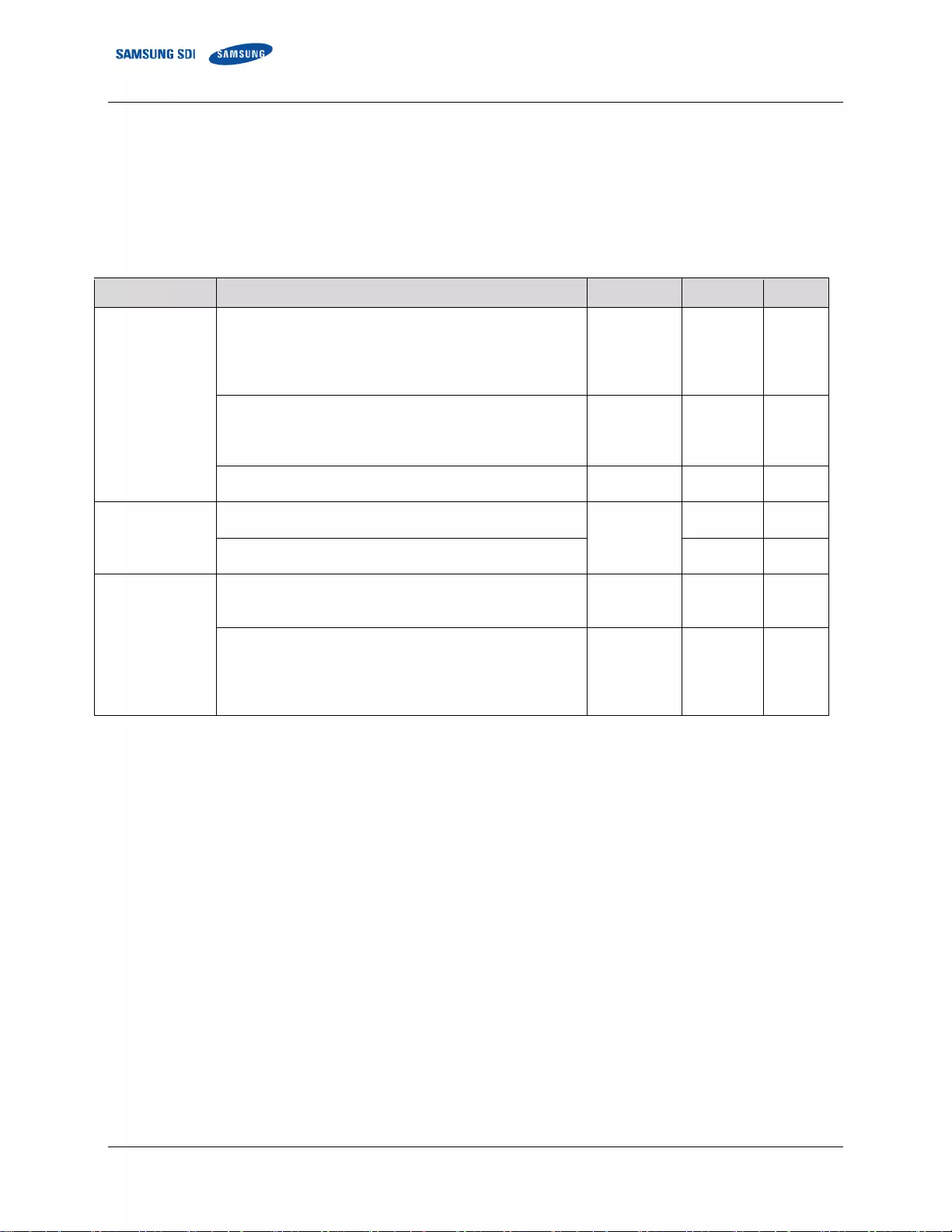
4. Maintenance Checks CONFIDENTIAL
34 English 8/2019. Rev 0.0
4.4 Maintenance Checklist
Refer to the following checklist template for scheduled checks. Detailed recordings may be necessary depending on
the level of maintenance required by the user. Use Table 3-10: Range of Operation to check the criteria for each
item.
Table 4-1: Maintenance Checklist Template
Items
Criteria
Location
Schedule
Result
Battery Status
1. Battery voltage
a) Rack voltage check
b) Cell voltage check (max/min difference)
2. Alarm or faults: No alarms or faults set
3. MCCB status: All on
Control room
Daily
1. Alarm or protection: No alarms or protections set
Check the indicator LED’s in each rack
2. MCCB status: All on
Check the position of the MCCB handle
On-Site
Weekly
1. Visual Inspection: check for physical damages
(rust, bent structure, damaged or missing cables, etc.)
On-Site
Monthly
Environment
Temperature (measured from facility’s HVAC unit or other
measurement devices)
Control Room
or On-Site
Daily
Humidity (measured from facility’s HVAC unit or other
measurement device)
Daily
Recorded Data
1. Recorded voltage and current
2. Date and time of charge and discharge cycles
3. Number of alarms and faults recorded
Control Room
Monthly
1. Recorded voltage and current
2. Date and time of charge and discharge cycles
3. Number of alarms and faults recorded
4. Record of temperature and humidity (measured from
facility’s HVAC unit or other measurement device)
Control Room
Annual
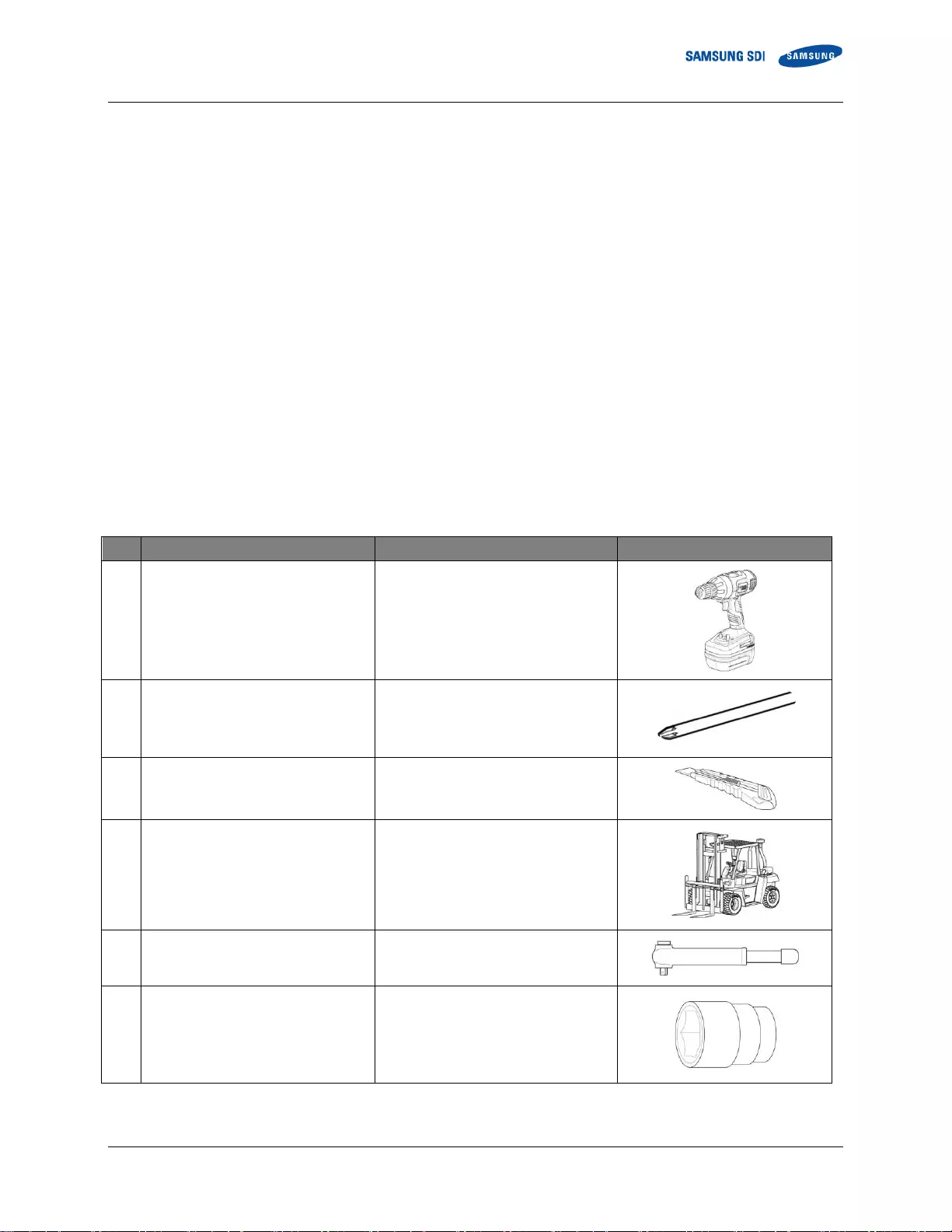
CONFIDENTIAL 5. Troubleshooting, Repair and Replacement
English 8/2019. Rev 0.0 35
5. Troubleshooting, Repair and Replacement
Users must operate the battery system within its specified range of operating conditions. Refer to the “Product
Specification” for details.
If the battery system is not operated under the specified conditions, it may display protective modes depending on
conditions. Users should familiarize themselves with the types of protective modes and the battery system’s
behavior during these modes. Dry contact signals from the System BMS and indicator LED’s on the front of each
SMU displays the status of the battery system. Users can quickly and easily determine the battery system’s status
from a centralized monitoring location using the dry contact signals or perform an on-site examination using the
indicator LED’s. Detailed status of the battery system can be examined by using additional monitoring software.
When additional examination is necessary, some tools and instruments may be required. Refer to the installation
manual and Table 5-1 “Recommended Tools and Instruments for Repair and Replacement” for the list of tools that
may be needed and instructions on how to use them.
If repair or replacement is required, refer to the installation manual for safety guidelines and basic information on
disassembly and reassembly of components.
Table 5-1: Recommended Tools and Instruments for Repair and Replacement
No.
Items
Use
Appearance
1
Power Screwdriver/Drill
(Maximum torque: 26Nm [270 kgf
cm])
Fastening SMU and SMPS assemblies to
the rack frames
(5.1–6.1Nm [50–60 kgf cm])
2
Phillips Screwdriver or Bit (M5 Tip)
Fastening SMU and SMPS assemblies to
the rack frames
3
Box Cutter
Opening boxes
4
Forklift
Moving pallets of modules and SMUs
5
Insulated Torque Wrench
Installing high-voltage cable
(10~50 Nm [100 ~ 500 kgf cm])
6
Insulated Sockets
(13 mm, 17mm and 19mm)
Installing power cables and busbars
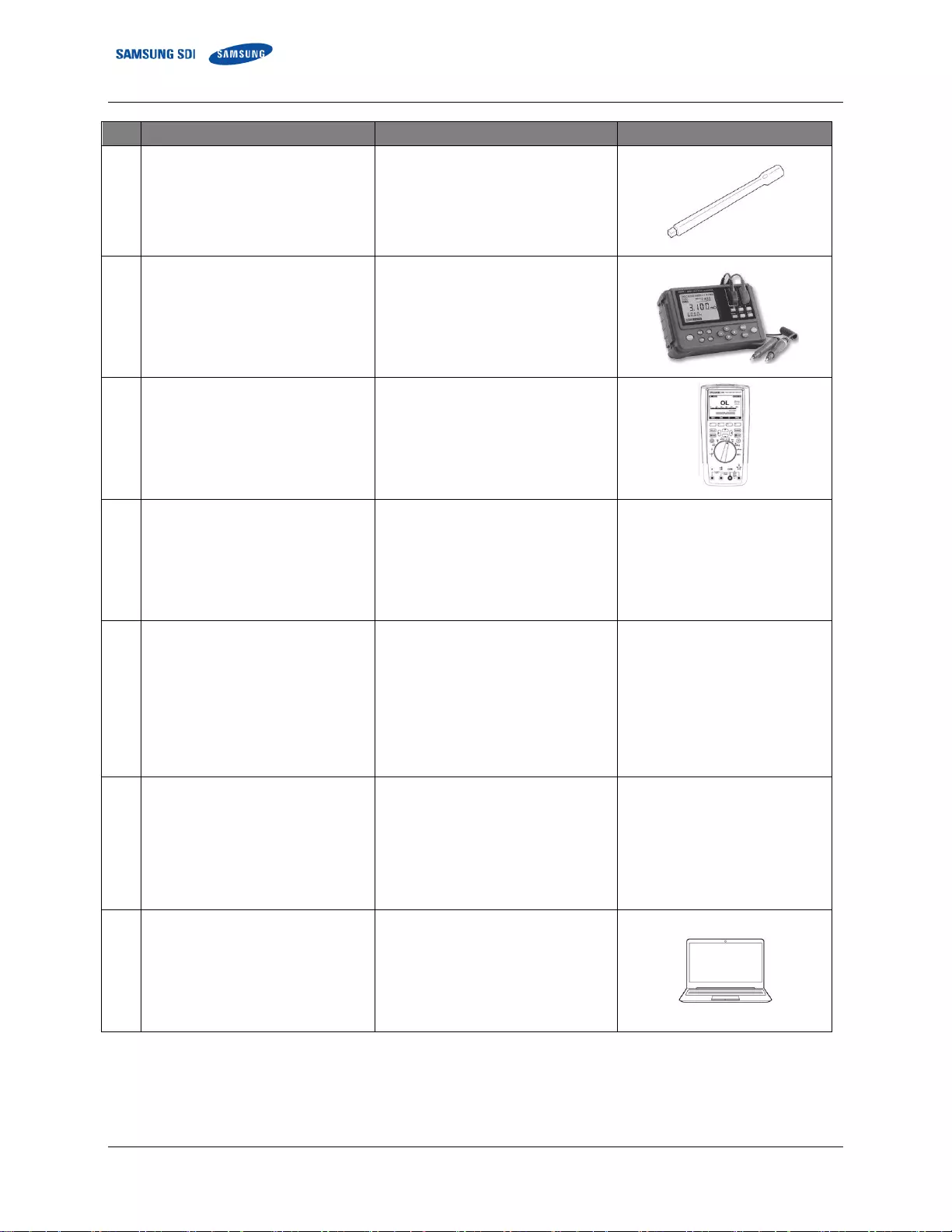
5. Troubleshooting, Repair and Replacement CONFIDENTIAL
36 English 8/2019. Rev 0.0
No.
Items
Use
Appearance
7
Insulated Extension Bar for Sockets
Installing a power cable
8
Battery Tester
Measuring battery modules’ voltage
and internal impedance
9
Digital Multimeter
Measuring battery string’s voltage
Probes must be rated for 600V DC or
above
10
DC Ammeter (Clamp Meter)
Measuring battery string’s current
Must be rated for DC 1000A or above
–
11
Controllable DC Load
Recommended Specifications
1) Input DC 40V or above
2) 1kW or above
3) Controllable with 10mV resolution
or less
4) CV discharge available
Discharging replacement battery
module
–
12
Controllable DC Power Supply
Recommended specifications
1) Output DC 40V or above
2) 1kW or above
3) Controllable with 10mV resolution
or less
4) CC-CV charge available
Charging replacement battery module
–
13
Computer
Microsoft® Windows® 7 SP1 (English)
or later recommended
Running battery monitoring software
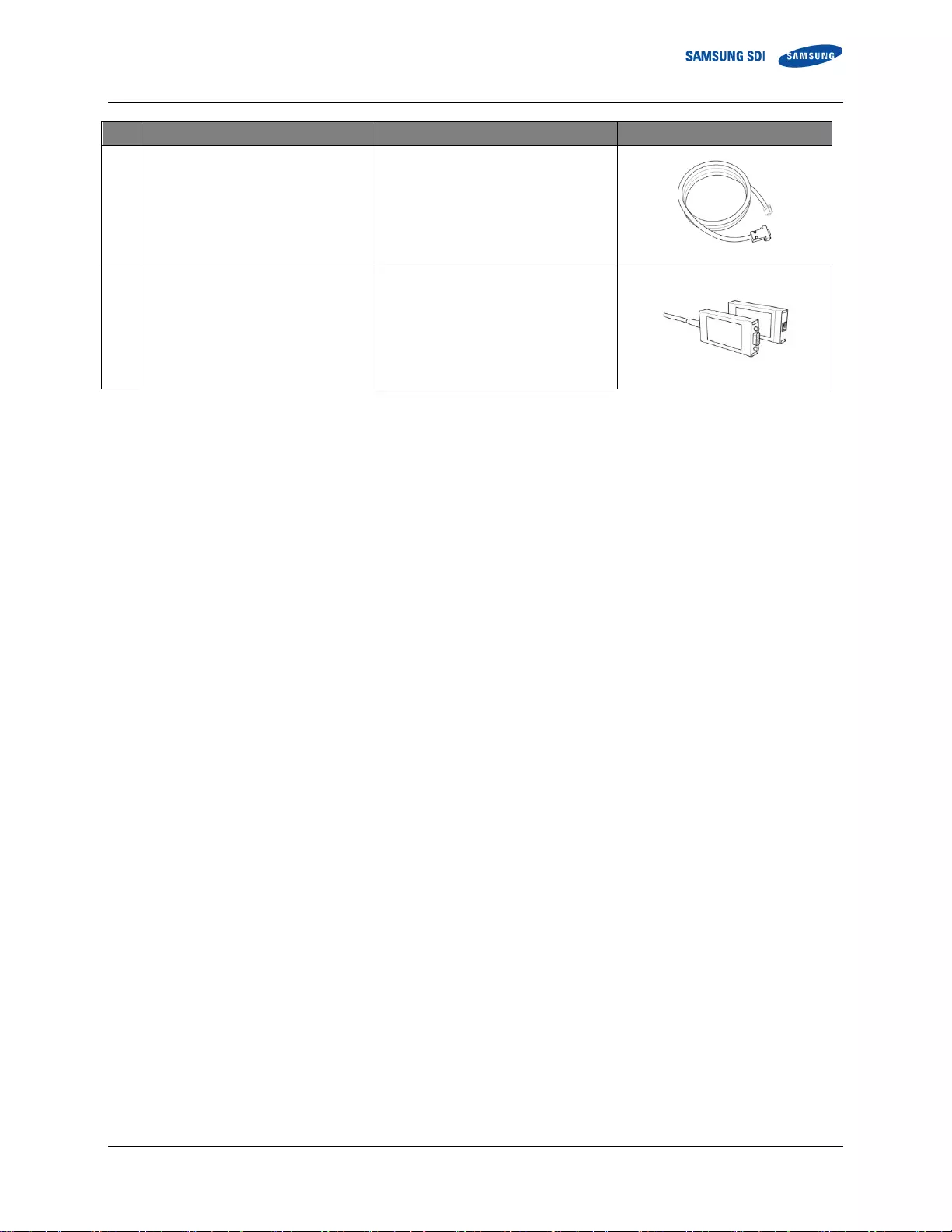
CONFIDENTIAL 5. Troubleshooting, Repair and Replacement
English 8/2019. Rev 0.0 37
No.
Items
Use
Appearance
14
Rack BMS ID Writer Cable
Use with computer
Battery monitoring software
15
IXXAT USB-to-CAN V2
Use with computer
Battery monitoring software

5. Troubleshooting, Repair and Replacement CONFIDENTIAL
38 English 8/2019. Rev 0.0
5.1 Troubleshooting
To determine the status of the battery system, users must use additional battery status monitoring software to
examine the protection mode. Refer to the installation manual about using the monitoring software. Also, refer to
Section 3.3 Operation Status for set and release conditions for each protection mode. Once the user knows the
protection mode, refer to the following sections for solutions.
5.1.1 Overvoltage Protection – Cell (Major Protection)
Possible Problem
Solution
Overcharged Cell
- Press the reset switch in SMPS Assembly and see if it clears the protection.
- Check the UPS settings for floating charge voltage. It must be set at 4.2V per cell
(i.e., for 136S system, 571.2V must be set as floating charge voltage
and for 128S system, 537.6V must be set as floating charge voltage)
- Check the dry contact signal cable for “charge stop” and see whether the “charge stop”
signal is correctly received by the UPS.
- Check the actual cell voltage data using monitoring software and see if there is a cell
voltage reading significantly higher than other battery cells. If so, cell balancing is
required. Refer to troubleshooting for voltage imbalance.
- If the problem persists, the module with the overcharged cell may have to be replaced.
Defective Wiring
- Remove the front cover of the module and check the Module BMS wiring.
- Press the reset switch in SMPS Assembly and see if it clears the protection.
Loose Busbar Installation
- Check the torque of the module and SMU busbars.
- Retighten any loose bolts.
Measurement Error
- Press the reset switch in SMPS Assembly and see if it clears the protection.
- Check the actual cell voltage data using monitoring software.
- Replace the Module BMS if the cell voltage is incorrect.
- If the problem persists, replace the battery module.
5.1.2 Undervoltage Protection – Cell (Major Protection)
Possible Problem
Solution
Deep-Discharged Cell
- Press the reset switch in the SMPS Assembly and see if it clears the protection.
- Check the UPS settings for the end-of-discharge voltage. It must be set at 3.0V per cell
(i.e., for 136S system, 408V must be set as the end-of-discharge voltage
and for 128S system, 384V must be set as end of discharge voltage).
- Check the actual cell voltage data using monitoring software and see if there is a cell
voltage reading significantly lower than for other battery cells. If so, cell balancing is
required. Refer to the Troubleshooting Section 5.2.5 “Cell Voltage Balancing.”
Defective Wiring
- Remove the Battery Module’s front and check the Module BMS wiring.
- Press the reset switch in the SMPS Assembly and see if it clears the protection.
Loose Busbar
- Check the torque of the module and SMU busbars.
- Retighten any loose bolts.
Measurement Error
- Press the reset switch in SMPS Assembly and see if it clears the protection.
- Check the actual cell voltage data using monitoring software.
- Replace the Module BMS if the cell voltage is incorrect.
- If the problem persists, replace the battery module.

CONFIDENTIAL 5. Troubleshooting, Repair and Replacement
English 8/2019. Rev 0.0 39
5.1.3 Overvoltage Protection – Rack (Major Protection)
Possible Problem
Solution
Overcharged Cell
- Check the UPS settings for floating charge voltage. It must be set at 4.2V per cell
(i.e., for 136S system, 571.2V must be set as floating charge voltage
and for 128S system, 537.6V must be set as floating charge voltage).
- Check the dry contact signal cable for “charge stop” and see if the “charge stop” signal is
correctly received by the UPS.
- Check the actual cell voltage data using monitoring software and see if there is a cell
voltage reading significantly higher than for other battery cells. If so, cell balancing is
required. Refer to Troubleshooting Section 5.2.5 “Cell Voltage Balancing.”
- If the problem repeats, the Battery Module with the overcharged cell may have to be
replaced.
Loose Busbar
- Check the torque of the module and SMU busbars.
- Retighten any loose bolts.
Measurement Error
- Check the actual rack voltage data using monitoring software.
- Replace the SMU if the rack voltage readings are incorrect.
5.1.4 Undervoltage Protection – Rack (Major Protection)
Possible Problem
Solution
Deep-Discharged Cell
- Check the UPS settings for end of discharge voltage. It must be set at 3.0V per cell.
(i.e., for 136S system, 408V must be set as end-of-discharge voltage.
and for 128S system, 384V must be set as the end-of-discharge voltage).
- Check the actual cell voltage data using monitoring software and see if there is a cell
voltage reading significantly lower than for other battery cells. If so, cell balancing is
required. Refer to Troubleshooting Section 5.2.5 “Cell Voltage Balancing.”
Loose Busbar
- Check the torque of the module and SMU busbars.
- Retighten any loose bolts.
Blown Fuse
- Check whether the “fuse failure” alarm is set.
- Check the status of the rack fuse.
- Replace any blown fuse and reset the system.
Measurement Error
- Check the actual rack voltage data using monitoring software
- Replace the SMU if the rack voltage is incorrect.
5.1.5 Voltage Imbalance (Major Protection)
Possible Problem
Solution
Imbalanced Cell
- Check the actual cell voltage data using monitoring software and see if there is a cell
voltage reading significantly higher or lower than for other battery cells. If so, cell
balancing is required. Refer to Troubleshooting Section 5.2.5 “Cell Voltage Balancing.”
Loose Busbar
- Check the torque of the module and SMU busbars.
- Retighten any loose bolts.
Defective Wiring
- Remove the front cover of the module and check the Module BMS wiring.
- Press the reset switch in the SMPS Assembly and see if it clears the protection.
Measurement Error
- Check the actual cell voltage data using monitoring software
- Replace the Module BMS if the cell voltage is incorrect.
- If the problem persists, replace the battery module.

5. Troubleshooting, Repair and Replacement CONFIDENTIAL
40 English 8/2019. Rev 0.0
5.1.6 Voltage Sensing Error (Minor Protection)
Possible Problem
Solution
Defective Wiring
- Remove the module’s front cover and check the Module BMS wiring.
- Press the reset switch in the SMPS Assembly and see if it clears the protection.
Loose busbar
- Check the torque of the module and SMU busbars.
- Retighten any loose bolts.
Measurement Error
- Check the actual cell voltage data using monitoring software.
- Check the actual rack voltage data using monitoring software.
- Measure the rack voltage and each module’s voltage using a digital multimeter and
compare the readings to the data obtained from the monitoring software. To measure the
rack’s voltage, a multimeter with proper probe rating must be used.
- If module voltage reading is not correct, determine which module has the incorrect
voltage and check its Module BMS connection. If the problem persists, replace the module
BMS.
- If the problem persists, the module must be replaced.
- Replace the SMU if the rack voltage is incorrect.
5.1.7 Overtemperature Protection (Major Protection)
Possible Problem
Solution
Defective Wiring
- Remove the module’s front cover and check the Module BMS wiring.
- Press the reset switch in the SMPS Assembly and see if it clears the protection.
Measurement Error
- Check the actual cell temperature data using monitoring software.
- If cell temperature reading is not correct, check the connection of Module BMS.
- If the problem persists, the module must be replaced.
Defective Thermistor
- If the thermistor inside the Battery Module is defective (short), the temperature may be
fixed at 95℃. Battery Module must be replaced.
Improper Ventilation
- Make sure the rack frame is placed so that air can flow naturally through the frame.
- Forced air convection may be used.
5.1.8 Undertemperature Protection (Minor Protection)
Possible Problem
Solution
Defective Wiring
- Remove the module’s front cover and check the Module BMS wiring.
- Press the reset switch in SMPS Assembly and see if it clears the protection.
Measurement Error
- Check the actual cell temperature data using monitoring software.
- If cell temperature reading is not correct, check the connection of the Module BMS.
- If the problem persists, the Module must be replaced.
Defective Thermistor
- If the thermistor inside the Battery Module is defective (open), the temperature may be
set at -30°C. Battery Module must be replaced.
5.1.9 Temperature Imbalance (Major Protection)
Possible Problem
Solution
Defective Wiring
- Remove the module’s front cover and check the Module BMS wiring.
- Press the reset switch in the SMPS Assembly and see if it clears the protection.
Measurement Error
- Check the actual cell temperature data using monitoring software.
- If cell temperature reading is not correct, check the connection of Module BMS.
Defective Thermistor
- If the thermistor inside the Battery Module is defective, the temperature may be set at -
30℃ if opened or 95℃ if shorted. Battery module must be replaced.

CONFIDENTIAL 5. Troubleshooting, Repair and Replacement
English 8/2019. Rev 0.0 41
Possible Problem
Solution
Improper Ventilation
- Make sure that the rack frame is placed so that air can flow naturally through the frame.
- Forced air convection may be used to provide extra cooling.
5.1.10 Overcurrent Protection (Charge) (Major Protection)
Possible Problem
Solution
Adjacent Rack Disconnected
(multiple rack configuration only)
- Current flow may be concentrated in a multiple rack configuration if only some racks are
connected and some are disconnected.
- Make sure that the MCCB in all racks are in the “on” position.
Inrush Current from Adjacent Rack
(multiple rack configuration only)
- If there is a voltage difference between the racks, there may be inrush current from rack
to rack.
- Measure the rack’s inrush current in all conditions using a clamp meter.
- Match the rack’s voltage by installing modules with similar voltage for different strings.
Inrush Current from UPS
- Use a clamp meter to measure the inrush current when the UPS is initially switched on.
- Condition the UPS DC bus to reduce or eliminate the inrush.
Measurement Error
- Check the current readings using the monitoring program.
- If the values are sporadic, the BMS may be malfunctioning.
- If the values are constant but incorrect, the BMS may be calibrated incorrectly.
- Replace the SMU.
5.1.11 Overcurrent Protection (Discharge) (Major Protection)
Possible Problem
Solution
Adjacent Rack Disconnected
(multiple rack configuration only)
- Current flow may be concentrated in a multiple rack configuration if some racks are
connected and some are disconnected.
- Make sure that the MCCB in all racks are in the “on” position.
Inrush Current from Adjacent Rack
(multiple rack configuration only)
- If there is a voltage difference between the racks, there may be inrush current from rack
to rack.
- Use a clamp meter to measure the rack’s inrush current in all conditions.
- Match the rack’s voltage by installing modules with similar voltage for different strings.
Inrush Current from UPS
- Use a clamp meter to measure the inrush current when the UPS is initially switched on.
- Condition the UPS DC bus to reduce or eliminate the inrush.
Measurement Error
- Check the current readings using the monitoring program.
- If the values are sporadic, BMS may be malfunctioning.
- If the values are constant but incorrect, BMS may be calibrated incorrectly.
- Replace the SMU.
5.1.12 Communication Failure (Module ↔ Rack) (Major Protection)
Possible Problem
Solution
Defective Signal Cable
- Replace the signal cable between the SMU and the module.
- Replace the signal cables between the modules.
Defective Module BMS
- Check the LED on the Module BMS.
- If it is not blinking, replace the Module BMS.
5.1.13 Communication Failure (Rack ↔ System) (Major Protection)
Possible Problem
Solution
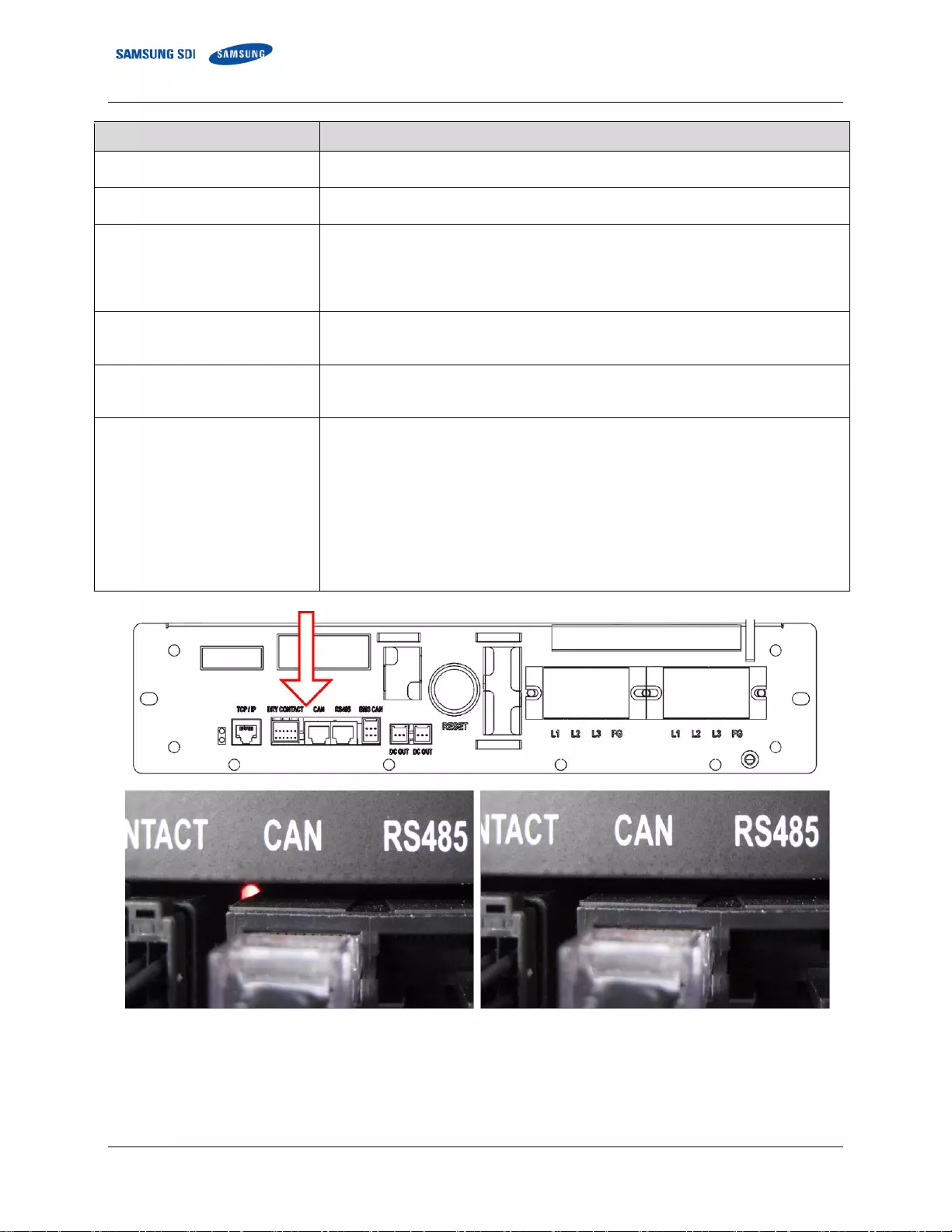
5. Troubleshooting, Repair and Replacement CONFIDENTIAL
42 English 8/2019. Rev 0.0
Possible Problem
Solution
Signal Termination
- Make sure that the communication terminating switch is on for the SMU that is farthest
from the SMPS Assembly Type A.
Defective Signal Cable
- Replace the signal cable between the SMU and the SMPS Assembly.
- Press the reset switch in the SMPS Assembly.
Adjacent Rack not Powered
- Check the indicator LED of adjacent racks.
- If the POWER LED is not on, make sure that the AC input cables to its own SMPS
Assembly are connected correctly and securely.
- Check the power cables from the “DC OUT” port of the SMPS Assembly to the SMU’s
“DC IN” port and make sure they are installed correctly.
Incorrect Rack BMS Configuration
- The Rack BMS CAN ID may be set incorrectly.
- Refer to the installation manual for BMS configuration and try setting the CAN ID again.
- Reset the system by pressing the reset switch in the SMPS Assembly.
Defective Rack BMS
- Check the status of the indicator LED’s.
- If all four LED’s are on or all off, the Rack BMS may be damaged.
- Replace the SMU.
Defective System BMS
- Check the communication from the SMPS Assembly data ports (TCP/IP or RS485) using
the monitoring software and, if available, using an oscilloscope to check the waveform of
the data signals.
- Check the status of the LED inside the SMPS Assembly. Refer to Figure 5-1. System BMS
LED
If there is only steady red LED, reset the System BMS by removing then reapplying the AC
power to the SMPS Assembly (power-on reset).
At least one or more red LED should be blinking inside the SMPS Assembly after power-on
reset.
- Replace the SMPS Assembly if there is no blinking red LED even after a power-on reset.
Figure 5-1. System BMS LED

CONFIDENTIAL 5. Troubleshooting, Repair and Replacement
English 8/2019. Rev 0.0 43
5.1.14 Communication Failure (System BMS ↔ Monitoring Software)
Possible Problem
Solution
System BMS improperly initiated
- Check the communication from the SMPS Assembly data ports (TCP/IP or RS485) using
the monitoring software and, if available, using an oscilloscope to check the waveform of
the data signals.
- Check the status of the LED inside the SMPS Assembly.
Refer to Figure 5-1. System BMS LED
If there is only steady red LED or no LED on, reset the System BMS by removing then
reapplying the AC power to the SMPS Assembly (power-on reset). At least one or more
red LED should be blinking inside the SMPS Assembly after power-on reset.
- If the problem persists, refer to 5.1.19. BMS Power is Off.
5.1.15 MCCB Failure (Minor Protection)
Possible Problem
Solution
Defective Rack BMS
- Press the reset switch in the SMPS Assembly and see if it clears the protection.
- Make sure that the MCCB handle is in the “trip” or “off” position.
- Measure the current using monitoring software while the battery is idle.
- If measured current is not 0A, the current sensing units may be malfunctioning.
- Replace the SMU.
Defective MCCB
- Press the reset switch in the SMPS Assembly and see if it clears the protection.
- Make sure that the MCCB handle is in the “trip” or “off” position.
- Check the continuity between the “B-” terminal and the “P-” terminal.
- If there is continuity between the two terminals, the MCCB is defective.
- Replace the SMU.
Defective Auxiliary Unit
- Move the MCCB handle to the “on” position.
- Use the monitoring software to check the status of the MCCB.
- If the MCCB status is “off,”the MCCB auxiliary unit may be malfunctioning.
- Replace the SMU.
5.1.16 MCCB Sensor Failure (Minor Protection)
Possible Problem
Solution
Defective Auxiliary Unit
- Press the trip button on the MCCB to trip it. Shift the MCCB handle to “off,” then to the
“on” position.
- Press the reset switch in the SMPS Assembly.
- If the alarm is not cleared, the rack BMS may be defective.
Defective Rack BMS
- Press the reset switch in the SMPS Assembly and see if it clears the protection.
- If the problem persists, replace the SMU.
5.1.17 Current Sensing Error (Minor Protection)
Possible Problem
Solution
Defective Internal Wiring
- Press the reset switch in the SMPS Assembly and see if it clears the protection.
- Measure the current using monitoring software during charge or discharge.
- If there is no reading, there may be a defect in the Rack BMS or the internal wirings in
the SMU. Replace the SMU

5. Troubleshooting, Repair and Replacement CONFIDENTIAL
44 English 8/2019. Rev 0.0
5.1.18 Fuse Failure (Minor Protection)
Possible Problem
Solution
Fuse Blown
- When the MCCB is in the “on” position, check the continuity between the “B-” terminal
and “P-” terminal.
- If there is no continuity between the two terminals, the fuse is blown and must be
replaced. Replace the SMU.
Defective Fuse Switch
- If the fuse is not blown, the switch above the fuse may be malfunctioning.
- Replace the SMU.
5.1.19 BMS Power is Off
Possible Problem
Solution
Incorrect Cabling
- Check the cable connection to the terminal block on the front side of the SMPS
Assembly.
- Check the cable connection between the SMPS Assembly “DC OUT” and SMU “DC IN.”
AC Input Fuse Blown
- Remove the SMPS Assembly and remove the top cover.
- Check the continuity of the AC input fuse holder.
- If any fuse is blown, replace the SMPS Assembly.
Defective SMPS
- If all AC input connections are correctly installed and energized, but the BMS is not being
powered, the SMPS Assembly may be defective. Replace the SMPS Assembly.
5.1.20 MCCB Handle Cannot be Set to “On”
Possible Problem
Solution
UPS Signaling the MCCB to Open
- Check the status of the UPS. Typical operation and end of discharge or due to an
emergency power off will result in a trip signal to the battery MCCB’s. The MCCB’s will be
prevented from closing until the UPS signal is removed.
System in Fault Status
- Check the indicator LED on the front side of the SMU
- If the FAULT LED (red LED) is blinking, the major protection (fault) status is set.
- Major protection must be cleared before setting the MCCB to “on.”
- Press the reset button in SMPS Assembly Type A to clear the protection.
SMPS not Powered
- Check the AC input connection.
- Check if the AC input is energized.
- If all AC input connections are correctly installed and energized, SMPS Assembly may be
defective. Replace the SMPS Assembly.
Defective Cable
- Check the cable connection to DC IN
- If the cable is defective, replace the DC IN cable
Defective MCCB Unit
- Replace the SMU
Defective Rack BMS
- Check the indicator LED on the front side of the SMU.
- If the indicator LED is not operational or if all LED’s are on, the Rack BMS may be
defective.
- Replace the SMU.
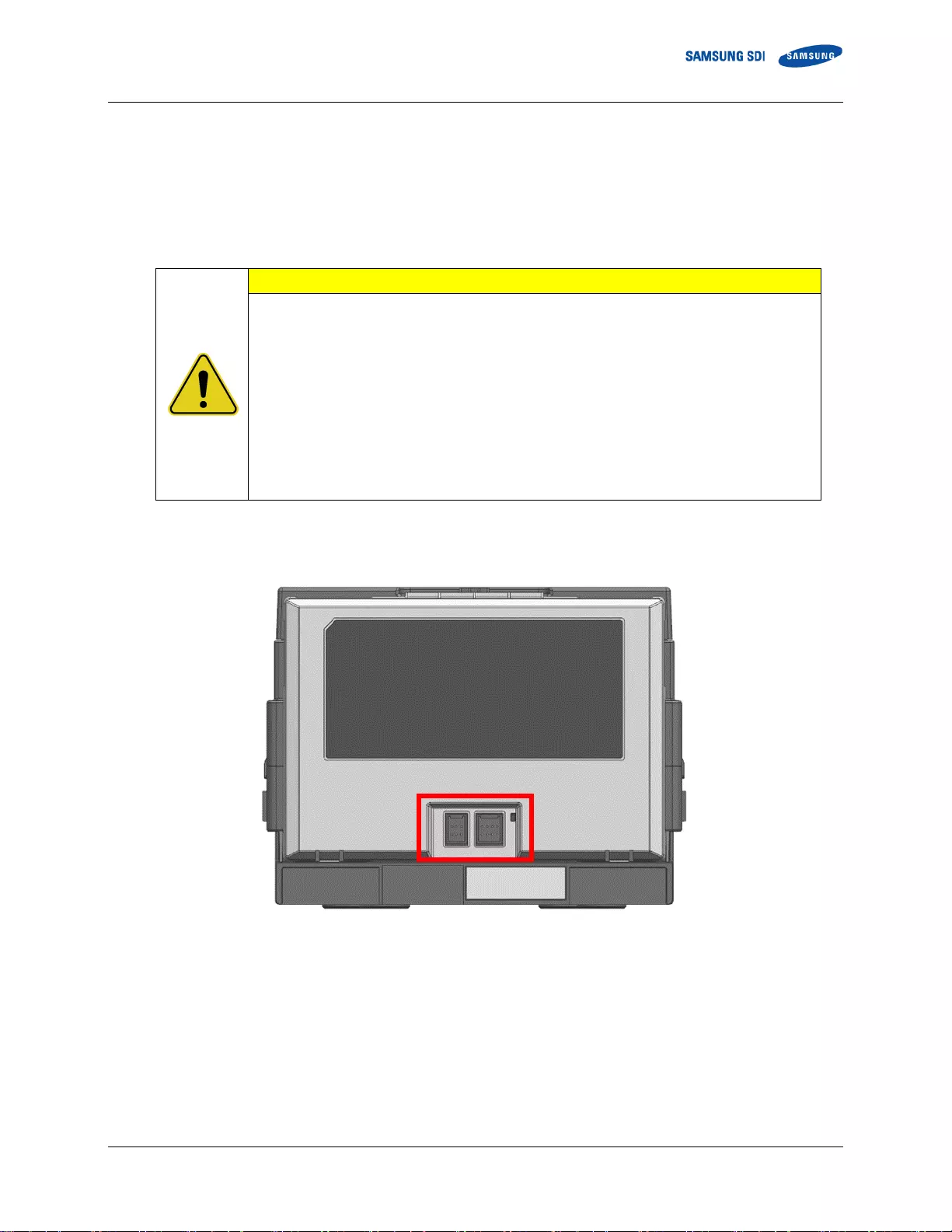
CONFIDENTIAL 5. Troubleshooting, Repair and Replacement
English 8/2019. Rev 0.0 45
5.2 Repair Procedures
Service personnel can resolve some problems by performing the following procedures without having to call
Samsung SDI’s customer service.
5.2.1 Module BMS Connection Check
CAUTION
Follow the instructions to protect the Module BMS against damage.
Important: DO NOT deviate from the sequence of steps.
The voltage of the connected system increases proportionally as battery modules are
connected. Exercise extreme caution to prevent the terminals from touching anything other
than their intended mounting points.
Terminals and their connected wires have either positive or negative polarity (Positive: B+, P+;
Negative: B-, P-). The polarity of a terminal or a wire connected to the terminal is on the front
of each module and SMU. To prevent a potentially dangerous short circuit, use extreme caution
to prevent terminals and/or wires with opposite polarity from contacting each other.
Do not permit either battery terminal to contact the rack frame because it is possible to contact
a connection with the opposite polarity.
Check the following points to make sure the Module BMS is connected correctly.
1. Check the wire connection to the signal connectors. Make sure they are firmly inserted into the connector.
Figure 5-2: Signal Connectors
2. Remove the front cover to check the voltage and temperature sensing connectors.
Press the hook on the bus bar openings and pull the front cover towards the front to remove.
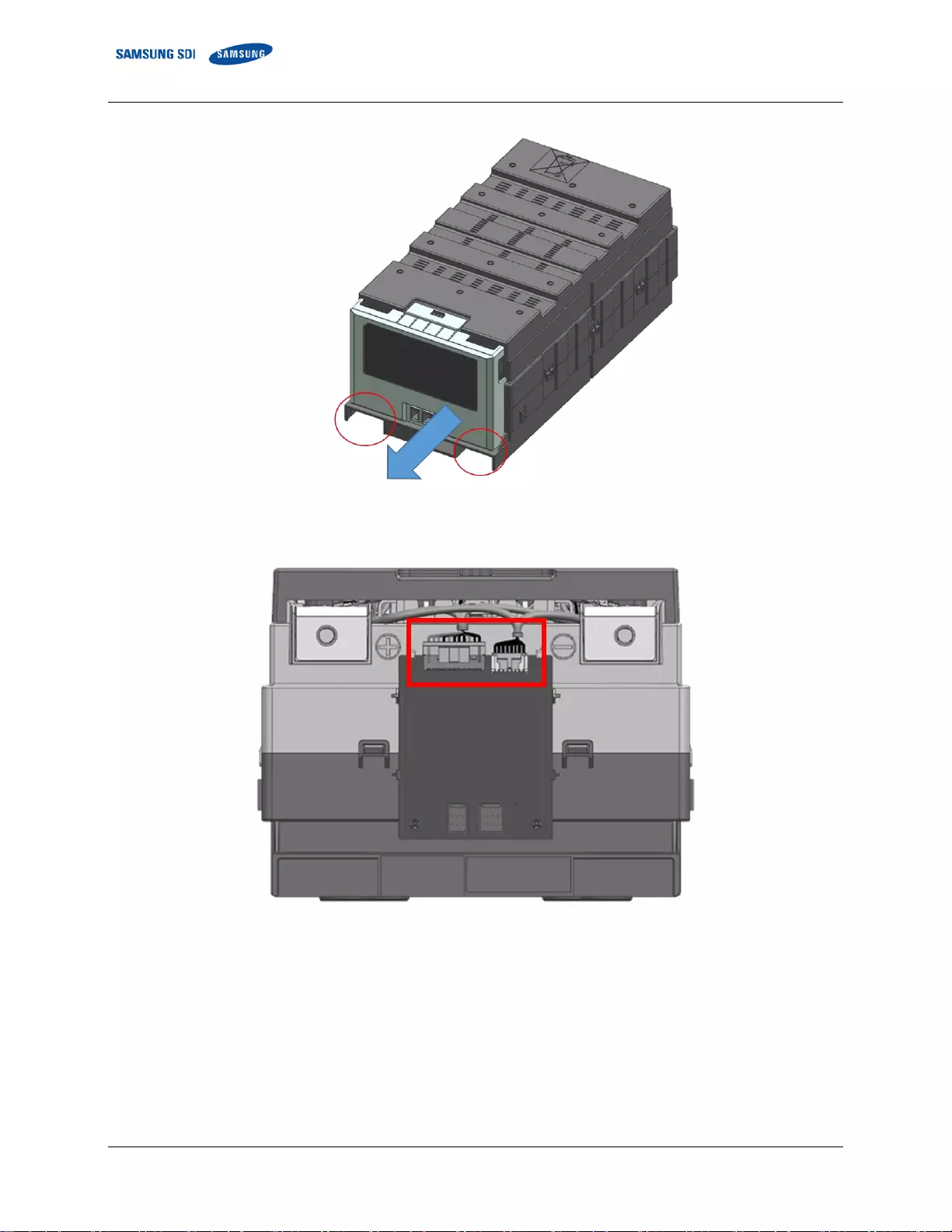
5. Troubleshooting, Repair and Replacement CONFIDENTIAL
46 English 8/2019. Rev 0.0
Figure 5-3: Removing the Battery Module Front Cover
3. Make sure that the voltage and temperature sensing wires are firmly inserted into the connector.
Figure 5-4: Voltage and Temperature Sensing Connectors
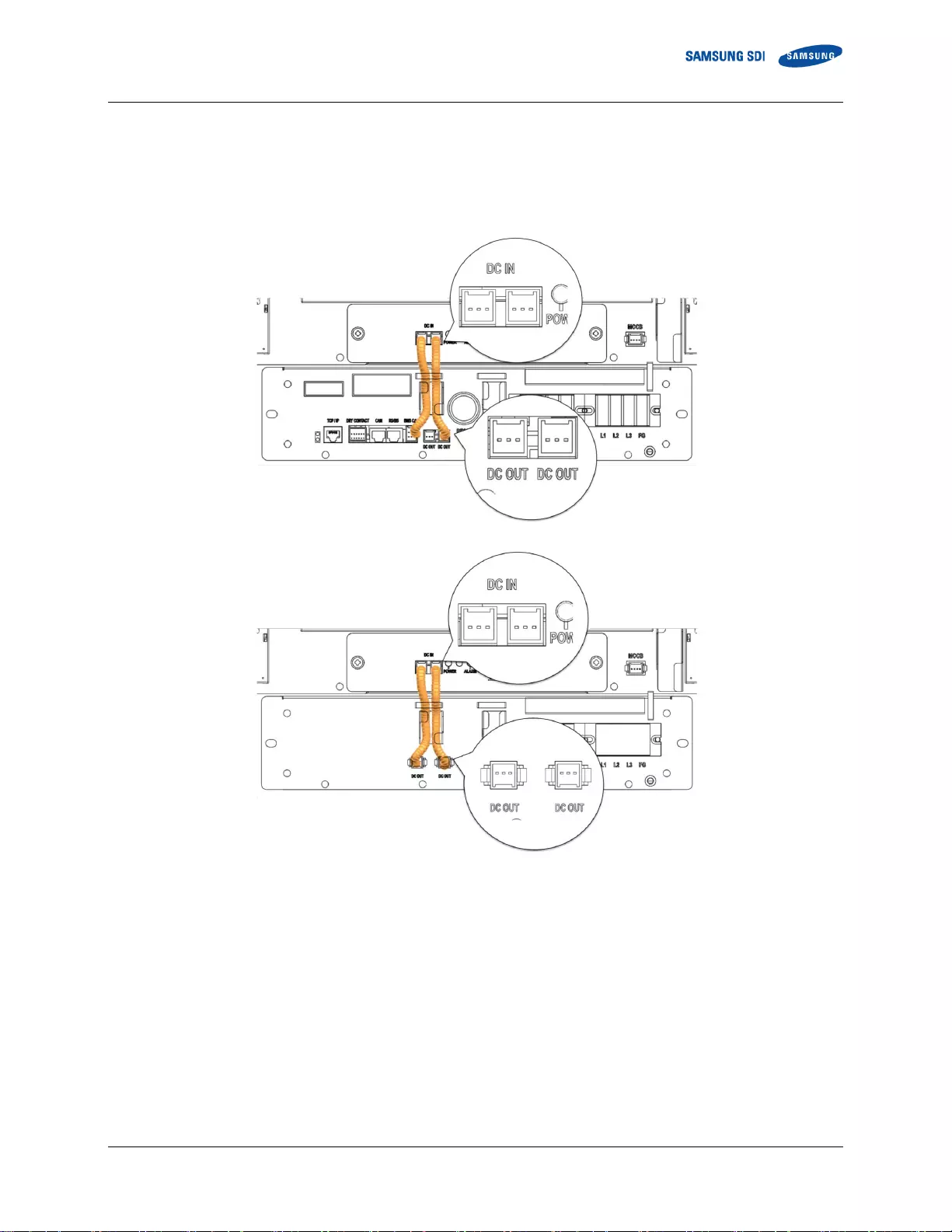
CONFIDENTIAL 5. Troubleshooting, Repair and Replacement
English 8/2019. Rev 0.0 47
5.2.2 SMU Connection Check
Check the following points to make sure the SMU is connected correctly.
1. Check the wire connection to the “DC IN” connectors. Both wires must be firmly inserted into the
connectors.
Figure 5-5: DC Power Cables from SMPS Assembly Type A to SMU
Figure 5-6: DC Power Cables from SMPS Assembly Type B to SMU
2. Check the CAN connections to the SMU. For the rack with the SMPS Assembly Type A, one of the
connections must be made to the SMPS Assembly. A termination resistor switch must be turned on in the
rack that is farthest from the rack with SMPS Assembly Type A. Refer to Figure 5-9: Termination resistor
setting.
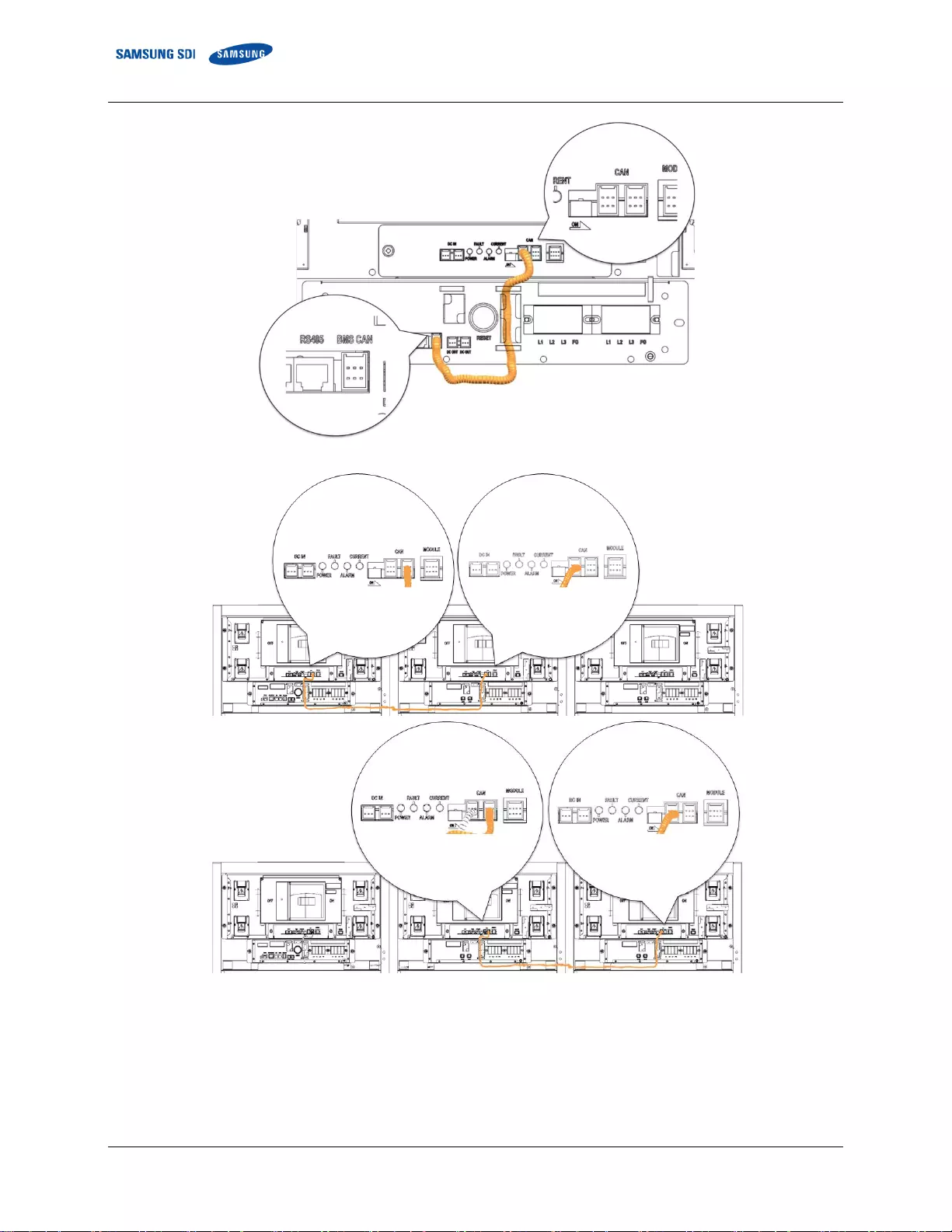
5. Troubleshooting, Repair and Replacement CONFIDENTIAL
48 English 8/2019. Rev 0.0
Figure 5-7: CAN Signal Cable Connection from SMPS Assembly to SMU
Figure 5-8: Signal Cabling Examples of Left Alignment of SMUs
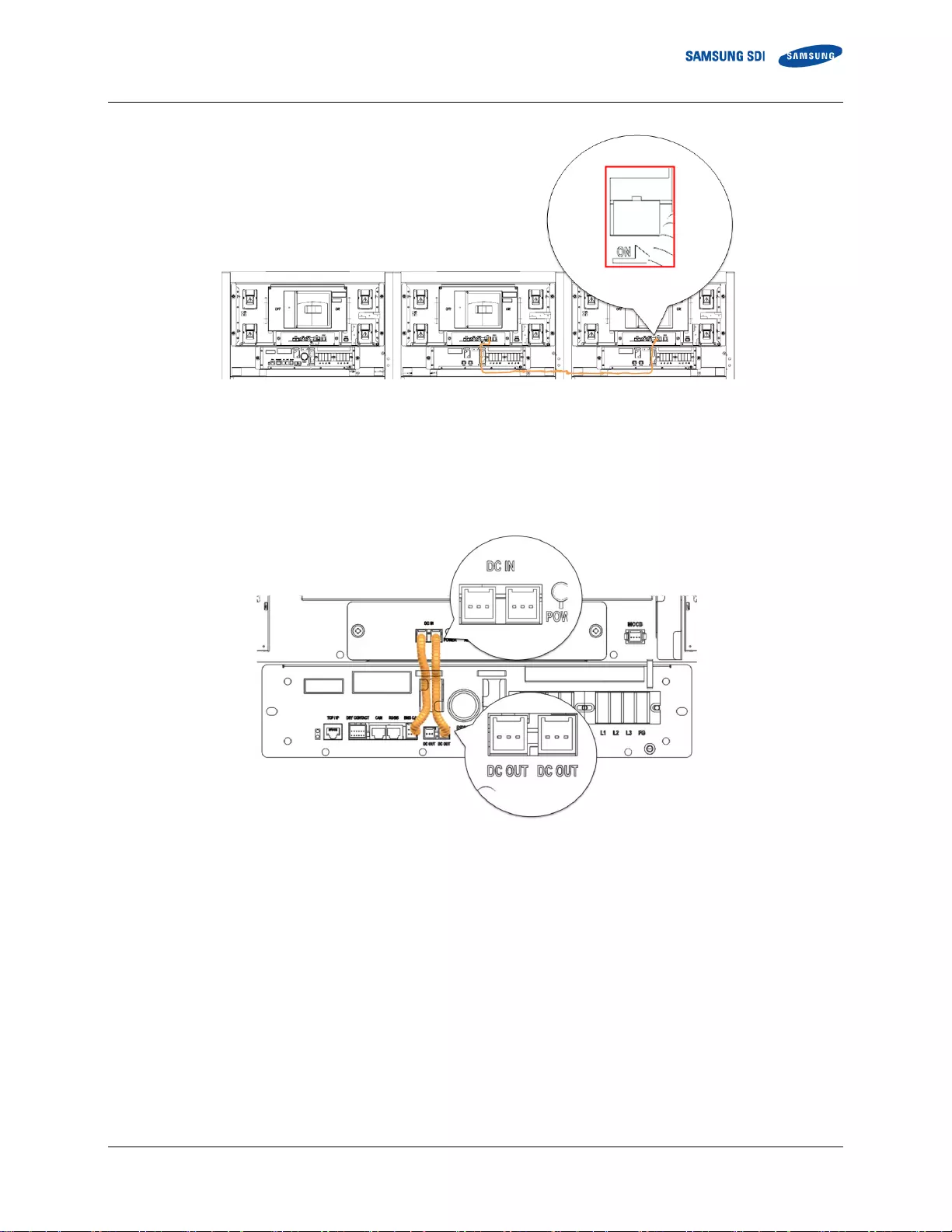
CONFIDENTIAL 5. Troubleshooting, Repair and Replacement
English 8/2019. Rev 0.0 49
Figure 5-9: Termination resistor setting
5.2.3 SMPS Assembly Connection Check
1. Check the wire connection to the “DC OUT” connectors. Both wires must be firmly inserted into the
connectors.
Figure 5-10: DC Power Cables from SMPS Assembly Type A to SMU
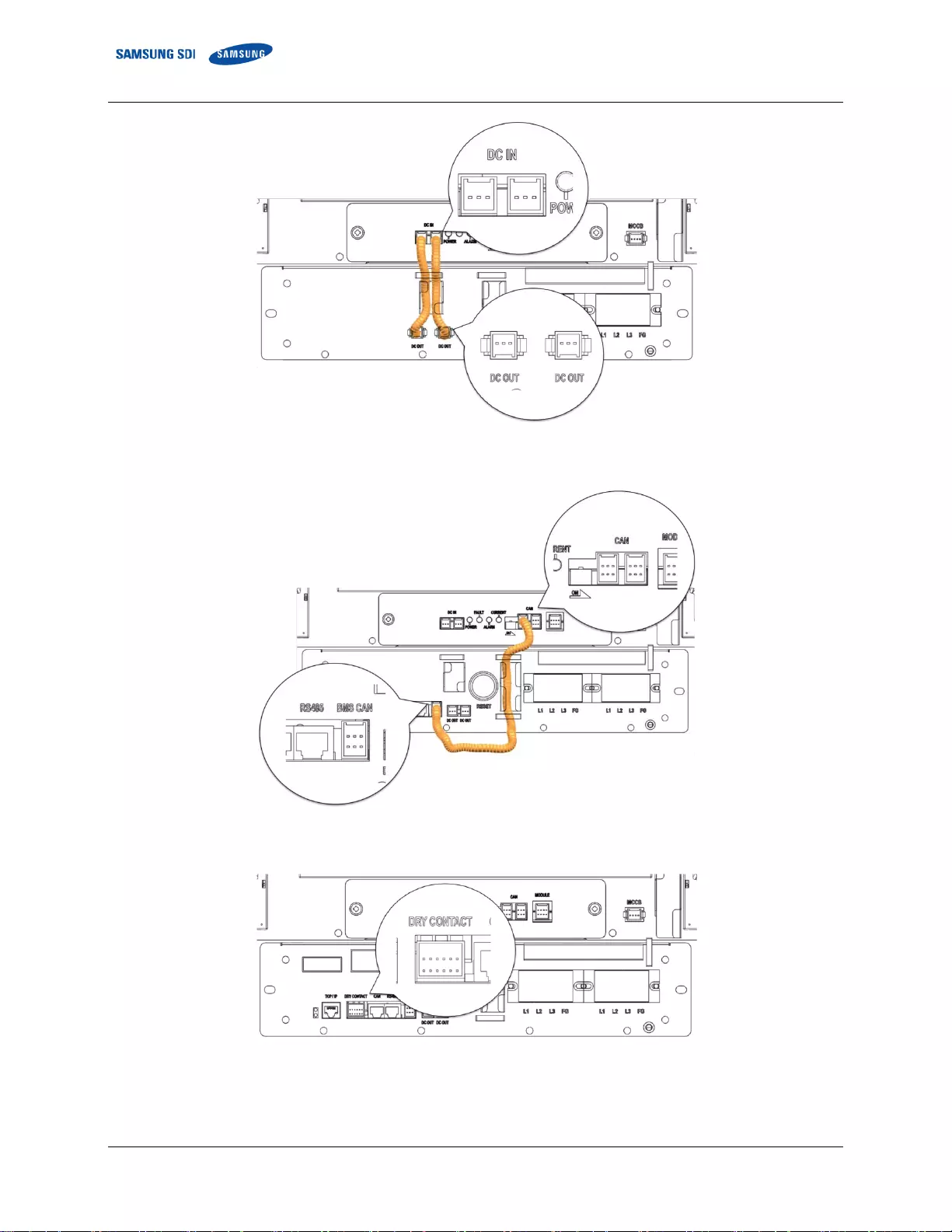
5. Troubleshooting, Repair and Replacement CONFIDENTIAL
50 English 8/2019. Rev 0.0
Figure 5-11: DC Power Cables from SMPS Assembly Type B to SMU
2. Check the CAN connections to the SMU.
Figure 5-12: CAN Signal Cable Connection from SMPS Assembly to SMU
3. Check the dry contact connector.
Figure 5-13: Dry Contact Cable Connection to SMPS Assembly
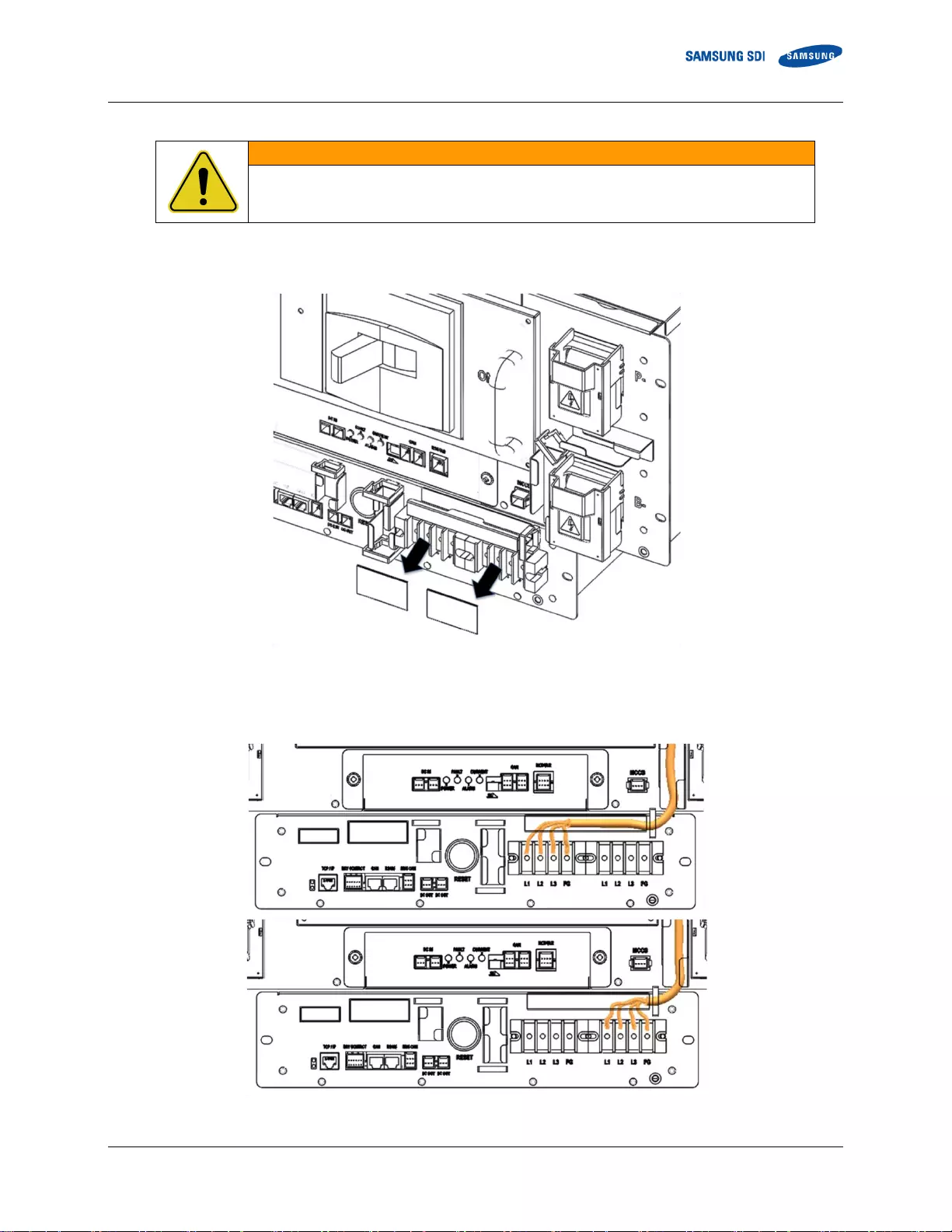
CONFIDENTIAL 5. Troubleshooting, Repair and Replacement
English 8/2019. Rev 0.0 51
WARNING
Before checking the AC input terminal connections, make sure they are not energized.
4. Check the AC input terminal. Remove the protective cover.
Figure 5-14: AC Input Terminals
5. Check each AC input in the SMPS Assembly.
Figure 5-15: AC Input Terminals with Cables Attached
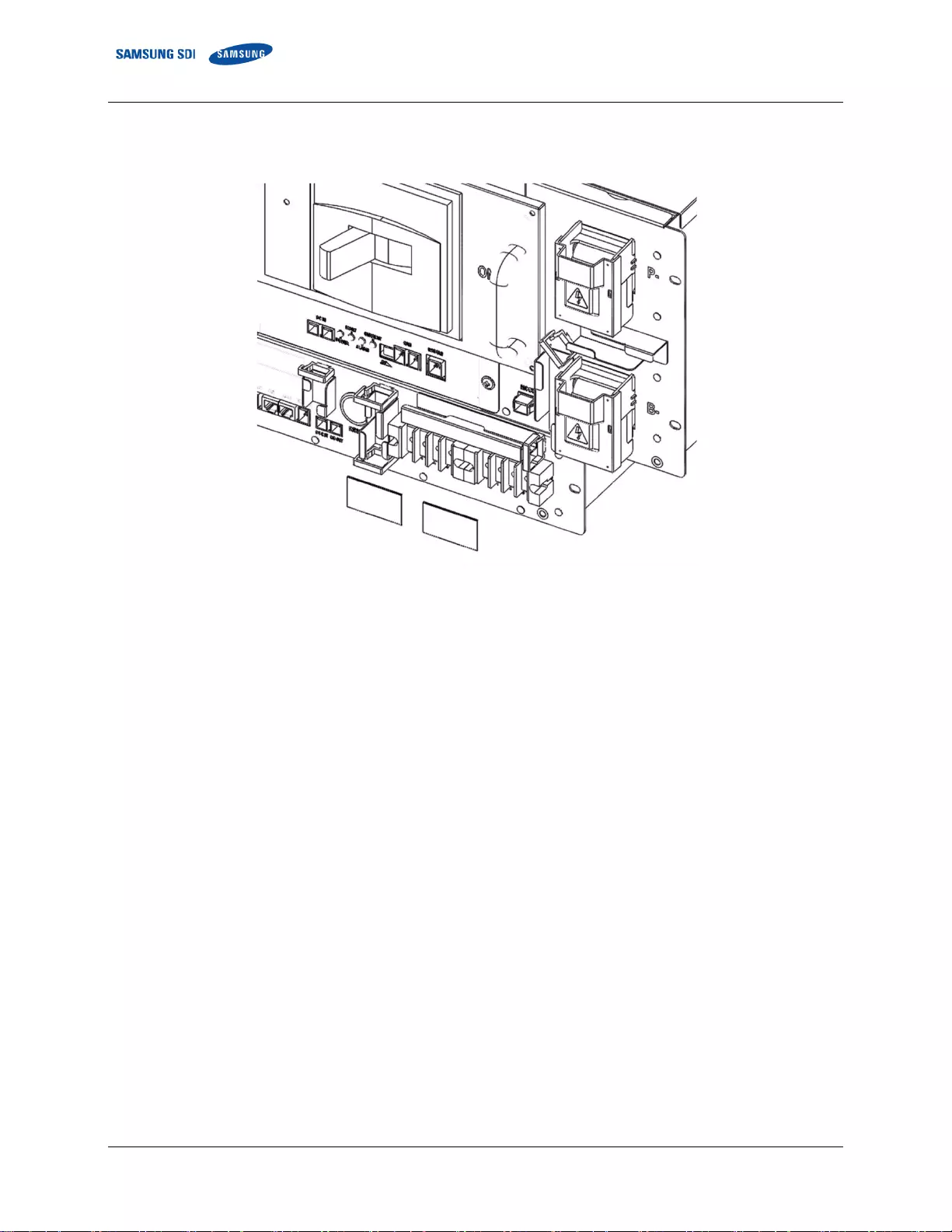
5. Troubleshooting, Repair and Replacement CONFIDENTIAL
52 English 8/2019. Rev 0.0
6. Reattach the protective covers to the AC input terminals.
Figure 5-16: AC Input Terminals Protective Covers
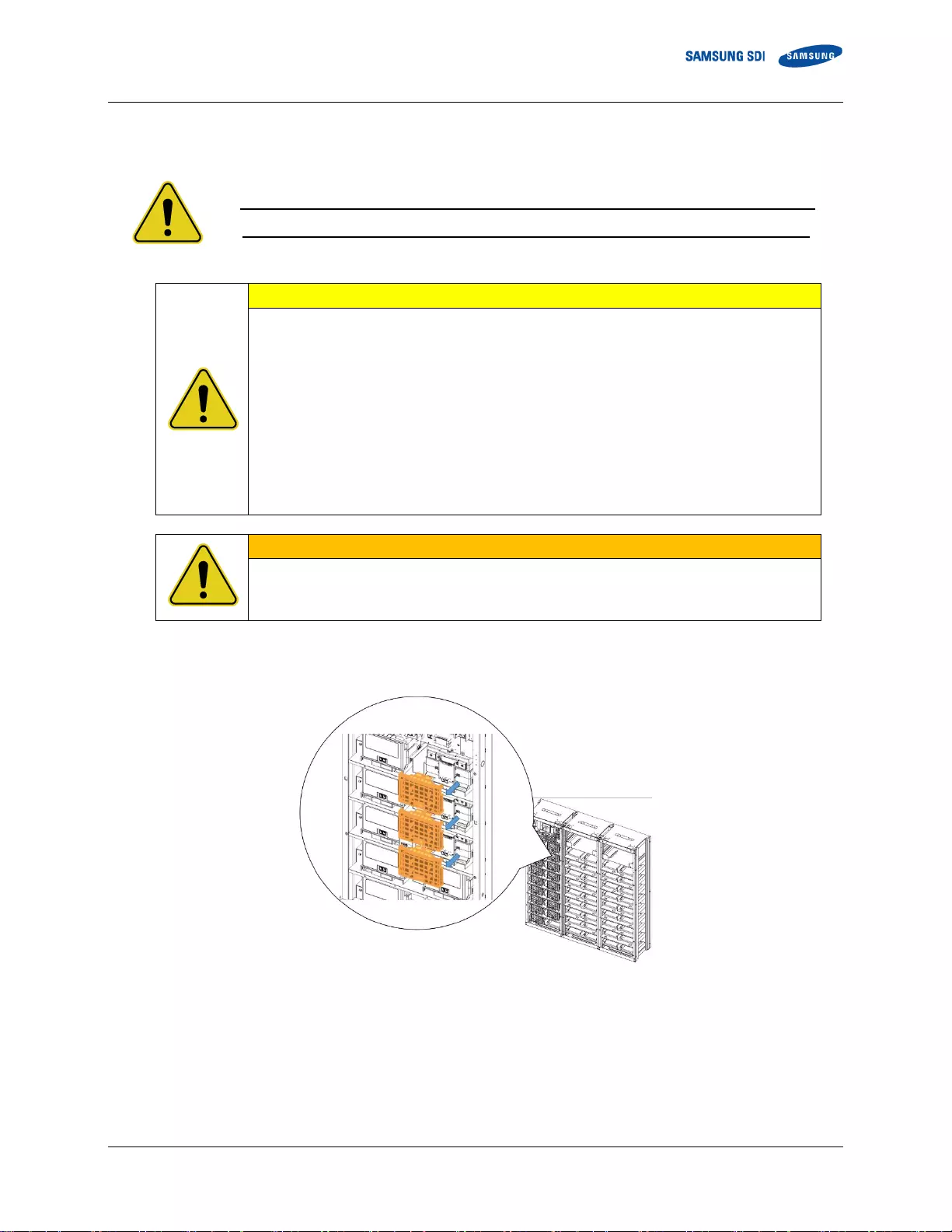
CONFIDENTIAL 5. Troubleshooting, Repair and Replacement
English 8/2019. Rev 0.0 53
5.2.4 Busbar Connection Check
Verify for zero energy state or isolation between racks (strings)!
Make sure that the UPS interface is locked out and tagged out!
CAUTION
Follow the instructions exactly to protect the module BMS from damage.
Important: DO NOT deviate from the sequence of the steps below.
The voltage of the connected system increases proportionally as battery modules are
connected. Exercise extreme caution to prevent the terminals from touching anything except
their intended mounting points.
Terminals and their connected wires have either positive or negative polarity (Positive: B+, P+;
Negative: B-, P-). The polarity of a terminal or a wire connected to the terminal is on the front
of each module and SMU. Exercise extreme caution to prevent terminals and/or wires with
opposite polarity from contacting each other.
Do not permit either battery terminal to contact the rack frame because it is possible to contact
a connection with the opposite polarity.
WARNING
Covers protect the power terminals on Battery Modules and SMU Assemblies to guard against
a short circuit. Power terminal covers must be removed before connecting a power busbar. The
covers must be reattached immediately.
Verify that the bolts connecting the busbars are properly torqued..
1. Remove the Battery Module front covers and SMU B+, B-, P+, P- covers.
Figure 5-17: Remove the front covers
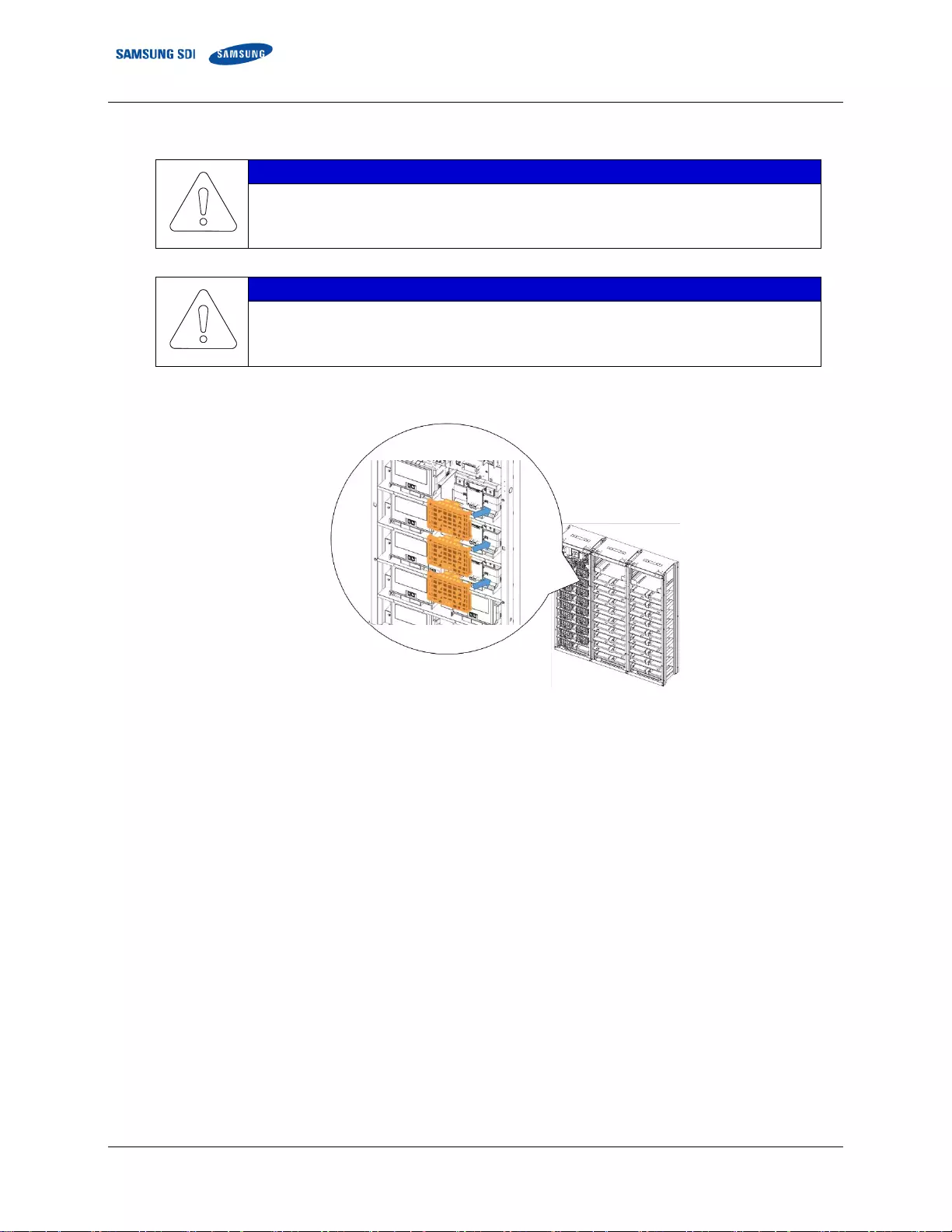
5. Troubleshooting, Repair and Replacement CONFIDENTIAL
54 English 8/2019. Rev 0.0
2. Check the torque settings of the bolts on the busbar.
NOTICE
Connect the power busbar to battery module terminals with an M8 screw.
The fastening torque should be 8.16–11.94 Nm/80 (117 kgf cm).
Use an insulated extension torque wrench with a 13 mm socket.
NOTICE
Connect the power busbar to SMU terminals with an M12 screw.
The fastening torque should be 30 Nm (300 kgf cm).
Use an insulated extension torque wrench with a 19 mm socket.
3. Reattach the Battery Module front covers and SMU B+, B-, P+, P- covers.
Figure 5-18: Reattach the Front Covers
5.2.5 Cell Voltage Balancing
When the battery system is idle – neither charging nor discharging– it will balance the cell voltage if the following
conditions are present:
Minimum cell voltage is above 3.0V.
Discrepancy between the cell voltage is above the 20mV range.
Cell voltage balancing runs automatically whenever the battery system is idle (neither charging nor discharging).
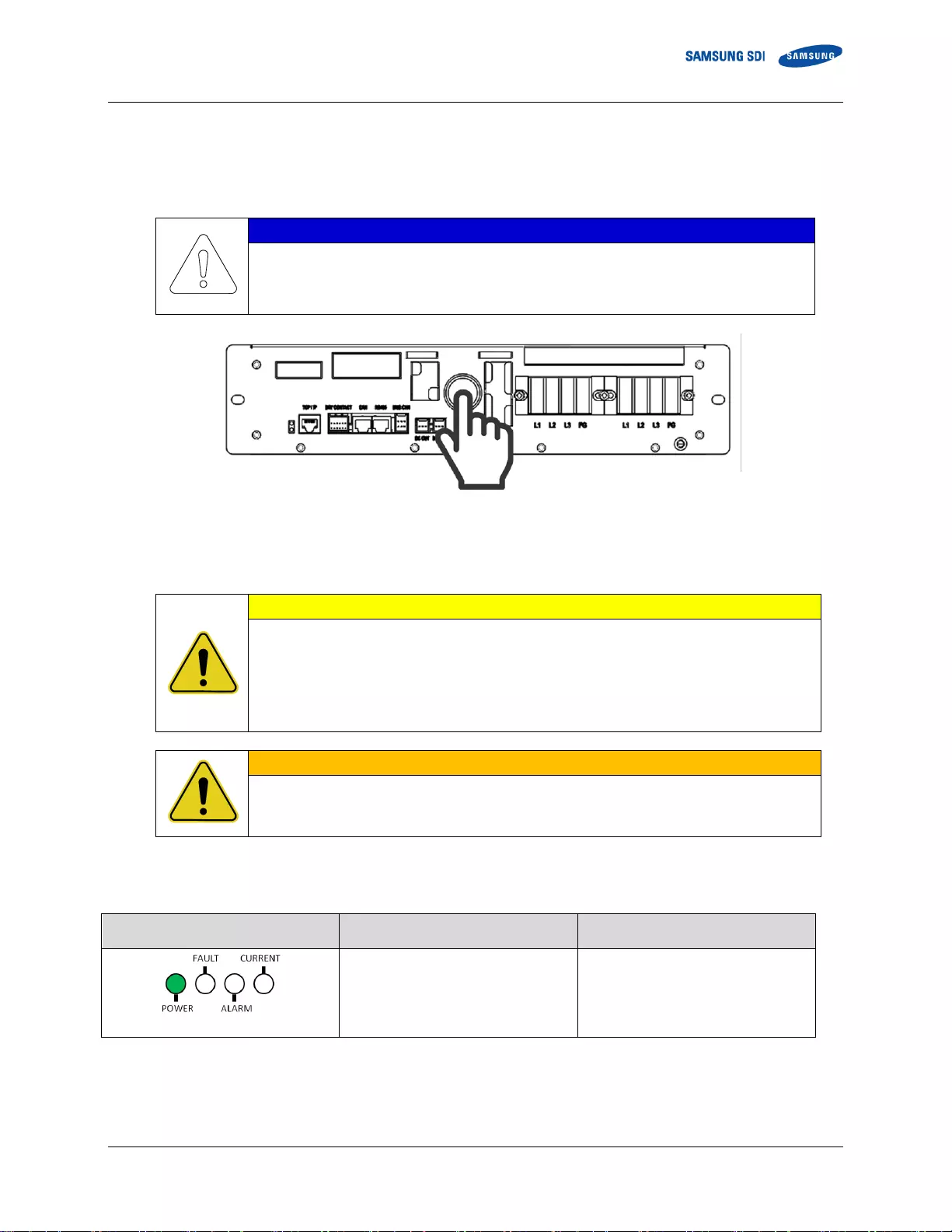
CONFIDENTIAL 5. Troubleshooting, Repair and Replacement
English 8/2019. Rev 0.0 55
5.2.6 System Reset
To reset the battery system after a major protection fault, press the “reset button” on the front of the SMPS
Assembly Type A. This will reset all protection conditions and return the system to normal status.
NOTICE
Make sure all protection conditions have been cleared before pressing the reset button.
Refer to 5.1 Troubleshooting for guides on clearing protection conditions.
Figure 5-19: Pressing the Reset Button
5.2.7 MCCB Handle Control
CAUTION
Terminals and their connected wires have either positive or negative polarity (Positive: B+, P+;
Negative: B-, P-). The polarity of a terminal or a wire connected to the terminal is on the front
of each module and SMU. Exercise extreme caution to prevent terminals and/or wires with
opposite polarity from contacting each other.
Do not permit either battery terminal to contact the rack frame because it is possible to contact
a connection with the opposite polarity.
WARNING
Covers protect the power terminals on Battery Modules and SMU Assemblies to guard against
a short circuit.
When handling the MCCB, make sure the covers are installed properly.
1. Make sure all major protection is cleared by checking the indicator LED in front of the SMU. Before
handling the MCCB, verify that the indicator LED is in normal status.
LED Status
Battery Status
Remarks
POWER LED Steady
Normal Status
MCCB Off
2. If the MCCB handle is in the “TRIP” position, move the handle to the left “OFF” position. If the MCCB
handle is already in the “OFF” position, proceed to the next step.
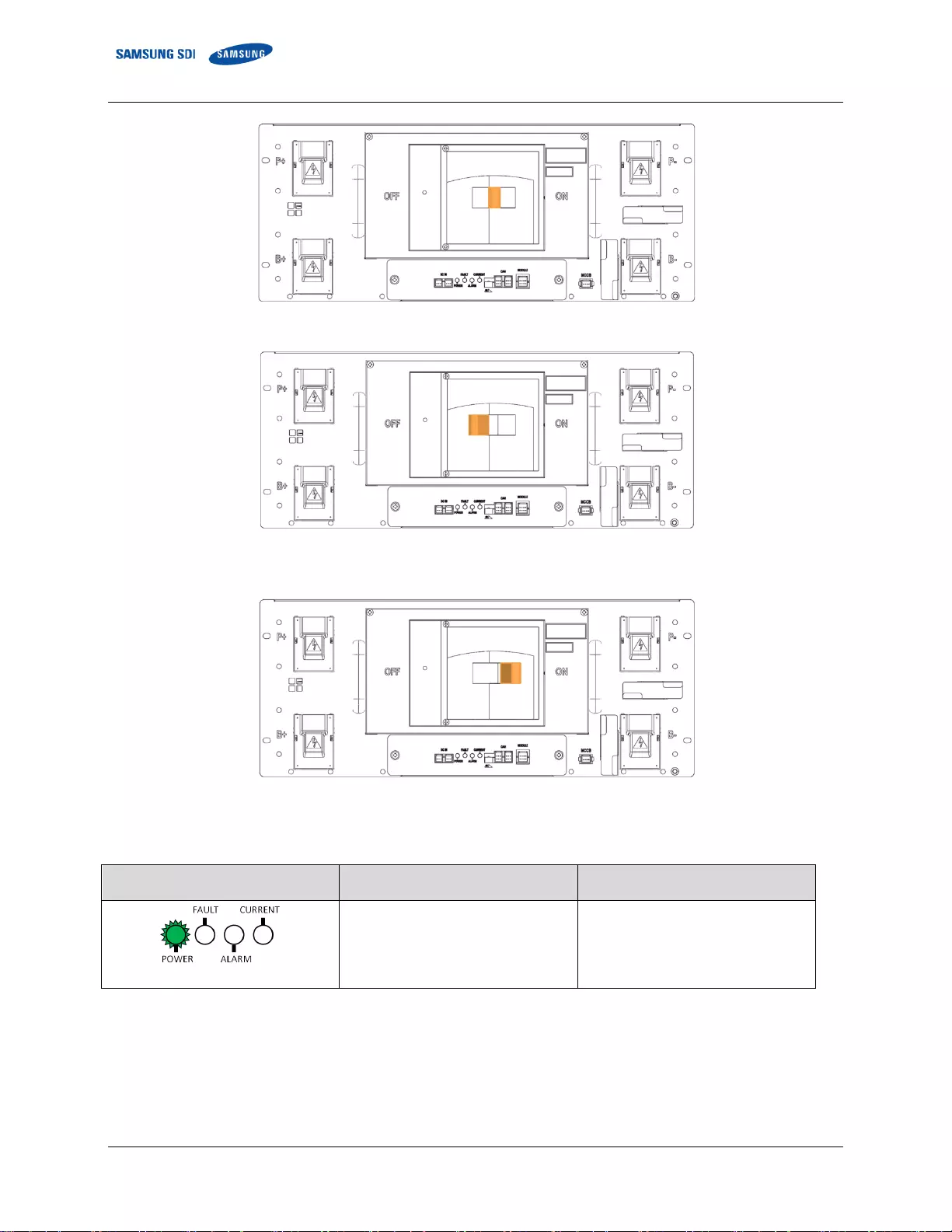
5. Troubleshooting, Repair and Replacement CONFIDENTIAL
56 English 8/2019. Rev 0.0
Figure 5-20: MCCB Handle in Trip Position
Figure 5-21: MCCB Handle in Off Position
3. Press the handle to the right “ON” position.
Figure 5-22: MCCB Handle in On Position
4. Check the SMU indicator LED. Make sure that the indicator LED is in normal status and that the MCCB is on.
LED Status
Battery Status
Remarks
POWER Flashing
Normal Status
MCCB On
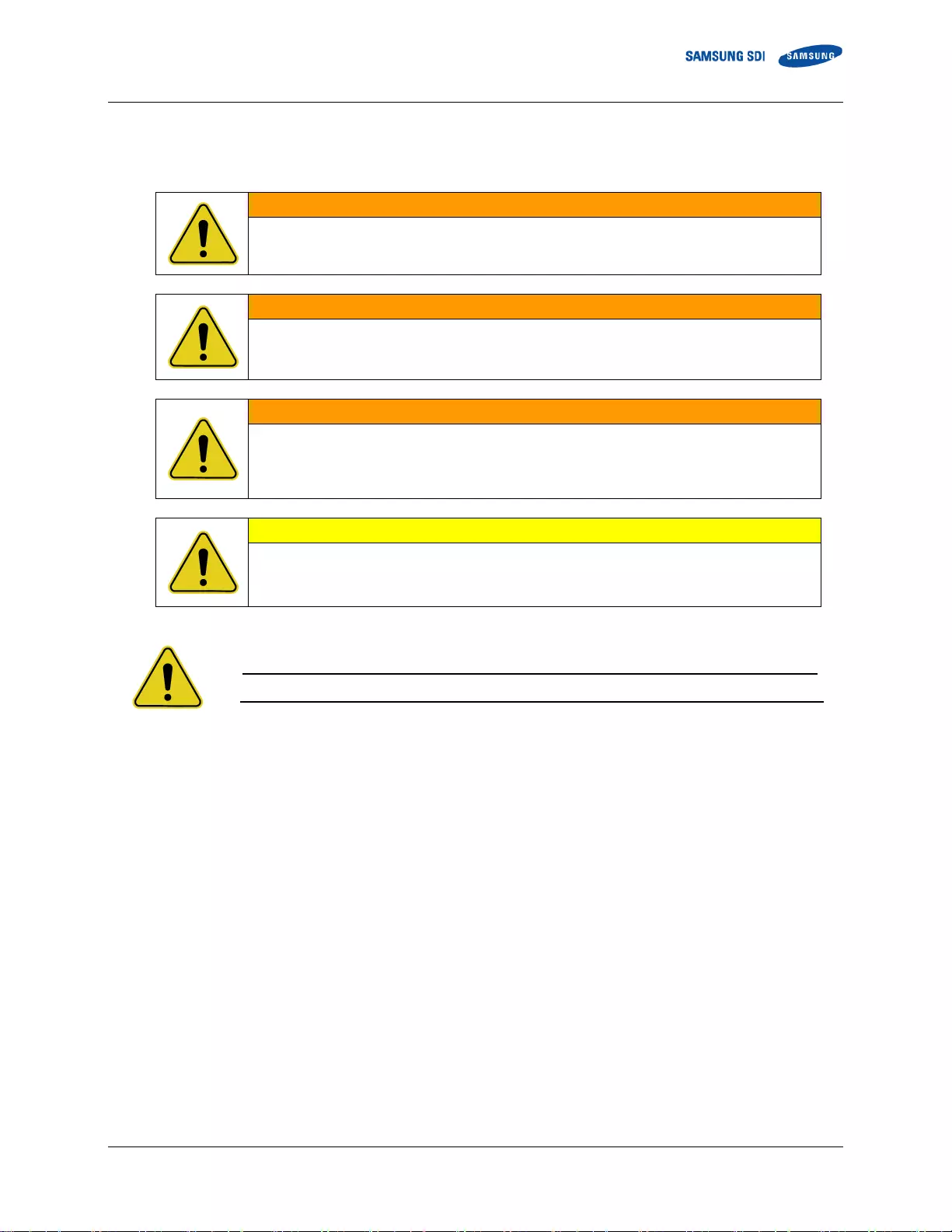
CONFIDENTIAL 5. Troubleshooting, Repair and Replacement
English 8/2019. Rev 0.0 57
5.3 Replacement Procedures
WARNING
Arc Flash and Shock Hazard
Appropriate tools are required while working on this energized equipment.
WARNING
Sharp Edges
Wear protective gear, including gloves, when working within the battery system enclosures. Sharp
edges can exist and may cause severe injury.
WARNING
Pinch Point
Multiple pinch-points are present in most system components. Be aware that there is a serious risk
of injury while working around and in equipment enclosures. These pinch points can cause severe
bodily injury.
CAUTION
Heavy object
Can cause muscle strain or back injury.
Use lifting aids and proper lifting techniques when moving trays, batteries and other heavy objects.
Verify with a voltmeter that no power is present on the system.
Use lock out/tag out procedures to secure the UPS and batteries.
This section will explain the procedures for disassembly and installation of user-replaceable components. Follow
the safety instructions when replacing Battery Modules, Rack Fuse, SMU, and SMPS Assembly. Refer to the
installation manual for more details.
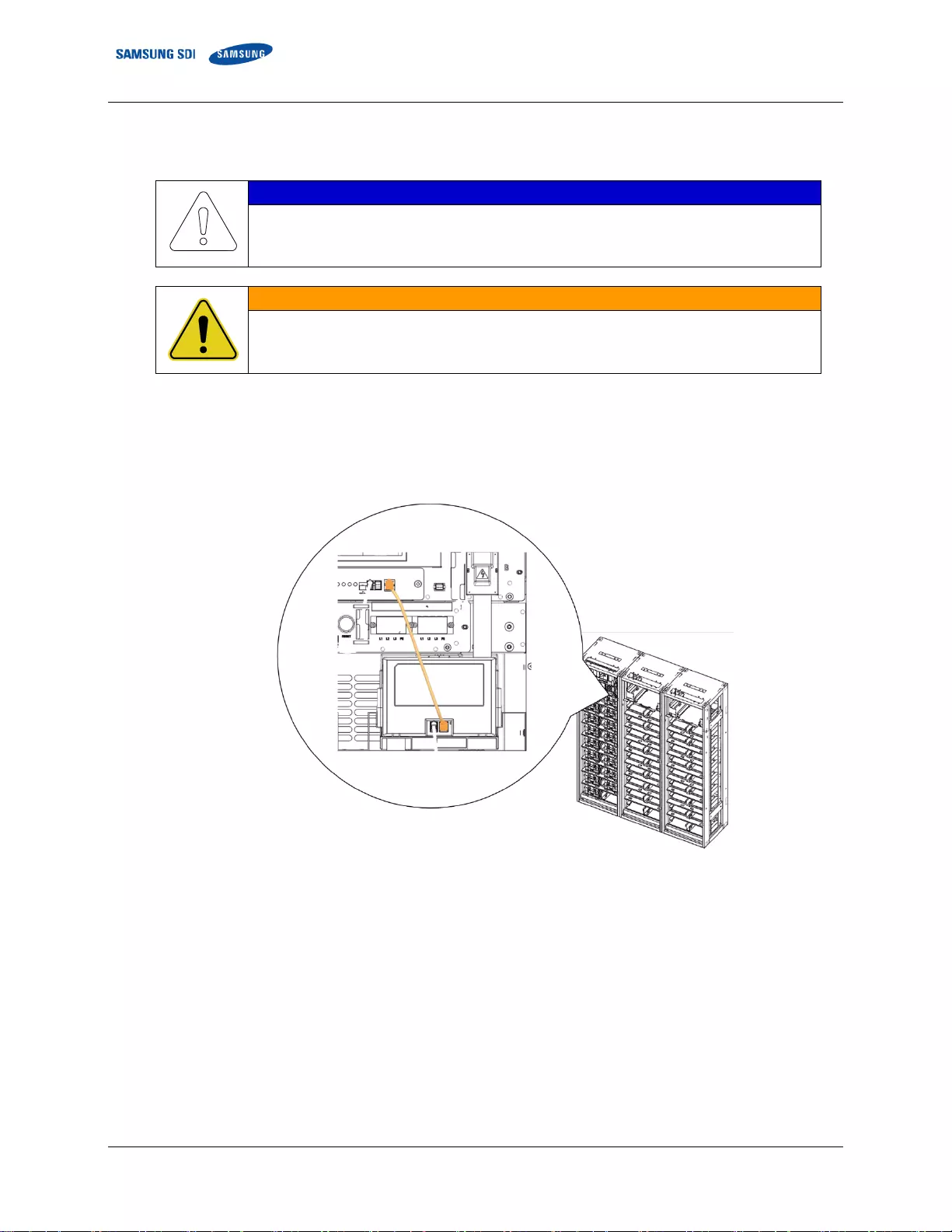
5. Troubleshooting, Repair and Replacement CONFIDENTIAL
58 English 8/2019. Rev 0.0
5.3.1 Wire Harness Replacement
NOTICE
Use only the proper signal cables. These are specified by the part names in the parts list table
of the installation manual.
WARNING
Rack BMS / Module BMS Damage
Do not insert both ends of the signal cable WIRE ASSY MODULE TO MODULE #1 or WIRE ASSY
MODULE TO MODULE #2 into the same Battery Module.
5.3.1.1 SMU to Module Wire Harness Replacement
1. Remove the signal cable “WIRE ASSY RACK TO MODULE SHIELDING” between the SMU “MODULE”
connector and Module #1 “Right Connector”. Press the tab above each end of the connectors and pull the
wires out gently.
Figure 5-23: Remove SMU to Module #1 Right Connector
2. Install the replacement wire harness signal cable “WIRE ASSY RACK TO MODULE SHIELDING” between the
SMU “MODULE” connector and Module #1 “Right Connector”.
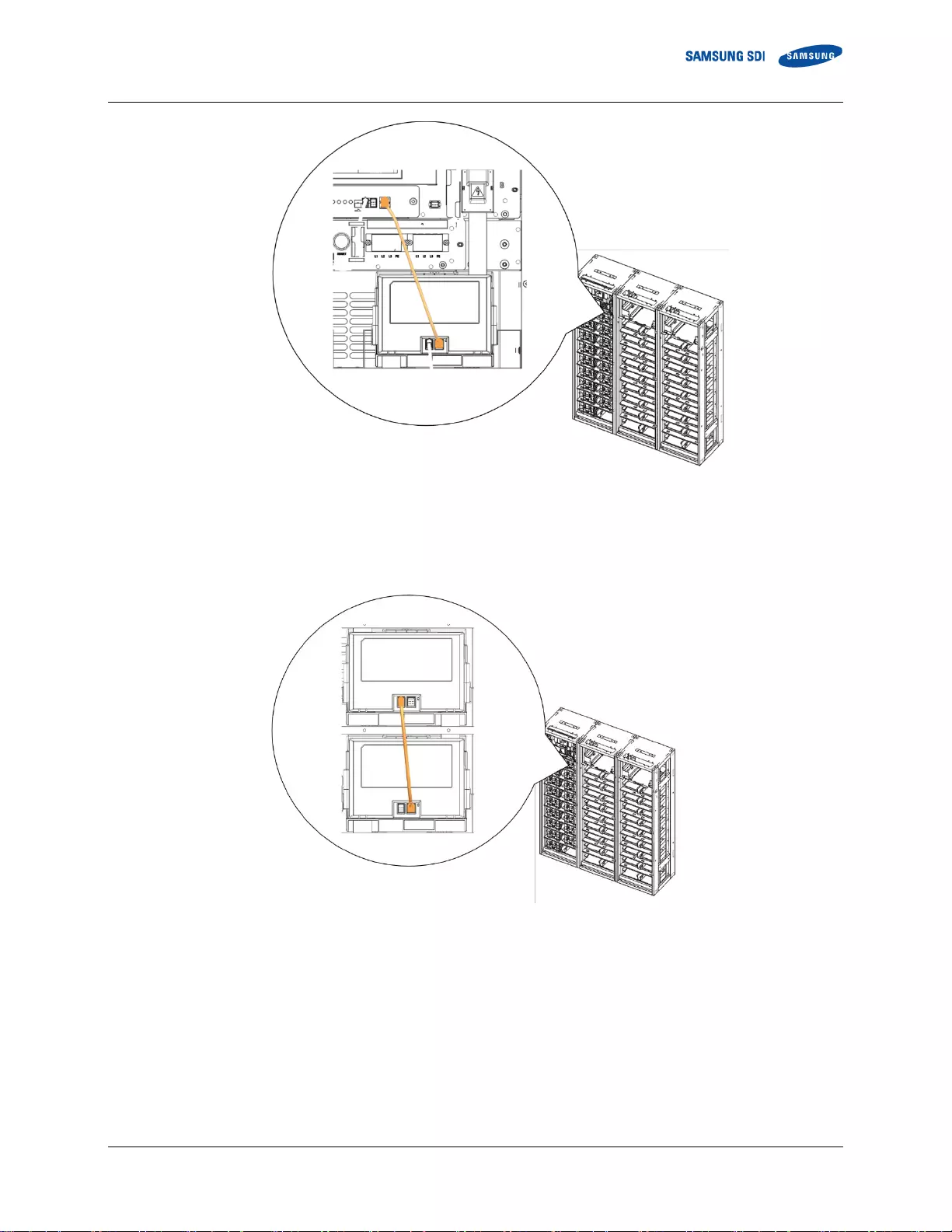
CONFIDENTIAL 5. Troubleshooting, Repair and Replacement
English 8/2019. Rev 0.0 59
Figure 5-24: Install Signal Cable Between the SMU and Battery Module #1 Right Connector
5.3.1.2 Module to Module Wire Harness Replacement
1. Remove the signal cable “WIRE ASSY MODULE TO MODULE."
Figure 5-25: Remove Module to Module Signal Cable
2. Install the replacement signal cable “WIRE ASSY MODULE TO MODULE."

5. Troubleshooting, Repair and Replacement CONFIDENTIAL
60 English 8/2019. Rev 0.0
Figure 5-26: Install Module to Module Signal Cable
5.3.1.3 SMU to SMU CAN Wire Harness Replacement
1. Remove the CAN wire harness between SMU Assemblies.
Figure 5-27: CAN Wire Harness Between SMU Assemblies
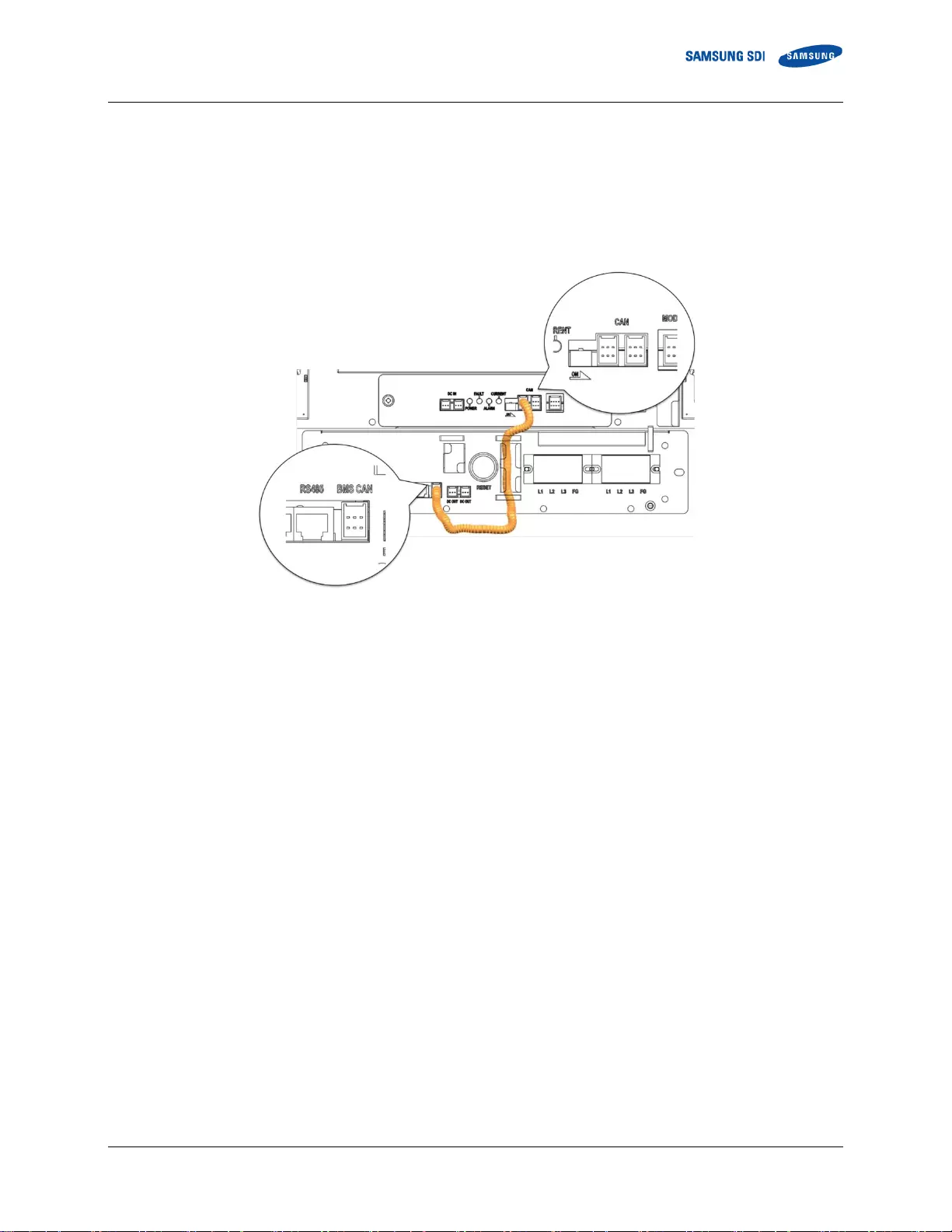
CONFIDENTIAL 5. Troubleshooting, Repair and Replacement
English 8/2019. Rev 0.0 61
2. Install the replacement CAN wire harness between SMUs
5.3.1.4 SMU to SMPS Assembly CAN Wire Harness Replacement
1. Remove the CAN wire harness between the SMU and SMPS Assembly.
Figure 5-28: CAN Cable Connection from SMPS Assembly to SMU
2. Install the replacement CAN wire harness between the SMU and SMPS Assembly.
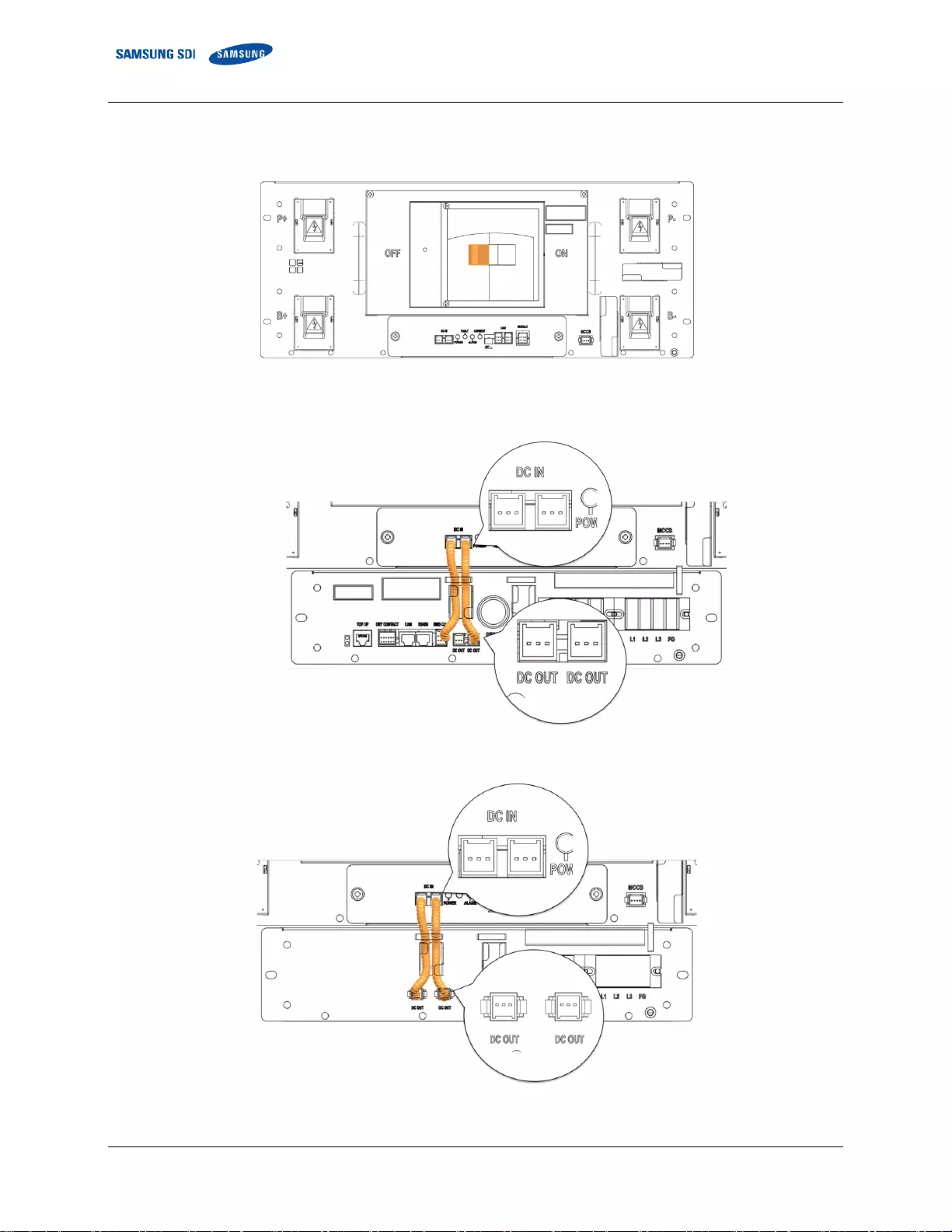
5. Troubleshooting, Repair and Replacement CONFIDENTIAL
62 English 8/2019. Rev 0.0
5.3.1.5 SMU to SMPS Assembly DC Power Wire Harness Replacement
1. Turn the MCCB off.
Figure 5-29: MCCB Handle in “OFF” position
2. Remove the DC power wire harness.
Figure 5-30: DC Power Cables from SMPS Assembly Type A to SMU
Figure 5-31: DC Power Cables from SMPS Assembly Type B to SMU
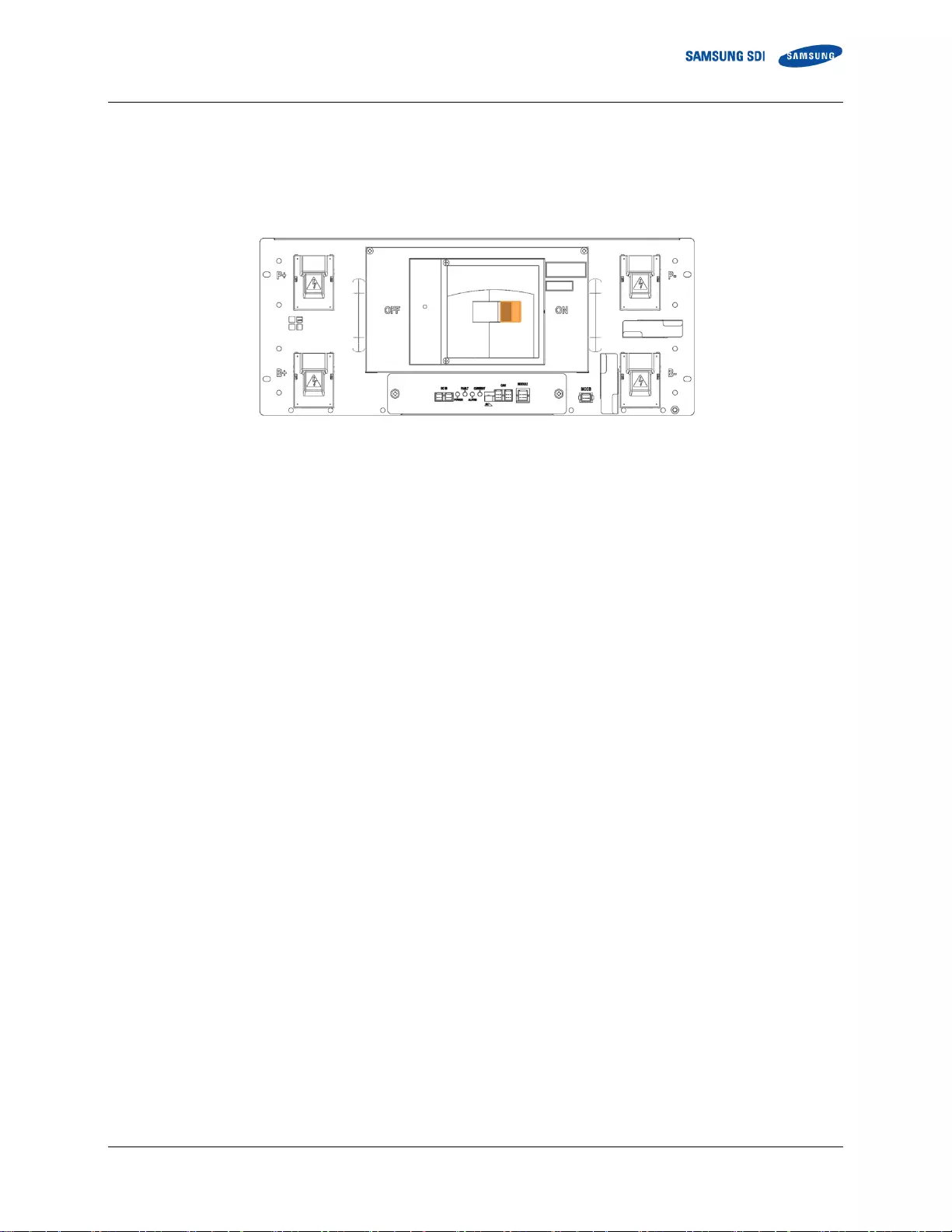
CONFIDENTIAL 5. Troubleshooting, Repair and Replacement
English 8/2019. Rev 0.0 63
3. Install the replacement DC power wire harness
4. Check the indicator LED and make sure it is in normal status.
5. Turn the MCCB on.
Figure 5-32: MCCB Handle in “ON” Position
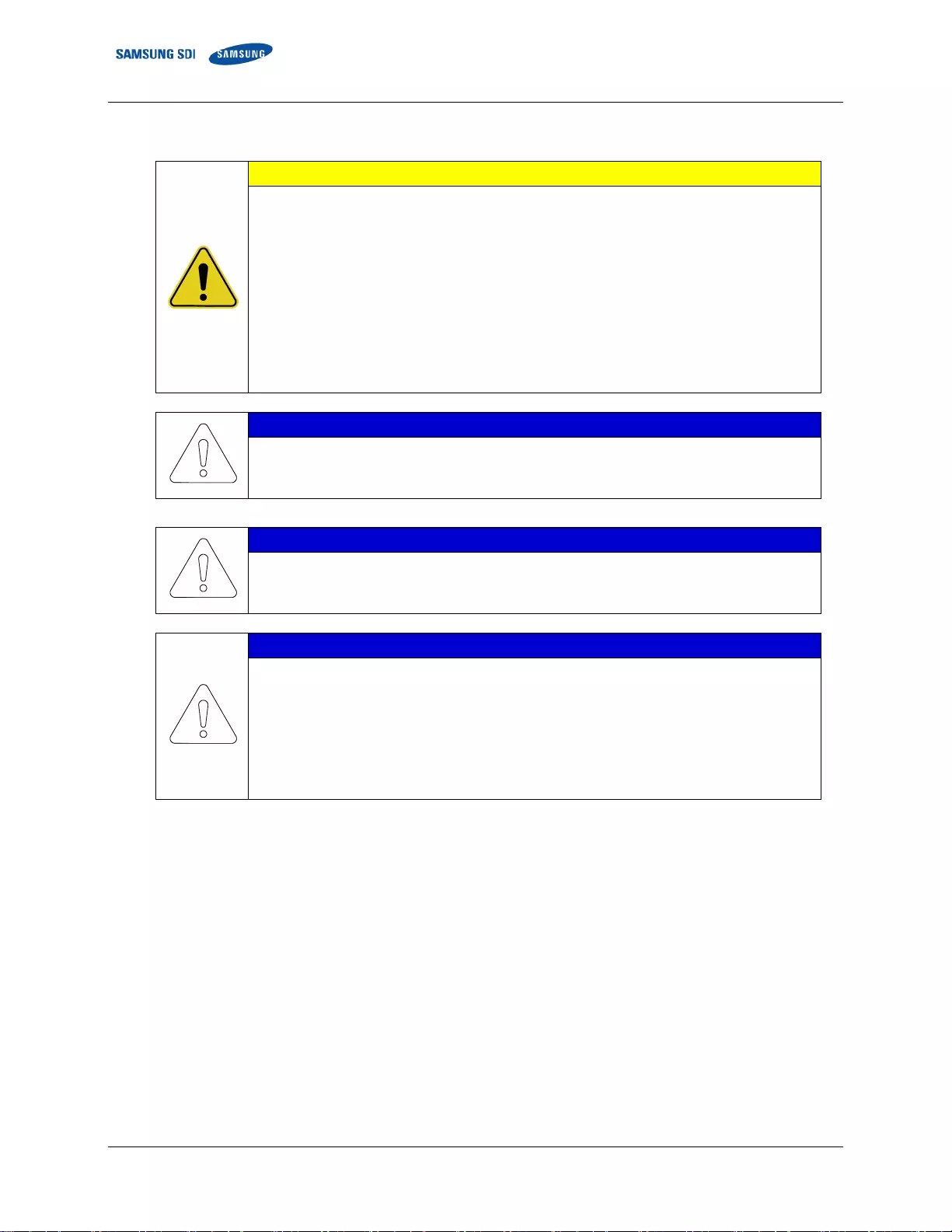
5. Troubleshooting, Repair and Replacement CONFIDENTIAL
64 English 8/2019. Rev 0.0
5.3.2 Battery Module Replacement
CAUTION
Follow the instructions exactly to protect the Module BMS and Battery Module from damage.
DO NOT deviate from the sequence of steps below.
The voltage of the connected system increases proportionally as battery modules are
connected. Exercise extreme caution to prevent the terminals from touching anything other
than their intended mounting points.
Terminals and their connected wires have either positive or negative polarity (Positive: B+, P+;
Negative: B-, P-). The polarity of a terminal or a wire connected to the terminal is on the front
of each module and SMU. Exercise extreme caution to prevent terminals and/or wires with
opposite polarity from contacting each other.
Do not permit either battery terminal to contact the rack frame because it is possible to contact
a connection with the opposite polarity.
NOTICE
Connect the power busbar to the Battery Module Terminals with an M8 screw. Use an insulated
extension torque wrench with a 13 mm socket.
The fastening torque should be 8.16–11.94 Nm (80–117 kgf cm).
NOTICE
Connect the power busbar to the SMU terminals with an M12 bolt. Use an insulated extension
torque wrench with a 19 mm socket
The fastening torque should be 30 N∙m (300 kgf∙cm).
NOTICE
When charging or discharging the battery module, the following settings must be followed to
prevent damaging the battery module.
Maximum charge voltage : 33.6V
Minimum discharge voltage : 24V
Maximum charge current : 22.3A
Maximum discharge current : 67A
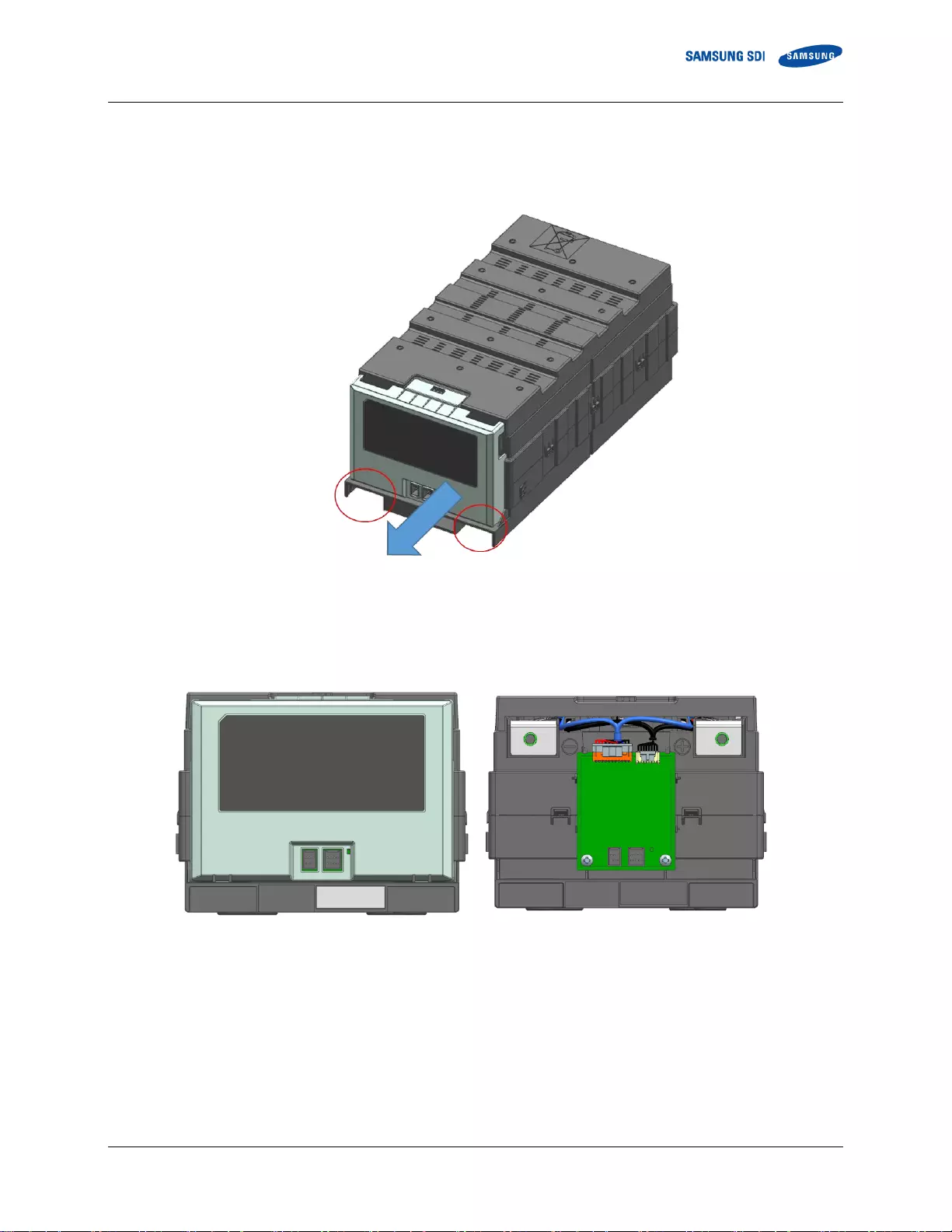
CONFIDENTIAL 5. Troubleshooting, Repair and Replacement
English 8/2019. Rev 0.0 65
4. Identify the defective Battery Module’s type. It must be replaced with an identical type of Battery Module.
5. Remove the front cover of the Battery module to determine the type.
Press the hook on the bus bar opening and pull the front cover towards the front to remove.
Figure 5-33: Removing the Battery Module Front Cover
6. Type A’s positive (+) terminal is on the right side when viewed from the front; Type B’s positive (+)
terminal is on the left.
Type A’s middle is black; Type B’s middle is gray.
Figure 5-34: Battery Module Type A
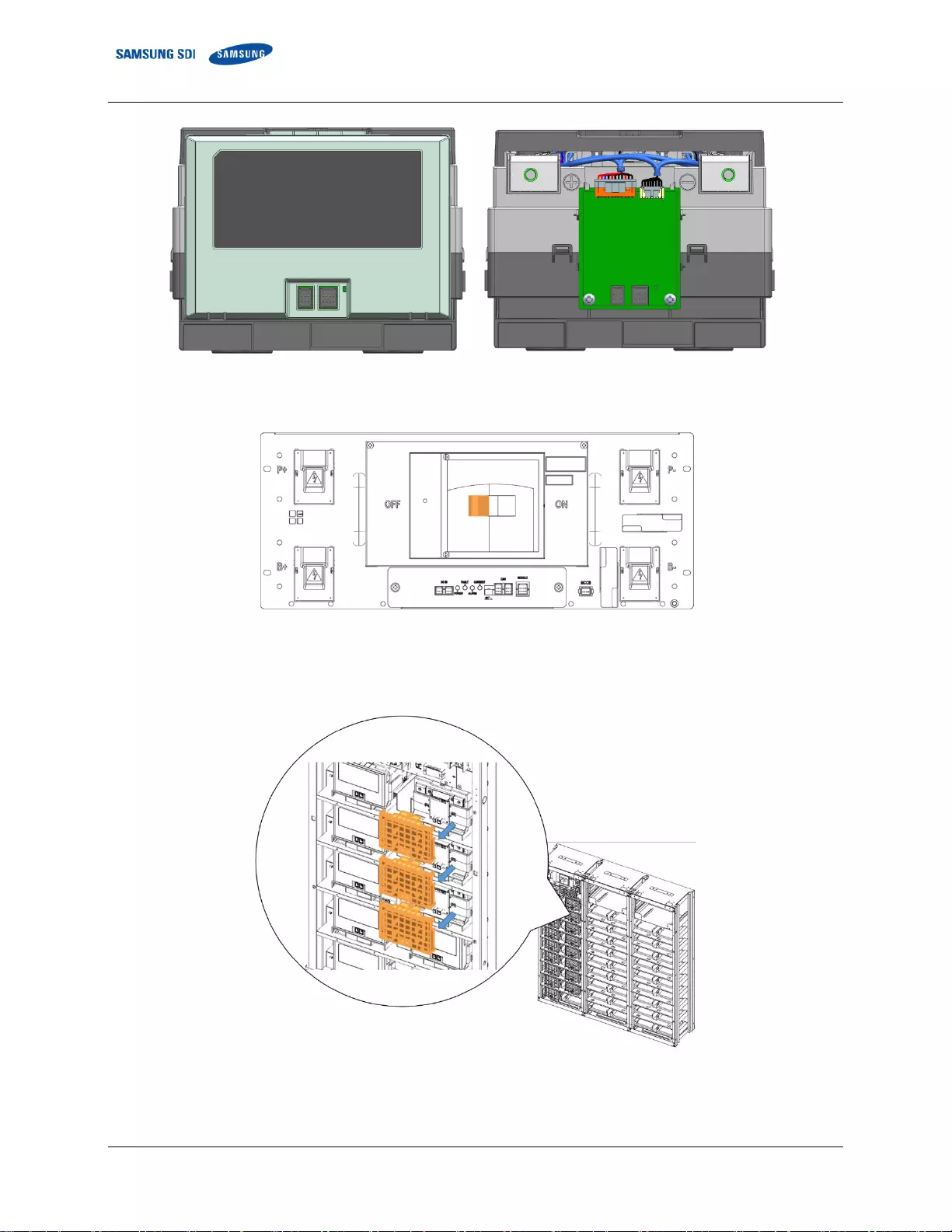
5. Troubleshooting, Repair and Replacement CONFIDENTIAL
66 English 8/2019. Rev 0.0
Figure 5-35: Battery Module Type B
7. Turn the MCCB off by pushing the MCCB handle to the “OFF” position.
Figure 5-36: MCCB Handle in “OFF” Position
8. Turn off the AC input to the SMPS Assembly.
9. Remove front covers from all Battery Modules.
Figure 5-37: Remove Battery Module Front Covers
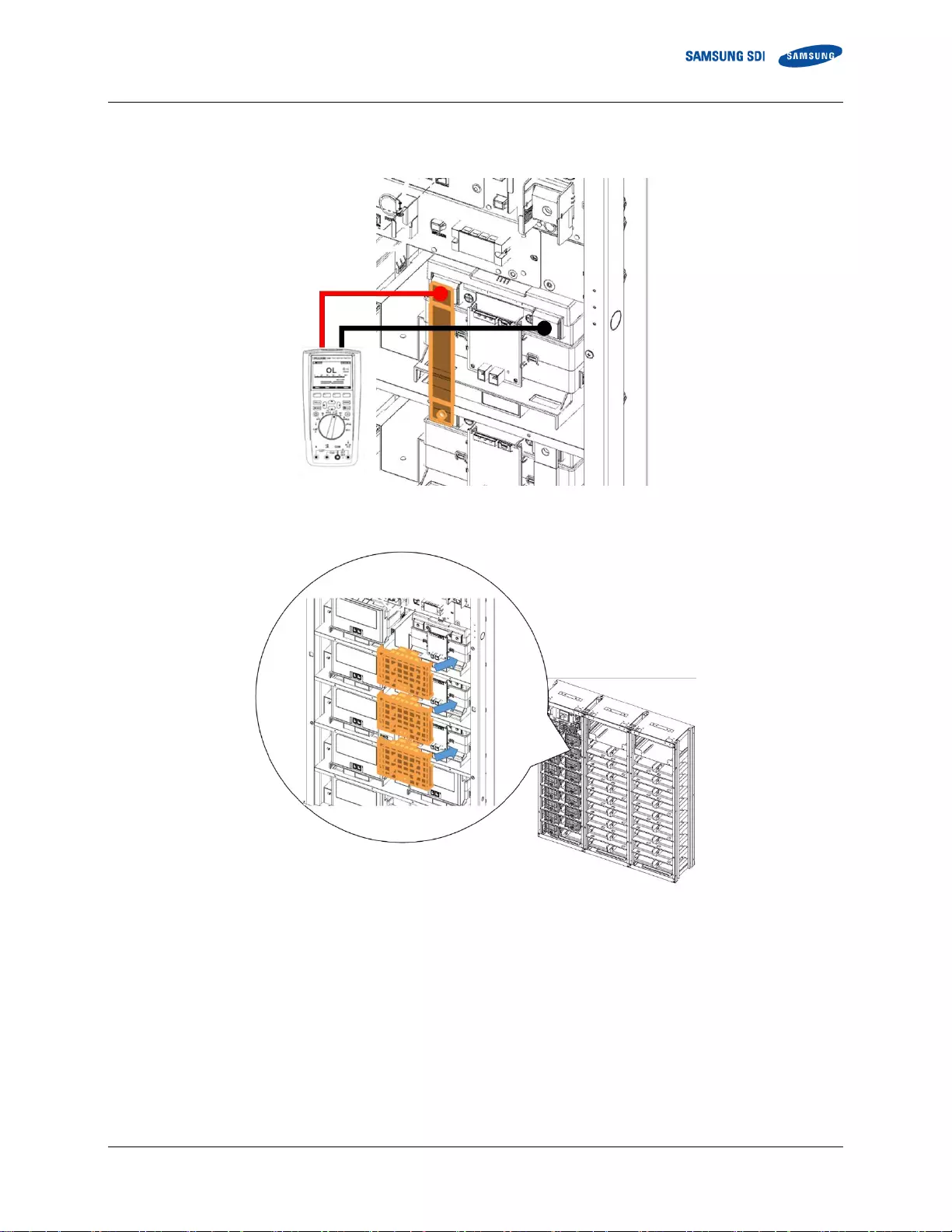
CONFIDENTIAL 5. Troubleshooting, Repair and Replacement
English 8/2019. Rev 0.0 67
10. Use a multimeter to measure the voltage of each Battery Module except the defective Battery Module.
Record the measurements for reference.
Figure 5-38: Measuring Each Battery Module’s Voltage
11. Reattach the front covers to all Battery Modules.
Figure 5-39: Assemble Battery Module Front Covers
12. Charge or discharge the replacement Battery Module to match the average voltage of the other modules.
If the replacement Battery Module’s voltage is higher than the other battery modules, use a controllable
load to discharge the battery module to match the voltage to within 300mV of the other Battery Modules’
average voltage.
If the replacement Battery Module’s voltage is lower than the other Battery Modules, use a controllable
DC power supply to charge the Battery Module to match the other Battery Modules’ average voltage to
within 300mV.
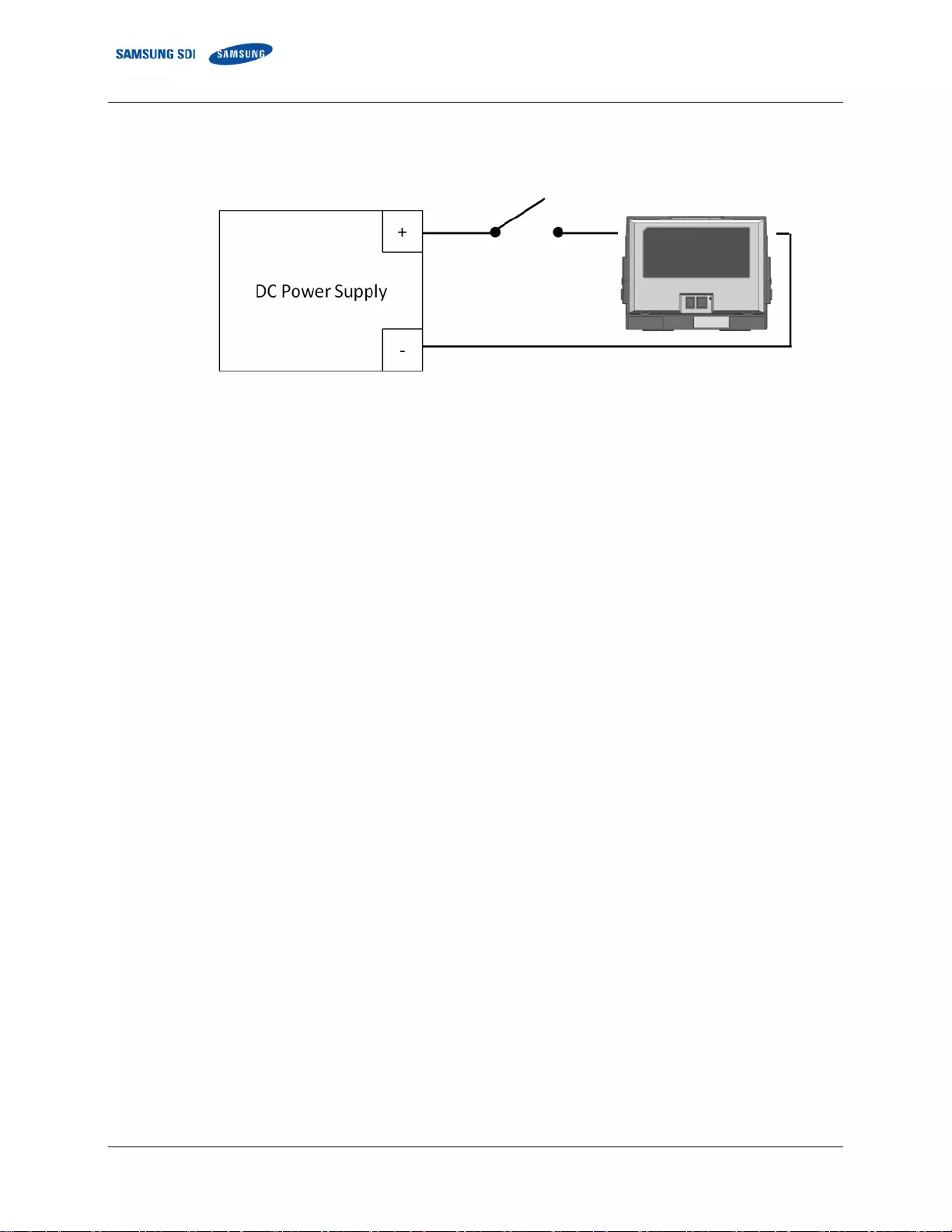
5. Troubleshooting, Repair and Replacement CONFIDENTIAL
68 English 8/2019. Rev 0.0
When using a DC power supply to charge the battery module directly, use a switch or a circuit breaker
between the battery module’s terminal and the DC power supply’s terminal. Refer to the diagram below.
Figure 5-40: DC Power Supply and Battery Module Connection
Before turning the switch or the circuit breaker on, DC power supply’s output voltage must match the
Battery Module’s voltage to prevent inrush current from the battery.
Set the DC power supply’s output voltage to the Battery Module’s voltage.
Set the output current to 0A.
Turn the DC power supply’s output on to pre-charge the capacitors within the power supply.
Turn the switch or circuit breaker on
Raise the output voltage of the DC power supply to the charging voltage.
Set the output current to 22.3A or less.
When the output of the DC power supply reaches the set charging voltage and charging current is
decreased to less than 1.34A, stop charging the battery module by disconnecting the switch or circuit
breaker.
Turn the DC power supply’s output off.
Disconnect the charged battery module
13. Disconnect the control cables from the defective Battery Module.
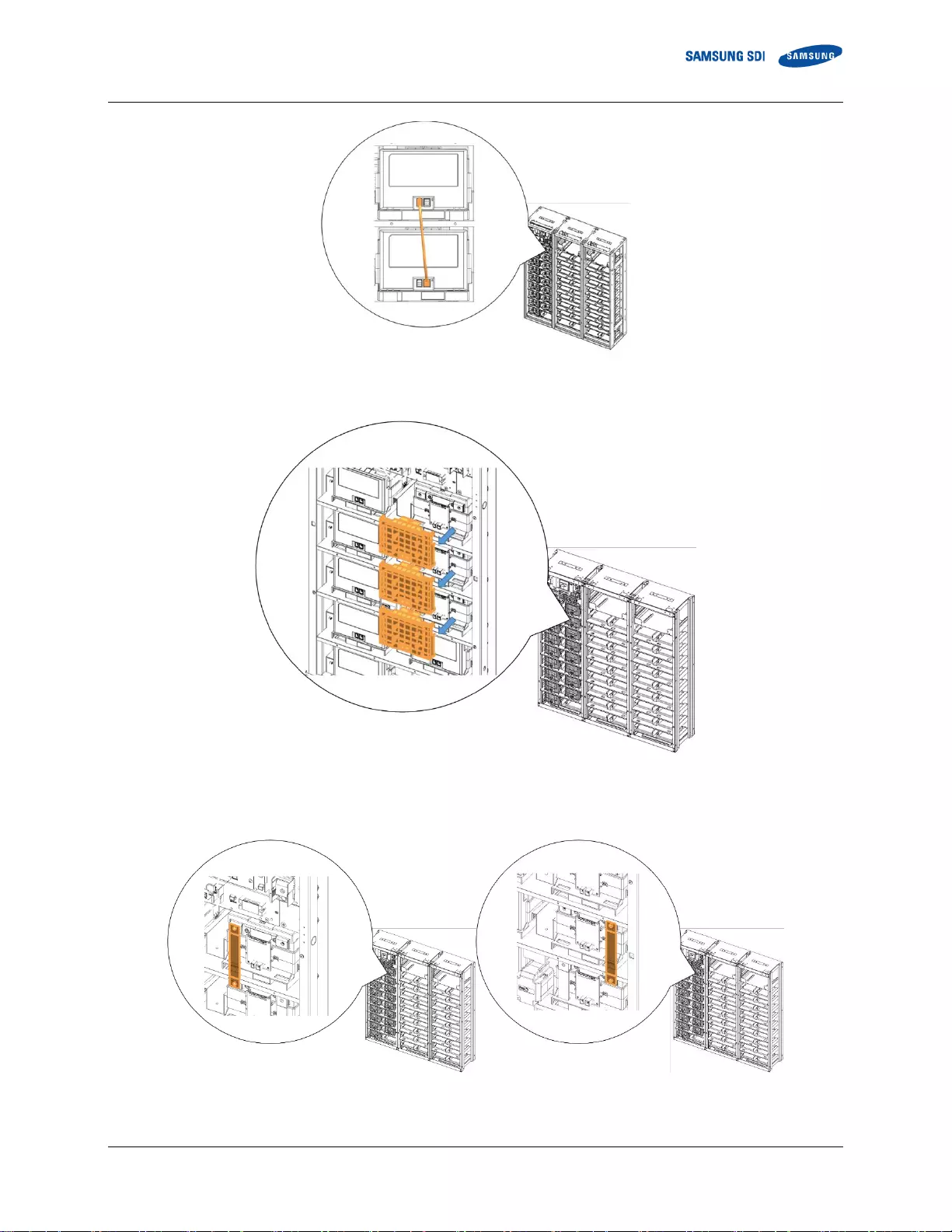
CONFIDENTIAL 5. Troubleshooting, Repair and Replacement
English 8/2019. Rev 0.0 69
Figure 5-41: Battery Module Signal Cables
14. Remove the front covers from the defective Battery Module and adjacent Battery Modules.
Figure 5-42: Remove Battery Module Front Covers
15. Unbolt the positive and negative busbars from the terminals on the defective Battery Module and the
adjacent battery modules.
Figure 5-43: Busbars on Positive and Negative Terminals
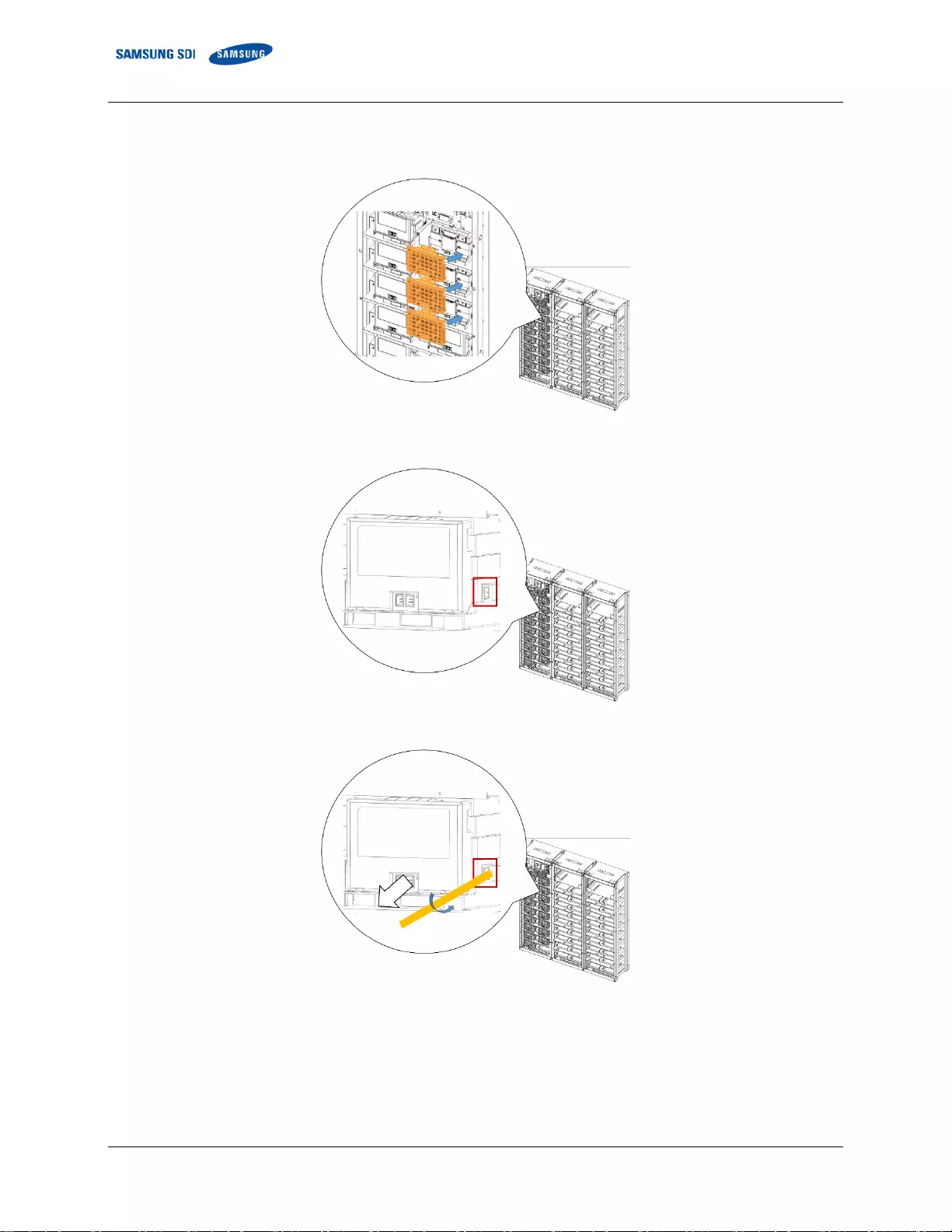
5. Troubleshooting, Repair and Replacement CONFIDENTIAL
70 English 8/2019. Rev 0.0
16. Remove the two busbars.
17. Reattach the battery module front covers
18. Using a rod (a long screwdriver of at least 254mm [10 in.] long may be used), pivot the guide in the Rack
Frame to separate the hooks on the Battery Module from the matching hole in the rack frame.
Figure 5-44: Hook and slots on the rack frame
Pivoting the Guide and Pulling the Battery Module Out
19. Pull out the Battery Module while pivoting the guide and remove the Battery Module from the rack frame.
20. Insert the replacement Battery Module.
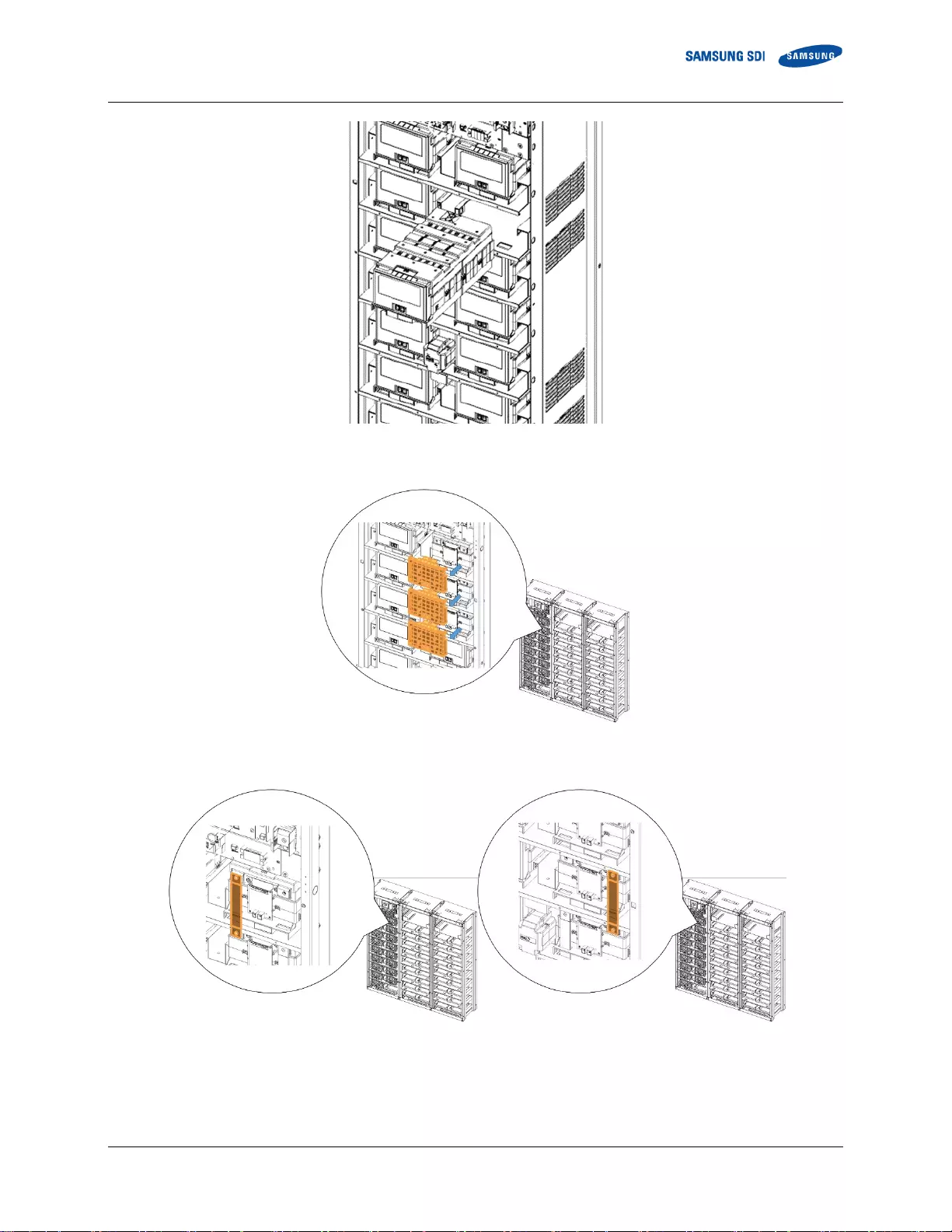
CONFIDENTIAL 5. Troubleshooting, Repair and Replacement
English 8/2019. Rev 0.0 71
Figure 5-45: Inserting the Replacement Battery Module
21. Remove the front cover from the replacement Battery Module and from adjacent Battery Module.
Figure 5-46: Removing the Front Covers
22. Install the busbars.
Figure 5-47: Busbars
23. Reattach the front cover to the Battery Module.
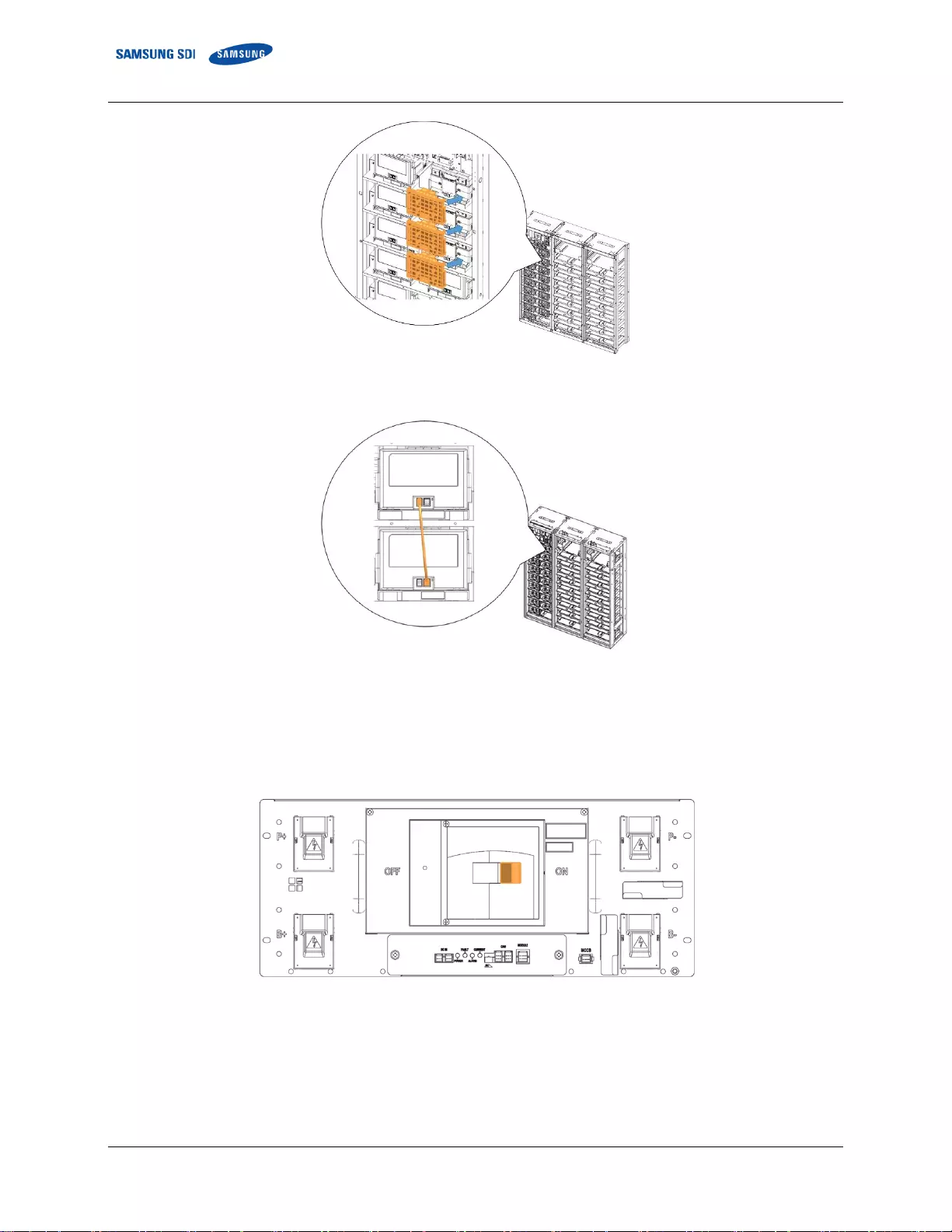
5. Troubleshooting, Repair and Replacement CONFIDENTIAL
72 English 8/2019. Rev 0.0
Figure 5-48: Reattaching the Front Cover to the Battery Module
24. Reconnect the signal cables.
Figure 5-49: Connecting the Signal Cables
25. Turn on the AC input to the SMPS Assembly.
26. Check the indicator LED and make sure it is in normal status.
27. Turn the MCCB handle to the “ON” position.
Figure 5-50: MCCB Handle in “ON” Position
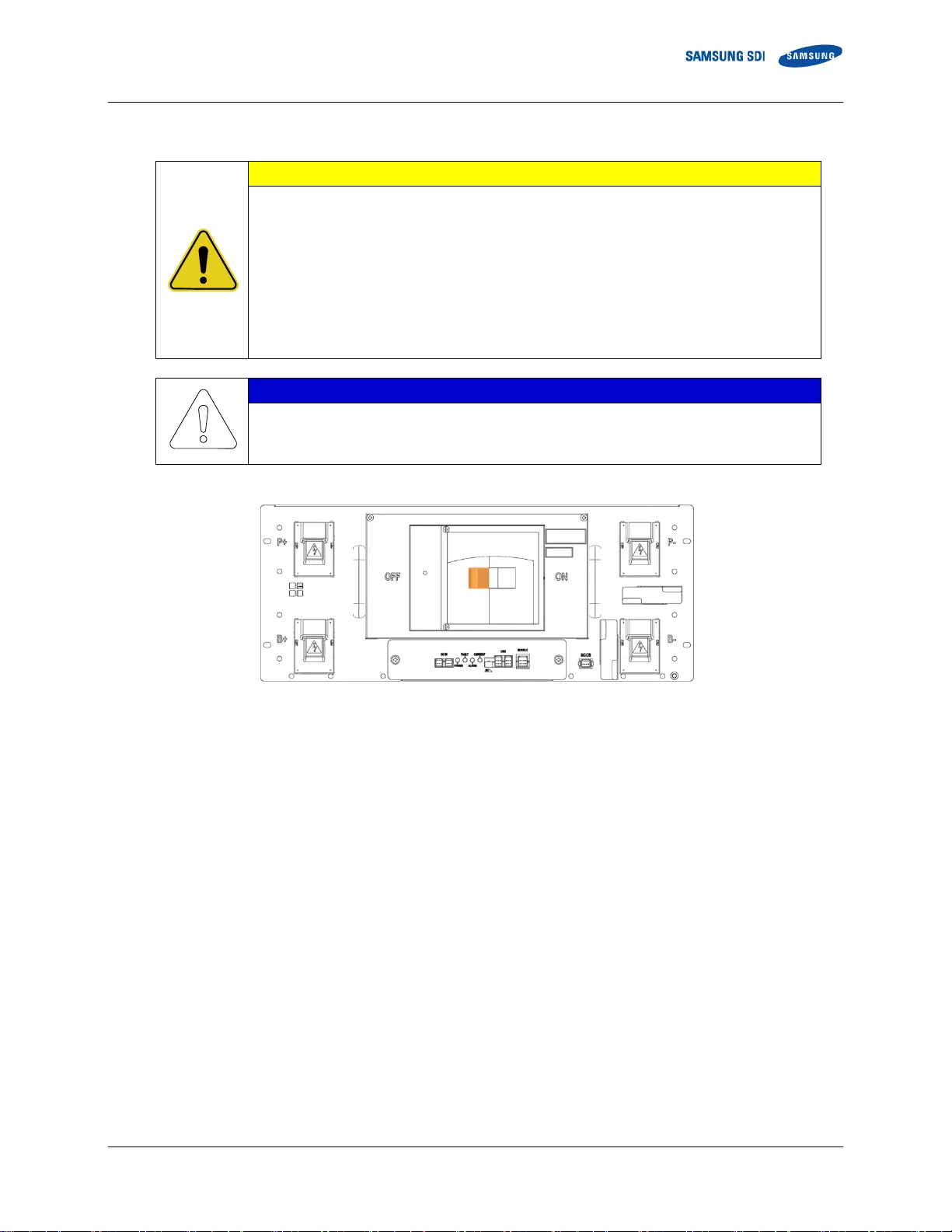
CONFIDENTIAL 5. Troubleshooting, Repair and Replacement
English 8/2019. Rev 0.0 73
5.3.3 Rack Fuse / Module Fuse Replacement
CAUTION
Follow the instructions exactly to protect the Module BMS and Battery Module from damage.
DO NOT deviate from the sequence of the steps below.
The voltage of the connected system increases proportionally as battery modules are
connected. Exercise extreme caution to prevent the terminals from touching anything other
than their intended mounting points.
Exercise extreme caution to prevent terminals and wires from contacting a wire or terminal
with the opposite polarity.
Do not permit either battery terminal to contact the rack frame because it is possible to contact
a connection with the opposite polarity.
NOTICE
The Rack Fuse Busbar Assembly is assembled at the installation site using M12 x 16L screws.
The fastening torque should be 30 Nm (300 kgf cm).
1. Turn the MCCB off. If multiple strings are installed in parallel, turn the MCCB off for all racks.
Figure 5-51: MCCB Handle in “OFF” Position
2. Turn off the AC input to the SMPS Assembly.
3. Remove front covers from the Battery Modules adjacent to the rack fuse.
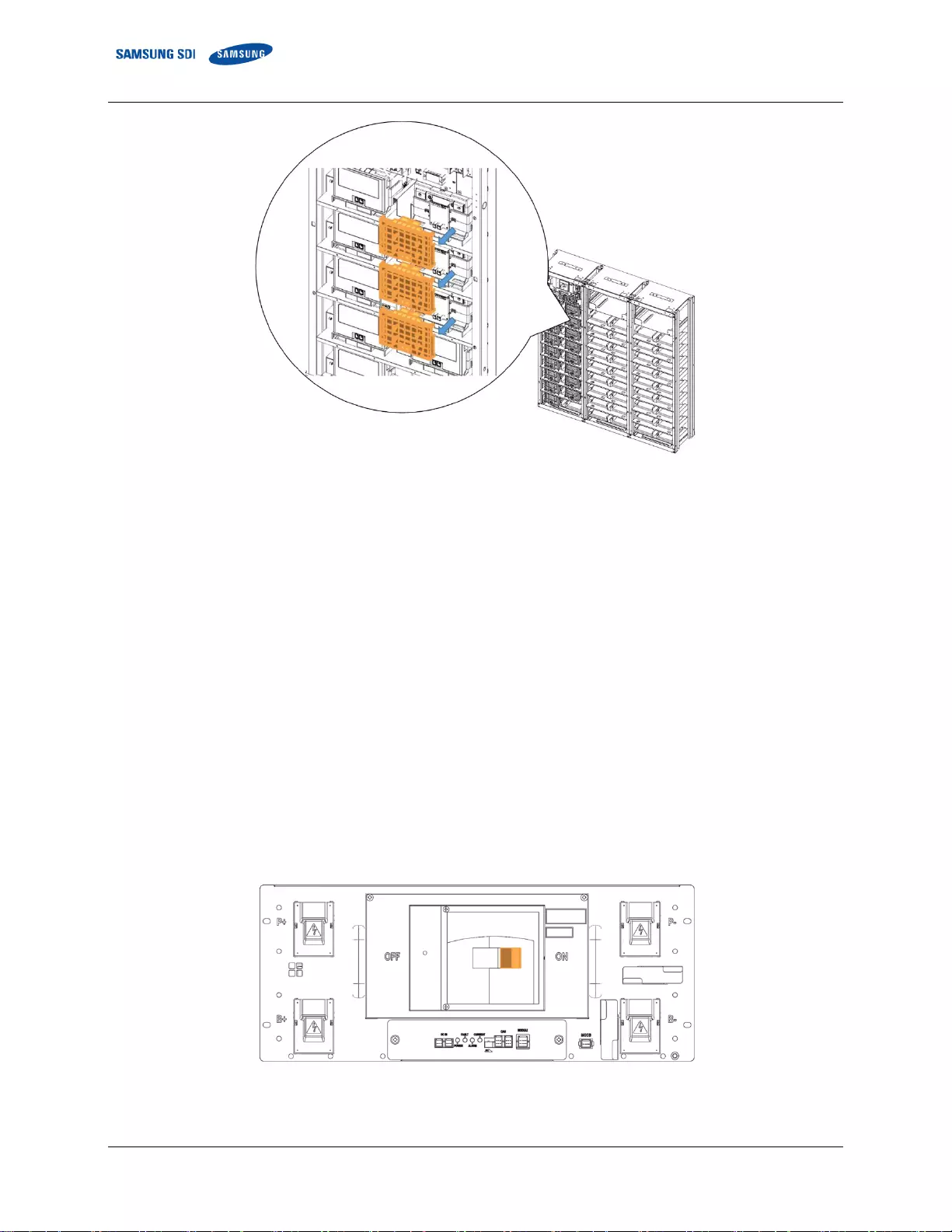
5. Troubleshooting, Repair and Replacement CONFIDENTIAL
74 English 8/2019. Rev 0.0
Figure 5-52: Remove the Battery Module Front Covers
4. Remove the bolts from the Battery Module terminals that are connected to the rack fuse.
5. Remove the rack fuse assembly.
6. Remove the busbars and bolts attached to the rack fuse and reattach the busbars and bolts to the
replacement rack fuse.
7. Attach the replacement rack fuse with busbars attached.
8. Assemble the bolts for the Battery Module terminals.
9. Reattach the front covers to the Battery Modules.
10. Reattach the rack fuse cover.
11. Turn on the AC input to the SMPS Assembly.
12. Check the SMU indicator LED and make sure it is in normal status.
13. Turn the MCCB handle to the “ON” position.
Figure 5-53: MCCB Handle in “ON” Position

CONFIDENTIAL 5. Troubleshooting, Repair and Replacement
English 8/2019. Rev 0.0 75
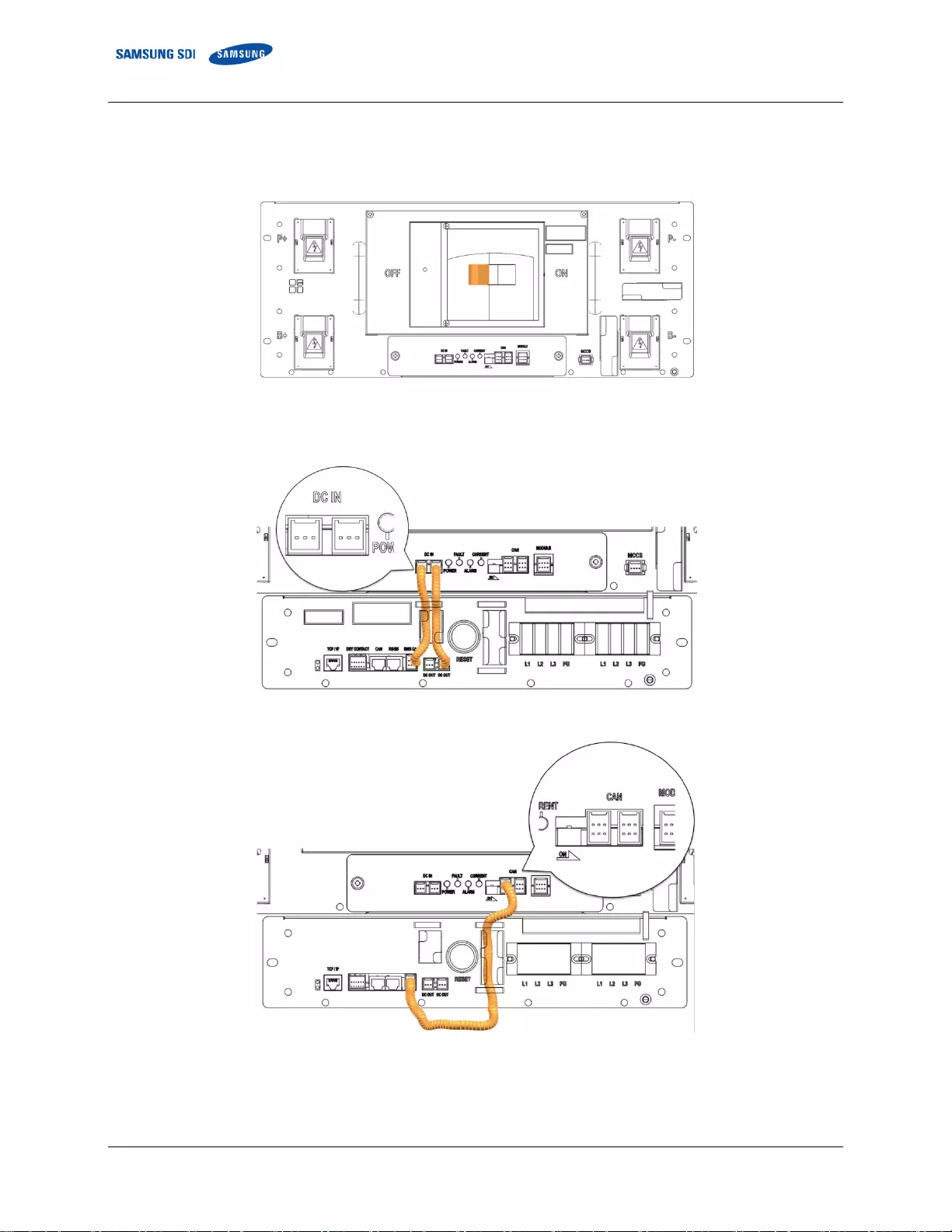
5. Troubleshooting, Repair and Replacement CONFIDENTIAL
76 English 8/2019. Rev 0.0
5.3.4 SMU Replacement
1. Turn the MCCB off. If multiple strings are installed in parallel, turn the MCCB off for all racks.
Figure 5-54: MCCB Handle in “OFF” Position
2. Remove the DC input and communication wires from the Battery Module, the adjacent rack and the SMPS
Assembly.
Figure 5-55: DC IN Cable
Figure 5-56: CAN Cable to SMPS Assembly
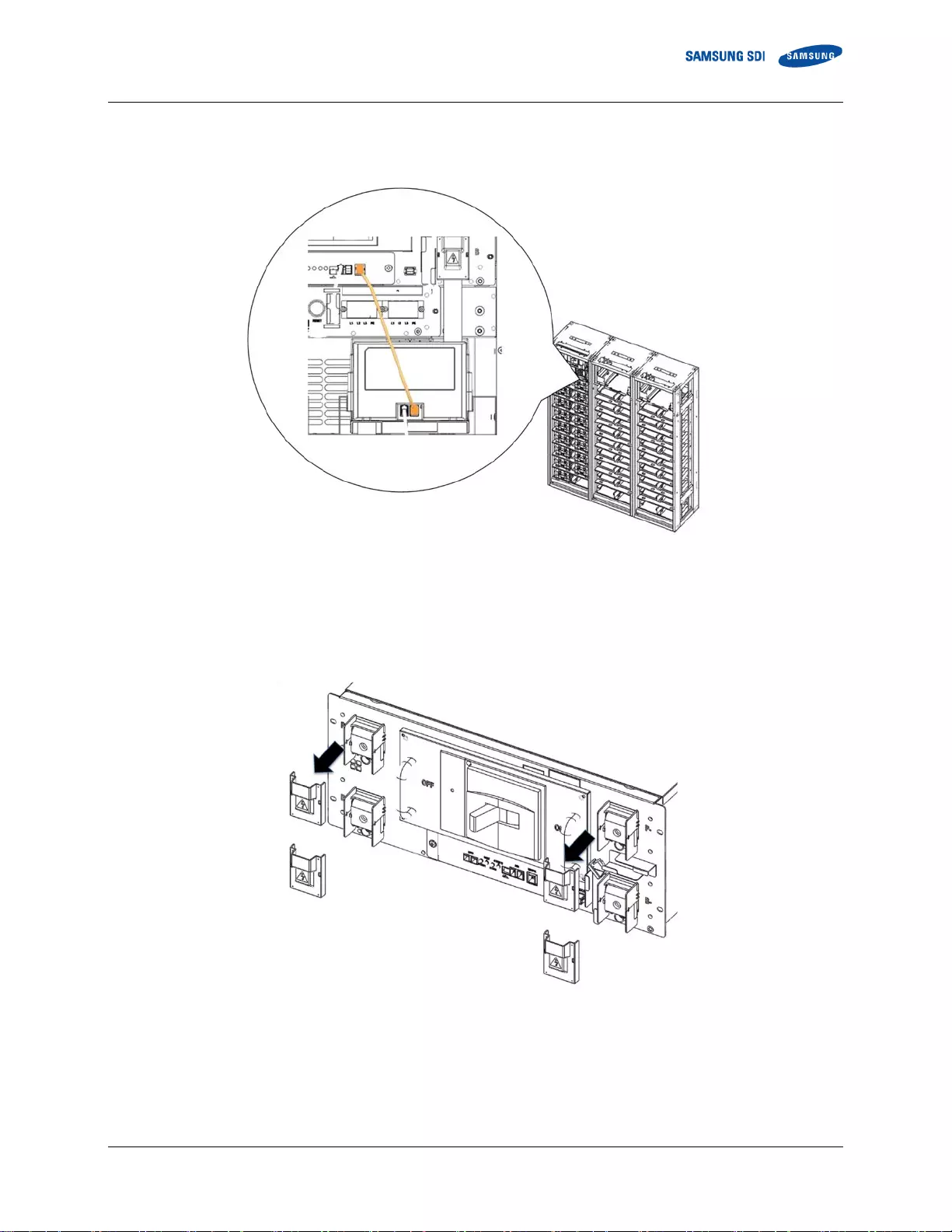
CONFIDENTIAL 5. Troubleshooting, Repair and Replacement
English 8/2019. Rev 0.0 77
Figure 5-57: CAN Cable to Adjacent Rack
Figure 5-58: Module Signal Cable
3. Remove the front cover from the Battery Module on the ninth shelf.
4. Remove the bolts from B+ on Battery Module #16, and from B- on Battery Module #1.
5. Remove terminal covers from the battery terminals.
Figure 5-59: SMU Terminal Covers
6. Hold the busbar on its insulated portion and remove the bolts from the terminals for B+, B- terminals.
7. Remove the busbars.
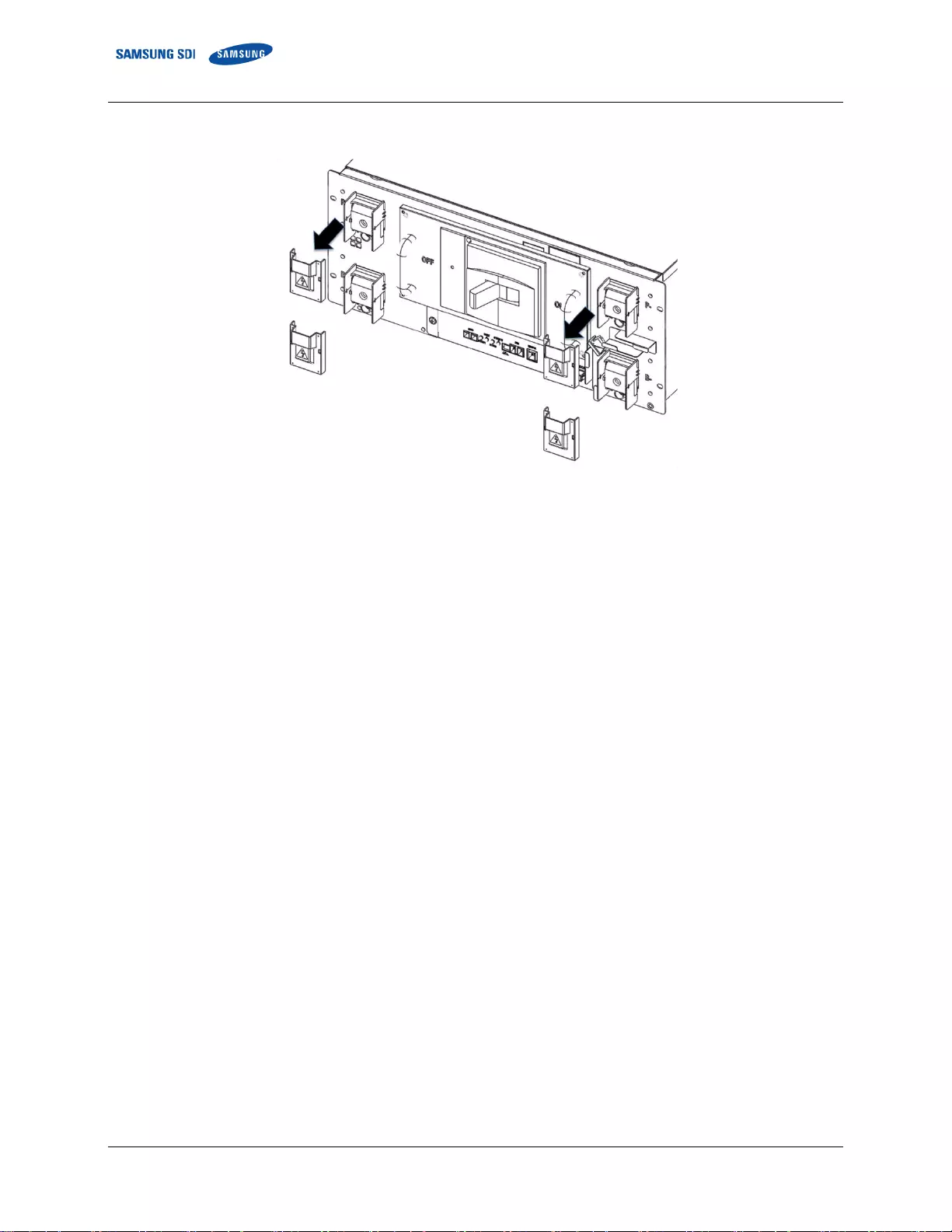
5. Troubleshooting, Repair and Replacement CONFIDENTIAL
78 English 8/2019. Rev 0.0
8. Remove the connections to P+, P- terminals. Make sure there is adequate clearance in front of the SMU
for its easy removal.
Figure 5-60: P+, P- Terminals
9. Remove screws from the SMU and its ground cable.
10. Remove the SMU and insert its replacement.
11. Insert and tighten the screws on the SMU and its grounding cable.
12. Reattach the busbars and reinstall the bolts for B+ for Battery Module #16, and B- for Battery Module #1.
13. Reinstall the bolts for B+ and B- terminals.
14. Reinstall the bolts for P+ and P- terminals.
15. Reattach the terminal covers.
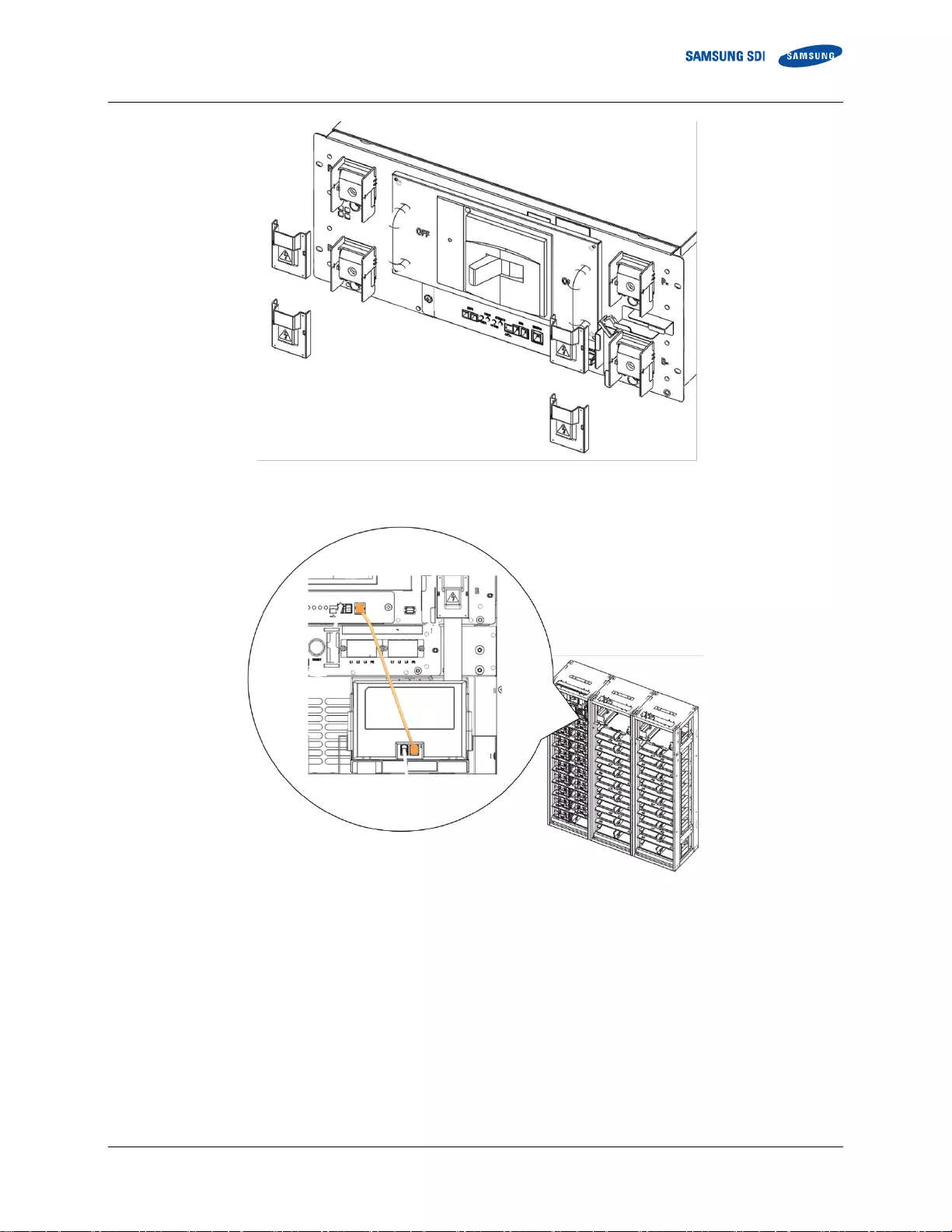
CONFIDENTIAL 5. Troubleshooting, Repair and Replacement
English 8/2019. Rev 0.0 79
Figure 5-61: B+, B-, P+, P- Terminal Connections and Terminal Covers
16. Reattach the signal cables to the Battery Module, adjacent rack, SMPS Assembly, and DC IN cable.
Figure 5-62: SMU to Module Signal Cable
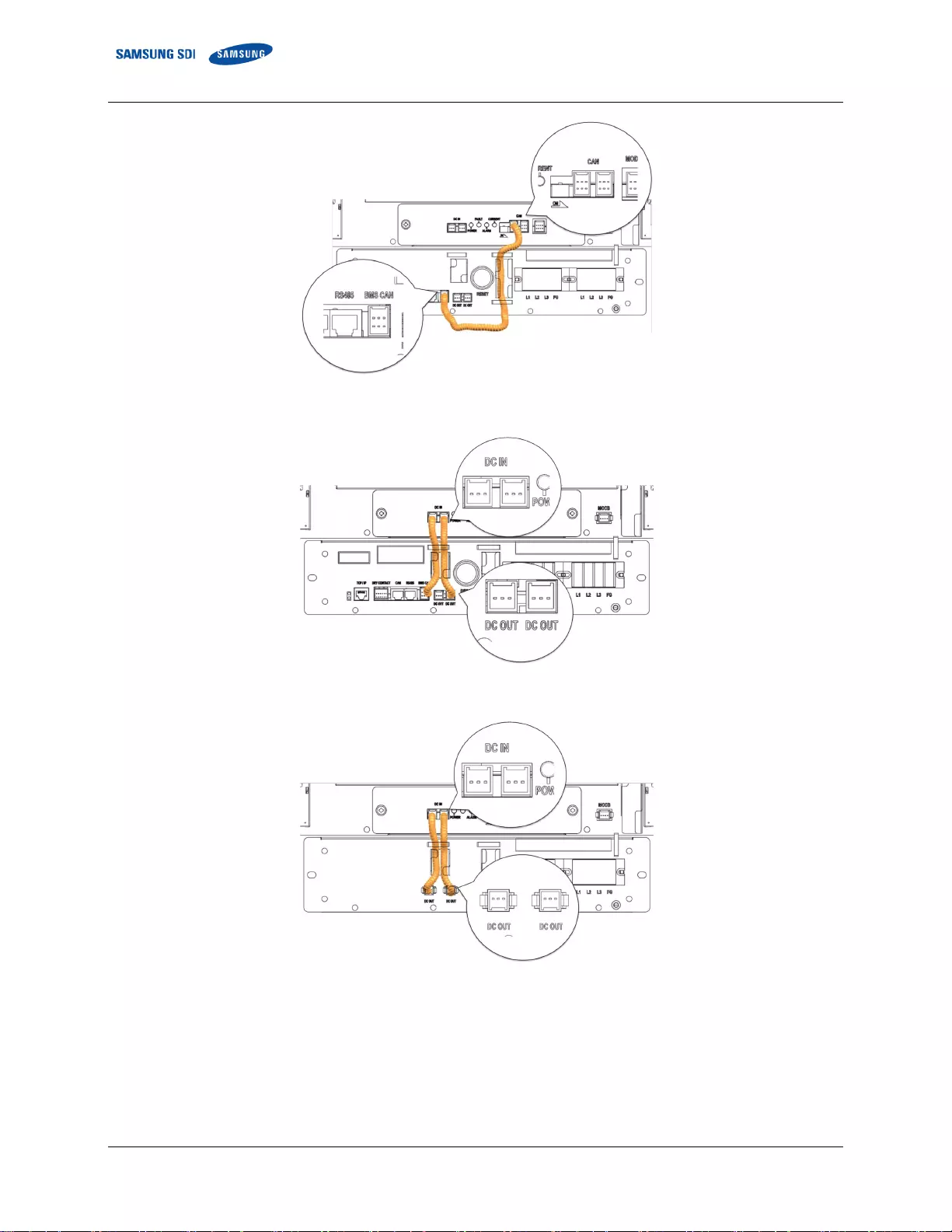
5. Troubleshooting, Repair and Replacement CONFIDENTIAL
80 English 8/2019. Rev 0.0
Figure 5-63: SMU to SMPS Assembly CAN Signal Cable
Figure 5-64: DC Power Cables from SMPS Assembly Type A to SMU
Figure 5-65: DC Power Cables from SMPS Assembly Type B to SMU
17. Check the indicator LED and make sure it is in normal status.
18. Turn the MCCB handle to “ON” position.
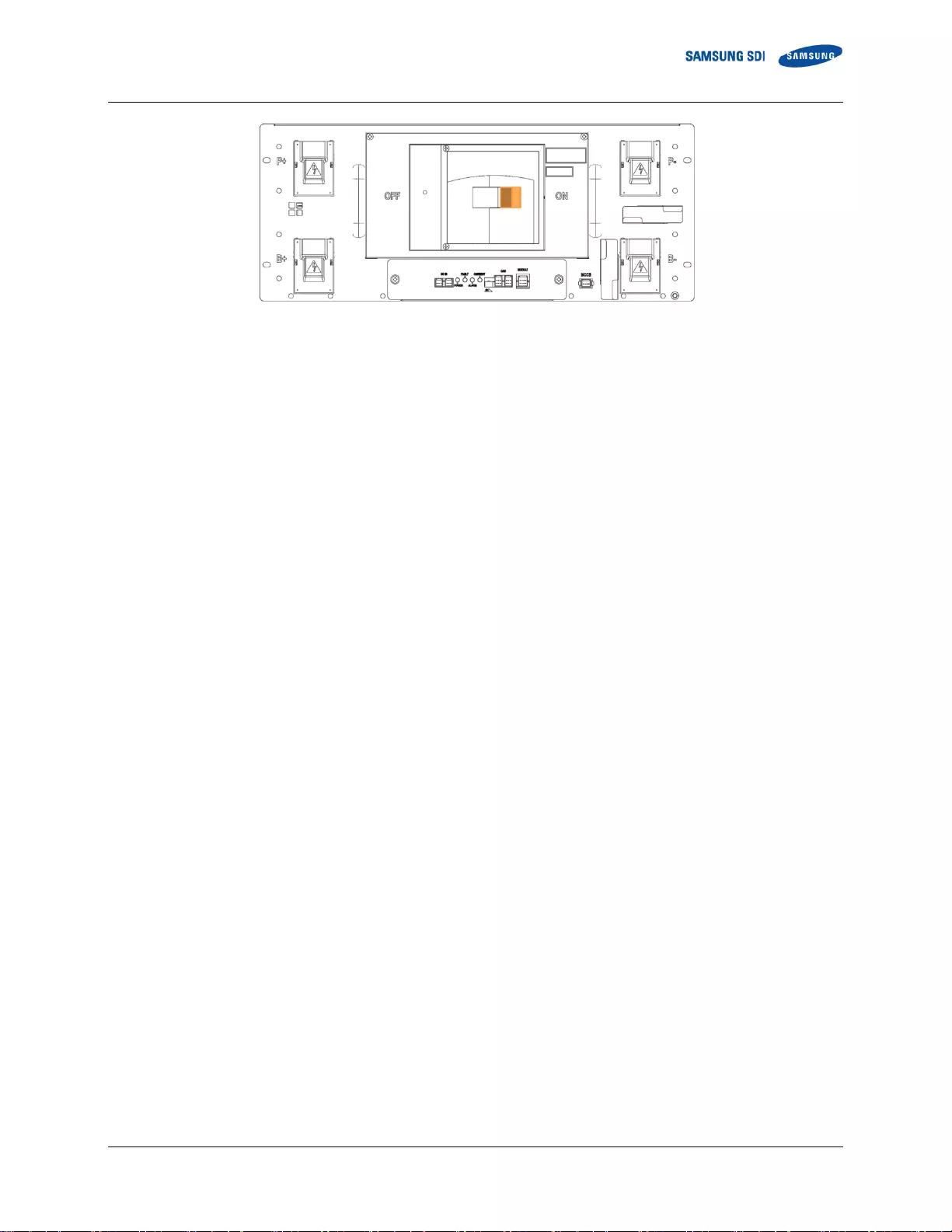
CONFIDENTIAL 5. Troubleshooting, Repair and Replacement
English 8/2019. Rev 0.0 81
Figure 5-66: MCCB Handle in “ON” Position
19. The Rack BMS in the replacement SMU must be configured according to the rack configuration. Refer to
the “Installation Manual” for details.
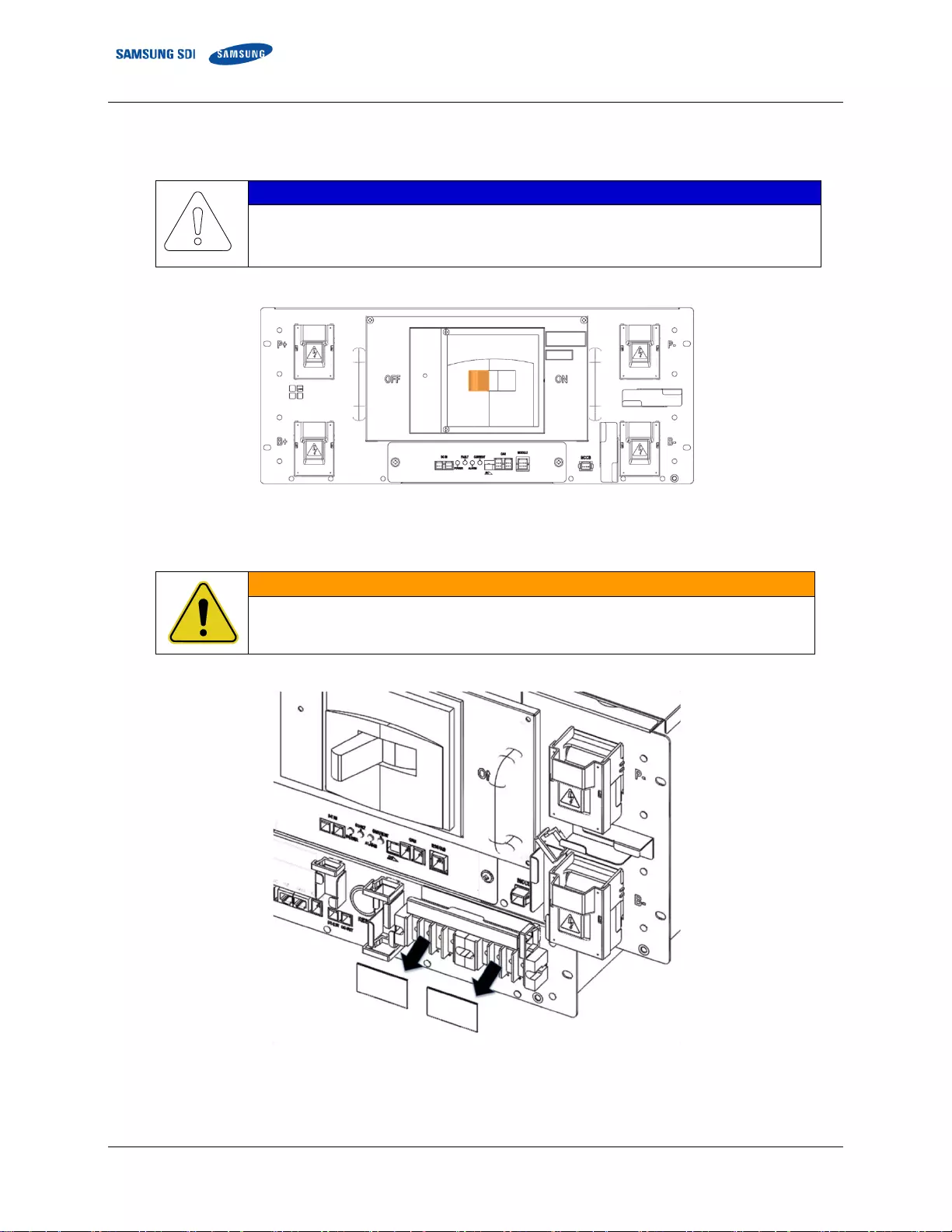
5. Troubleshooting, Repair and Replacement CONFIDENTIAL
82 English 8/2019. Rev 0.0
5.3.5 SMPS Assembly Replacement
NOTICE
SMPS Assembly 3 Phase Type A is used as a reference. Similar steps are used for SMPS
Assembly 3 Phase Type B, SMPS Assembly 1 Phase Type A and B.
1. Turn off the MCCB.
Figure 5-67: MCCB Handle in “OFF” Position
2. Turn off the AC input to the SMPS Assembly.
WARNING
Before working on the AC input terminal connections, use a voltmeter to verify that they are not
energized.
3. Remove the protective covers from the AC input terminals.
Figure 5-68: AC Input Terminals
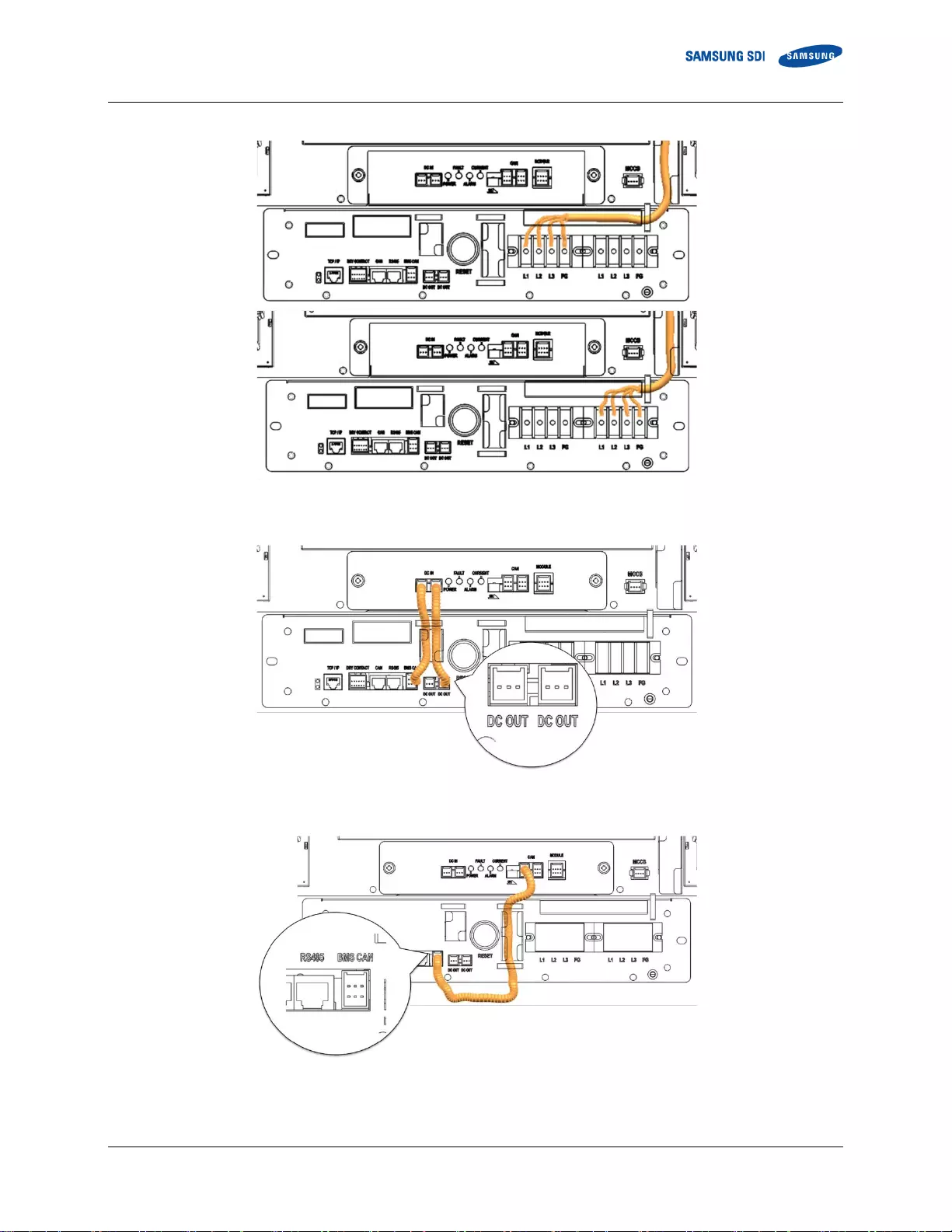
CONFIDENTIAL 5. Troubleshooting, Repair and Replacement
English 8/2019. Rev 0.0 83
4. Remove the AC input cables. Make sure the AC cables are not energized.
Figure 5-69: Cables to the AC Input Terminals
5. Remove the DC OUT connection.
Figure 5-70: DC OUT Connection
6. Remove the BMS CAN connection.
Figure 5-71: BMS CAN Connection

5. Troubleshooting, Repair and Replacement CONFIDENTIAL
84 English 8/2019. Rev 0.0
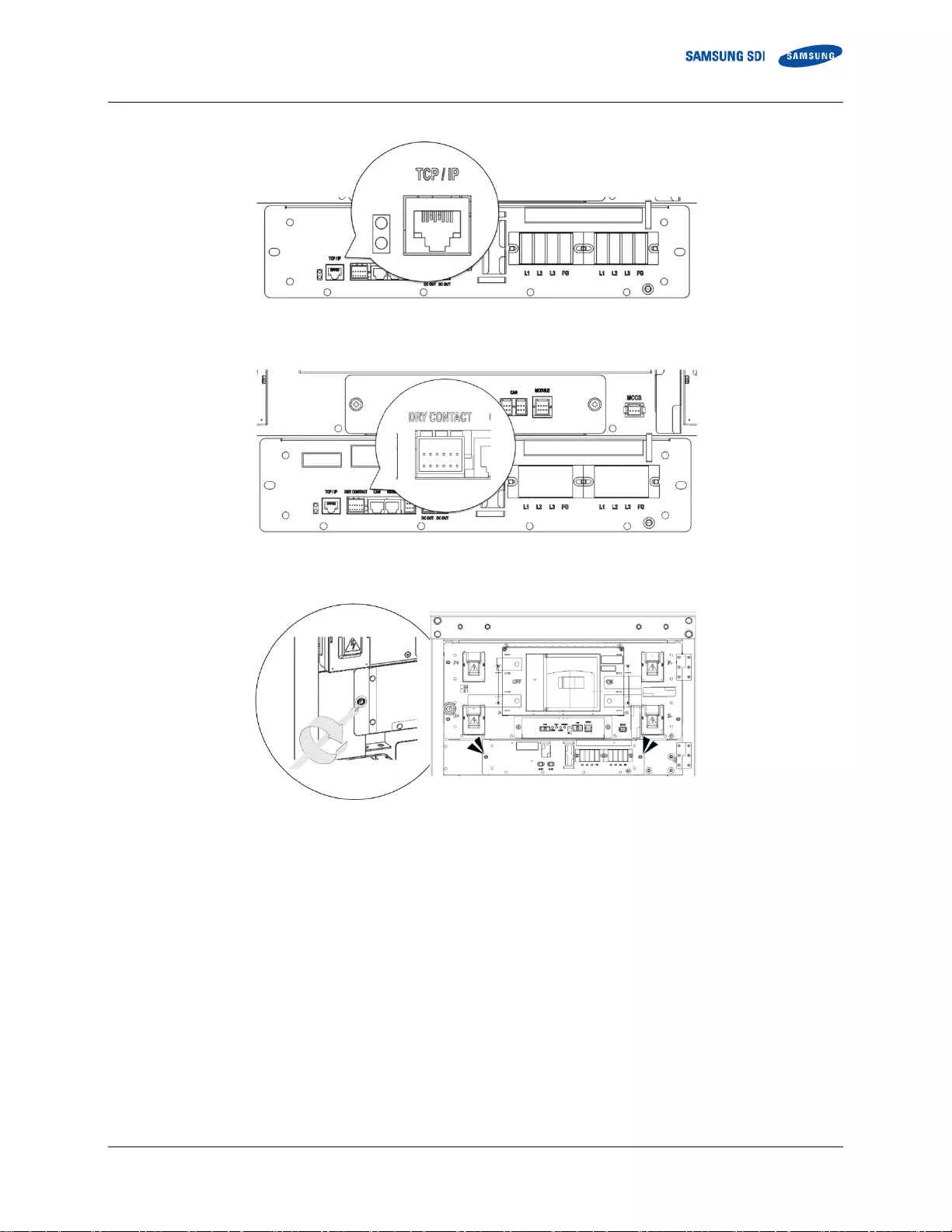
CONFIDENTIAL 5. Troubleshooting, Repair and Replacement
English 8/2019. Rev 0.0 85
7. Remove the TCP/IP connection.
Figure 5-72: TCP/IP Connection
8. Remove the dry contact connection.
Figure 5-73: Dry Contact Connection
9. Unscrew the SMPS Assembly from the rack frame.
Figure 5-74: Unscrew SMPS Assembly
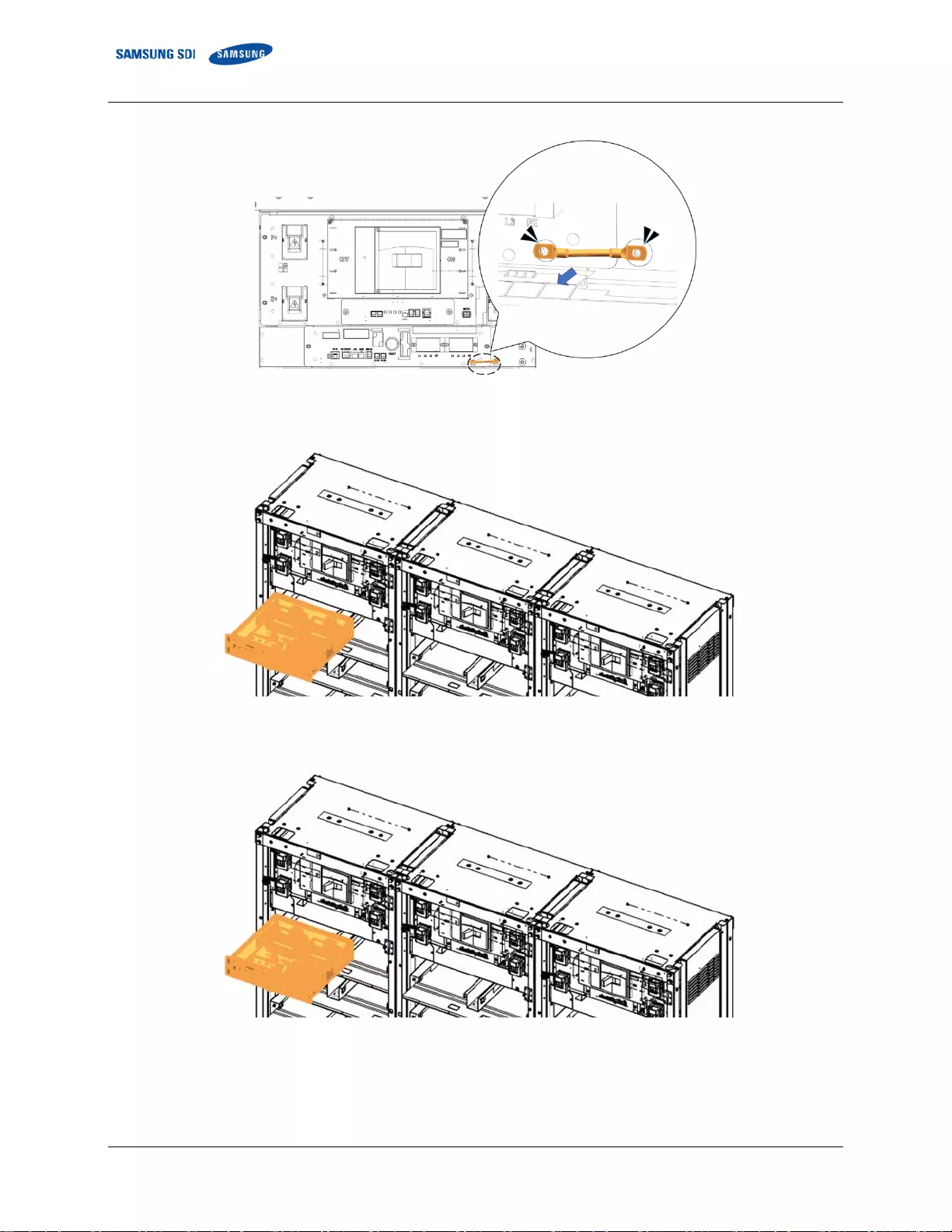
5. Troubleshooting, Repair and Replacement CONFIDENTIAL
86 English 8/2019. Rev 0.0
10. Detach the grounding cable from the rack frame.
Figure 5-75: Unscrew SMPS Assembly Grounding Cable
11. Remove the SMPS Assembly.
Figure 5-76: Remove the SMPS Assembly
12. Insert the replacement SMPS Assembly into the rack frame on the shelf designated for it.
Figure 5-77: Insert the SMPS Assembly
13. Attach the SMPS Assembly to the rack frame using screws and torque them to 5.1–6.1 Nm (50–60 kgf cm).
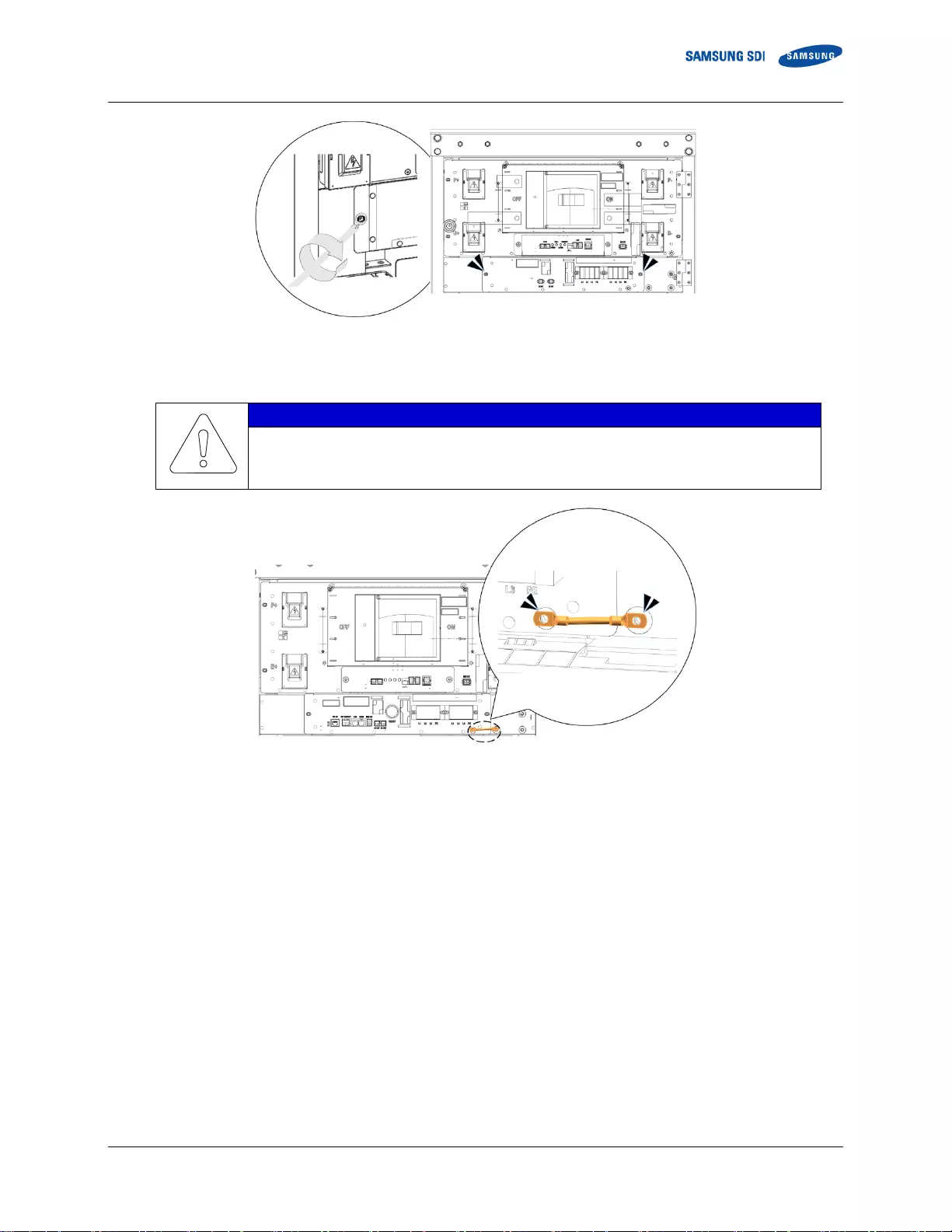
CONFIDENTIAL 5. Troubleshooting, Repair and Replacement
English 8/2019. Rev 0.0 87
Figure 5-78: Screw on the SMPS Assembly
14. Connect the ground cable to the SMPS Assembly.
NOTICE
Connect a ground cable between the SMPS Assembly and the Rack Frame using SCREW M5 x
10L. Torque the screw to 5.1–6.1 Nm (50–60 kgf cm).
Double-check that the torque setting is correct.
Figure 5-79: Screw on the SMPS Assembly Grounding Cable
15. Connect the SMU DC power cables.
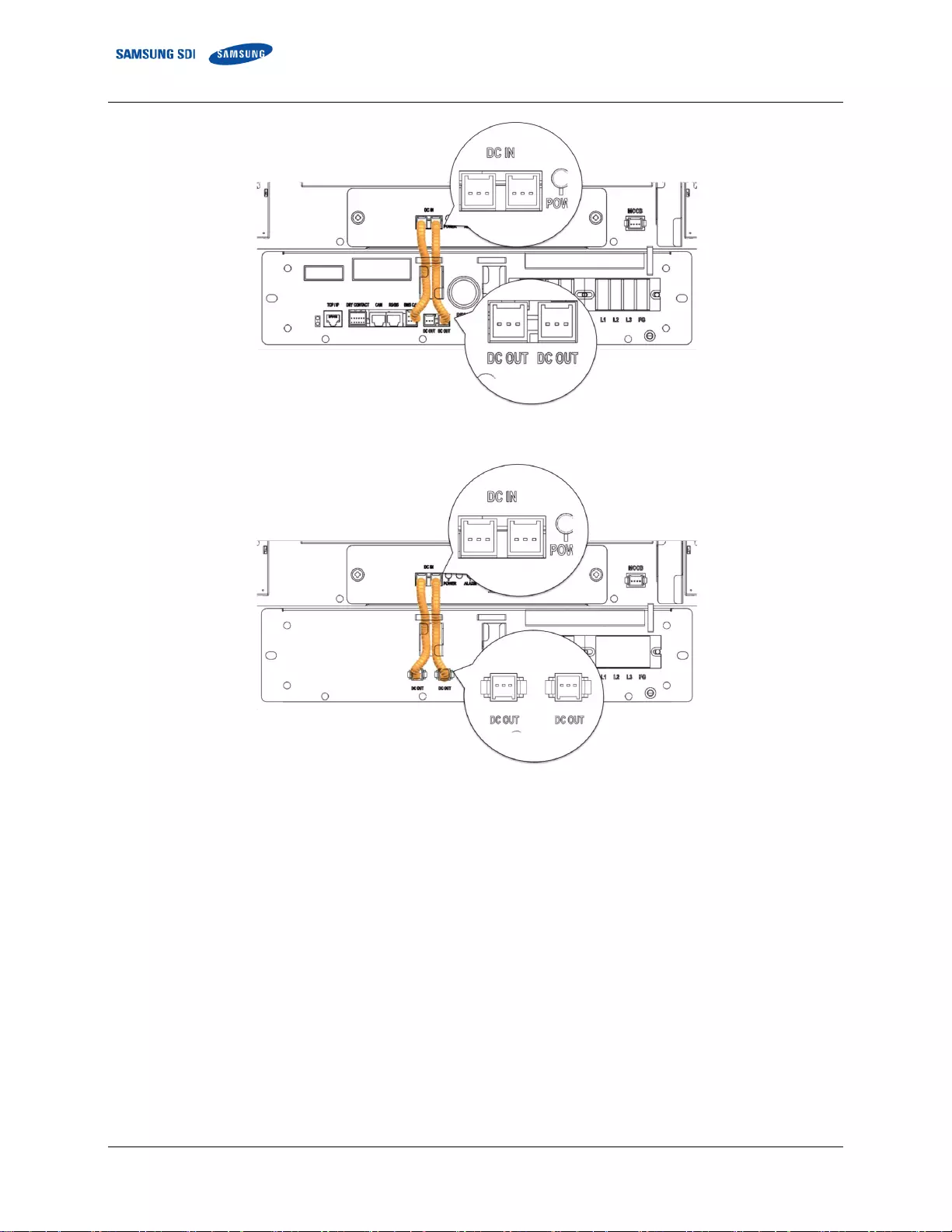
5. Troubleshooting, Repair and Replacement CONFIDENTIAL
88 English 8/2019. Rev 0.0
Figure 5-80: DC Power Cables from SMPS Assembly Type A to SMU
Figure 5-81: DC Power Cables from SMPS Assembly Type B to SMU
16. Connect the signal cable from the SMPS Assembly to the SMU “WIRE ASSY RACK TO SYSTEM.”
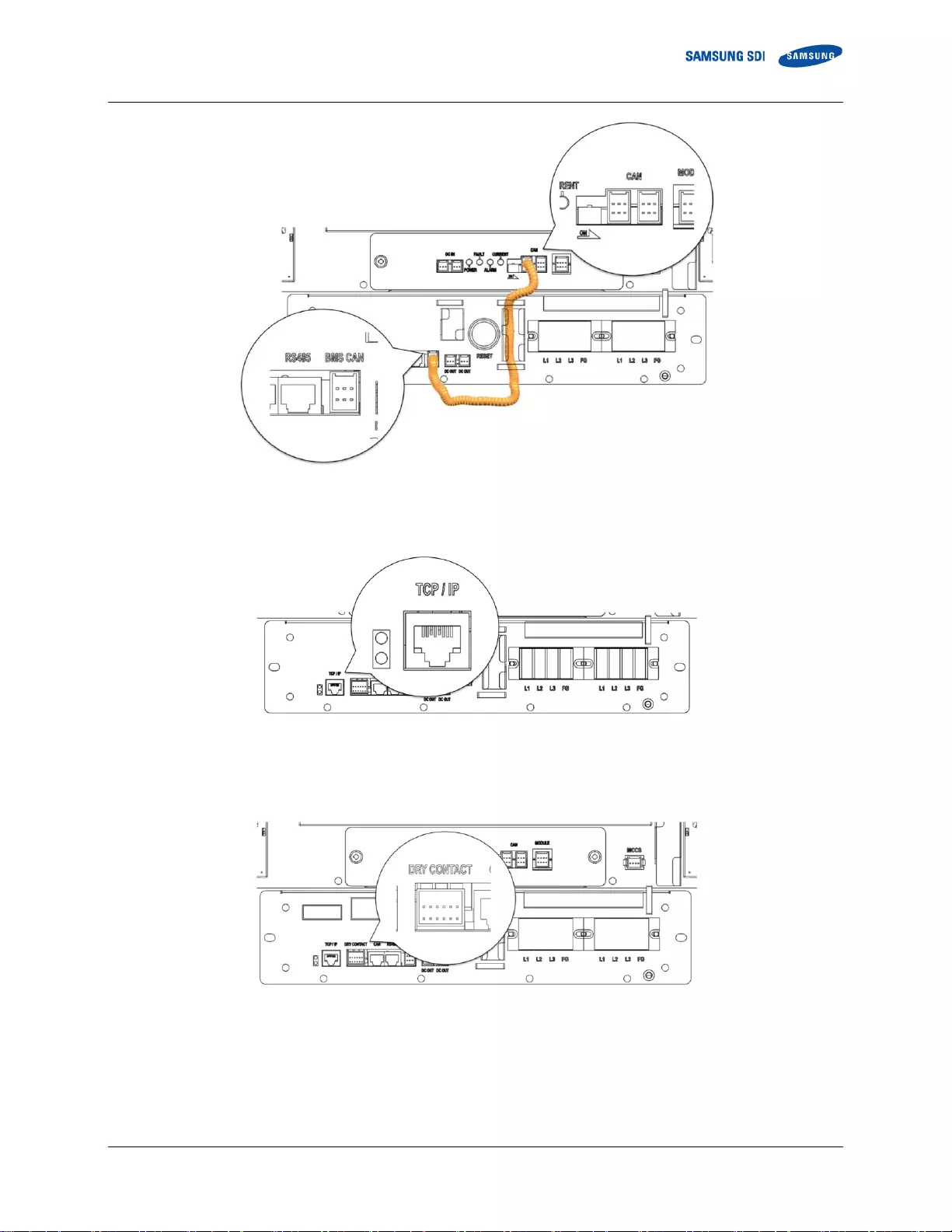
CONFIDENTIAL 5. Troubleshooting, Repair and Replacement
English 8/2019. Rev 0.0 89
Figure 5-82: BMS CAN Cable from SMPS Assembly to SMU
17. Connect the TCP/IP Cable.
Figure 5-83: TCP/IP Cable
18. Connect the dry contact cable.
Figure 5-84: Dry Contact Cable
19. Remove the protective covers from the AC input terminals.
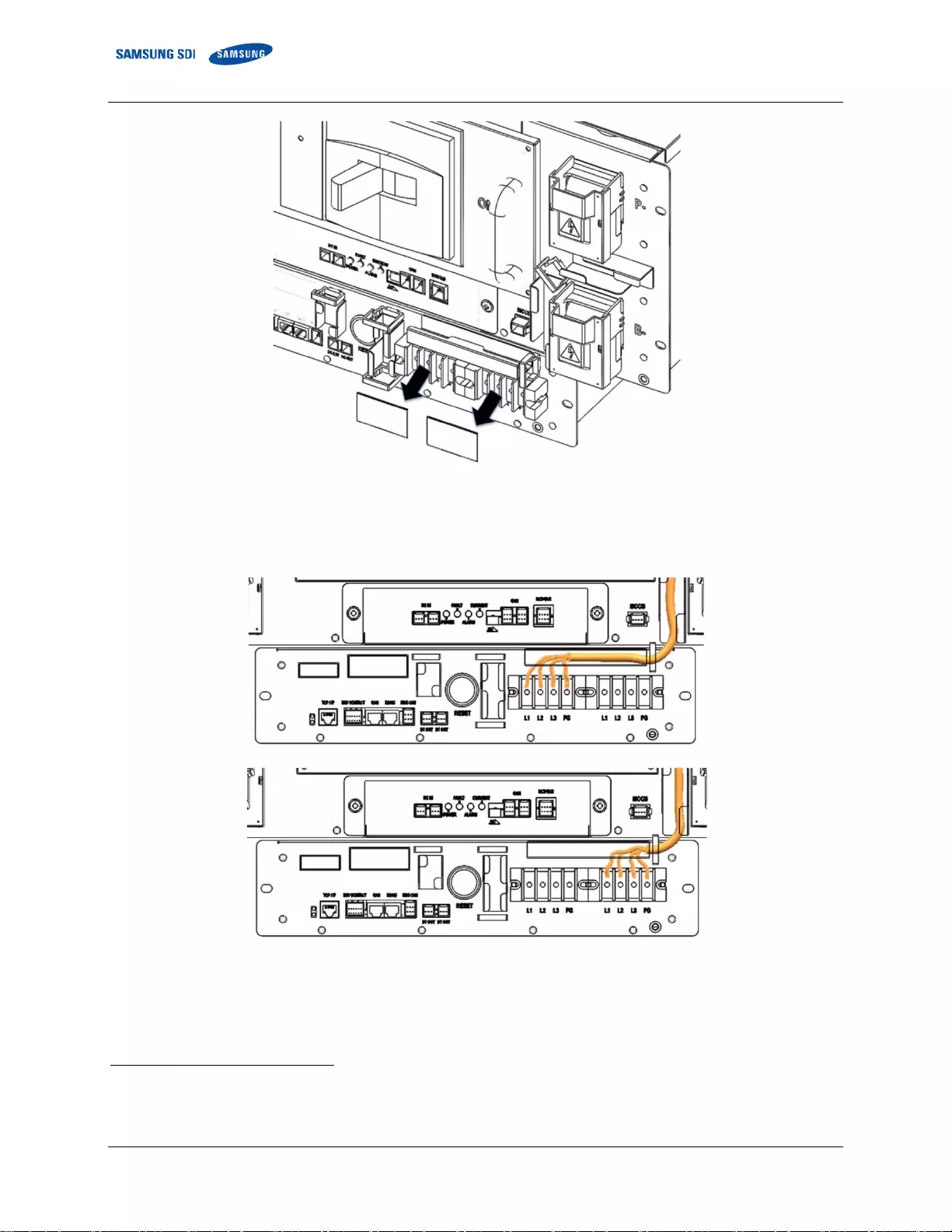
5. Troubleshooting, Repair and Replacement CONFIDENTIAL
90 English 8/2019. Rev 0.0
Figure 5-85: AC Input Terminals
20. Connect each AC input in the SMPS Assembly. Make sure the AC cables are not energized.
1
Figure 5-86: AC Input Terminals with Cables Attached
21. Reattach the protective covers to the AC input terminals.
1
AC cables are not provided. They must be provided by the installer or customer.
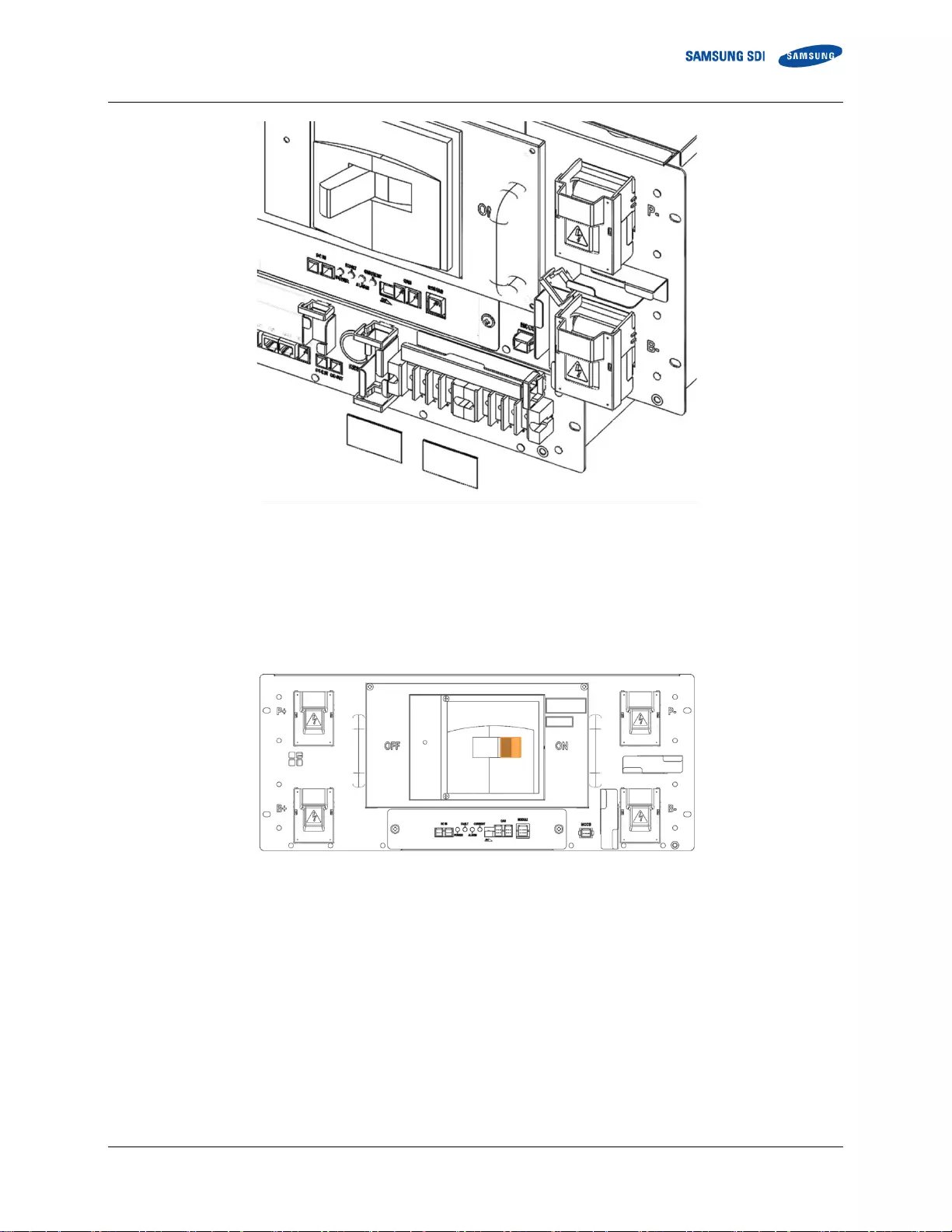
CONFIDENTIAL 5. Troubleshooting, Repair and Replacement
English 8/2019. Rev 0.0 91
Figure 5-87: AC Input Terminals Protective Cover
22. Turn on the AC input to the SMPS Assembly.
23. Check the indicator LED and make sure it is in normal status.
24. Turn the MCCB handle to the “ON” position.
Figure 5-88: MCCB Handle in “ON” Position
25. For SMPS Assembly Type A, the System BMS inside the replacement SMU must be configured according to
the battery system configuration. Refer to the installation manual for details.
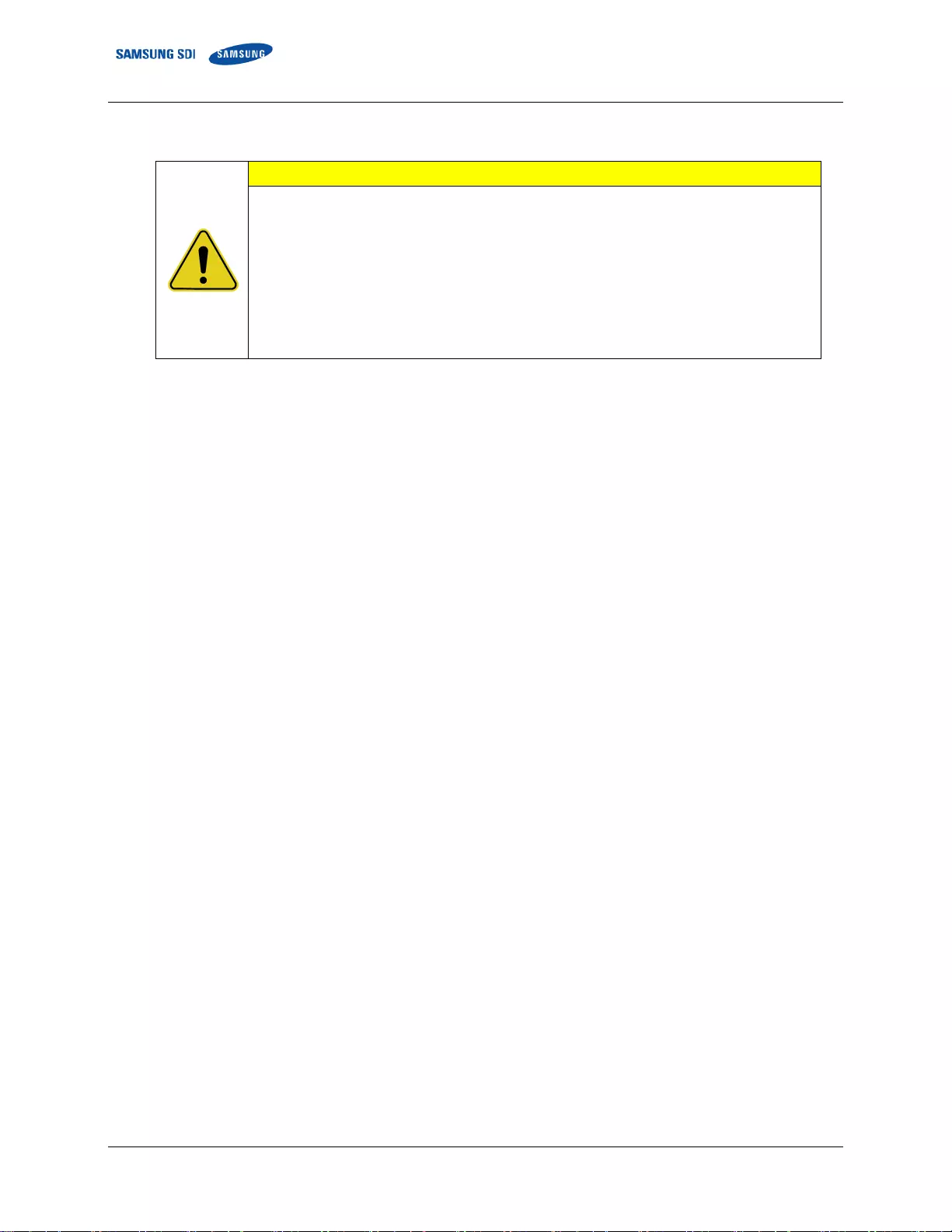
5. Troubleshooting, Repair and Replacement CONFIDENTIAL
92 English 8/2019. Rev 0.0
5.3.6 Module BMS Replacement
CAUTION
Follow the instructions exactly to protect the Module BMS and Battery Module from damage.
DO NOT deviate from the sequence of the steps below.
The voltage of the connected system increases proportionally as battery modules are
connected. Exercise extreme caution to prevent the terminals from touching anything other
than their intended mounting points.
Exercise extreme caution to prevent terminals and wires from contacting a wire or terminal
with the opposite polarity.
Do not permit either battery terminal to contact the rack frame because it is possible to contact
a connection with the opposite polarity.
1. Remove the wire harnesses that are connected to the signal connectors.
2. Remove the front cover of the battery module
3. Disconnect the voltage and temperature sensing connectors.
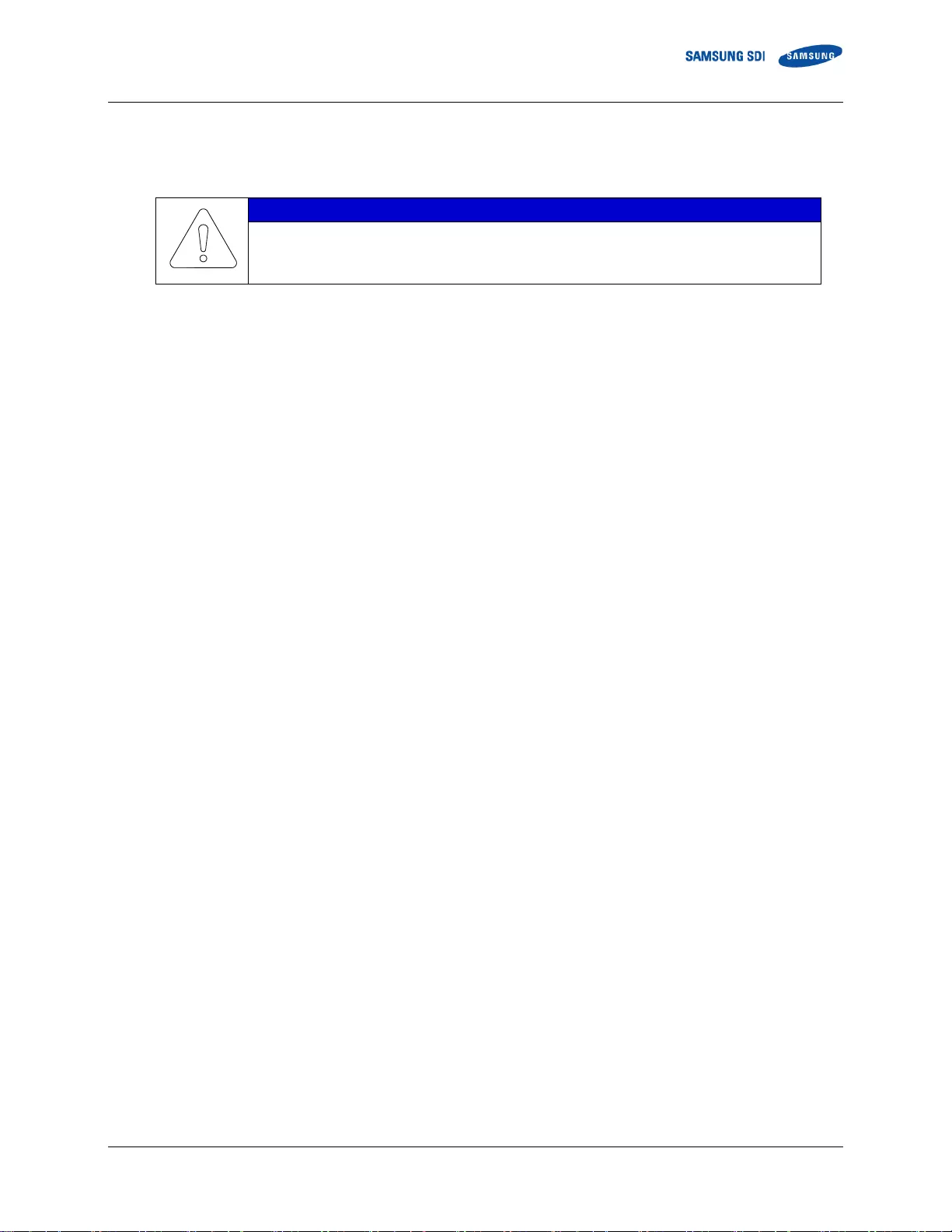
CONFIDENTIAL 5. Troubleshooting, Repair and Replacement
English 8/2019. Rev 0.0 93
4. Remove the two screws on the Module BMS
5. Lift the Module BMS from the battery module.
NOTICE
Four hooking points hold the Module BMS in place. Use care when removing and installing the
Module BMS to prevent the hooks from damage.
6. Reverse the steps above to replace the Module BMS.

6. Appendix CONFIDENTIAL
94 English 8/2019. Rev 0.0
6. Appendix
6.1 Disposal and Recycling
For recycling, contact the manufacturer.
Contaminated packaging must be disposed in accordance with local regulations.

CONFIDENTIAL
English 8/2019. Rev 0.0 95
Memo

CONFIDENTIAL
96 English 8/2019. Rev 0.0
Memo

CONFIDENTIAL
English 8/2019. Rev 0.0 97
Memo

98 English 8/2019. Rev 0.0
www.SamsungSDI.com